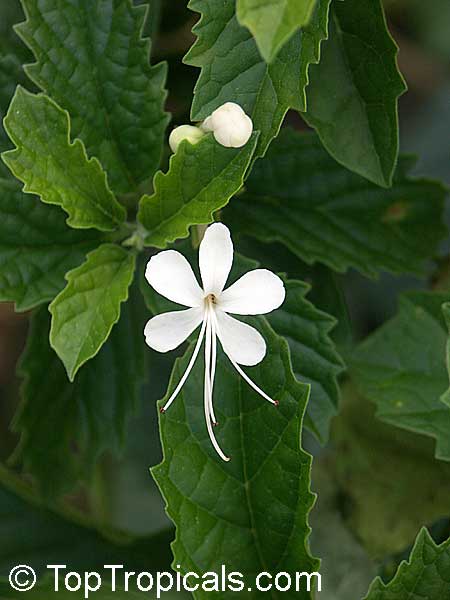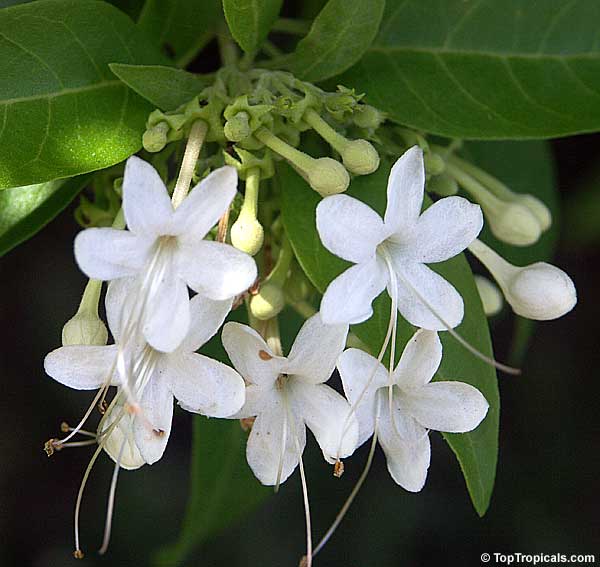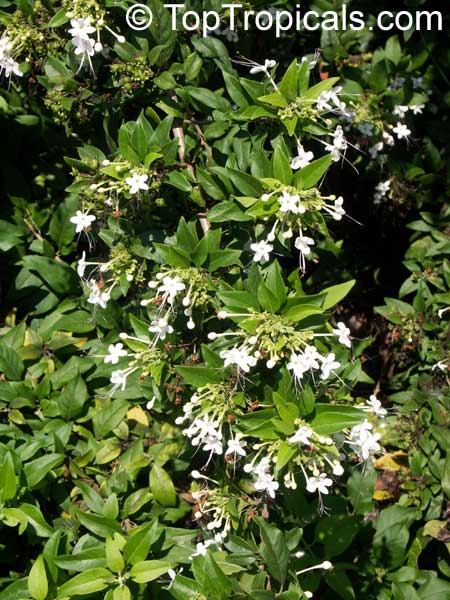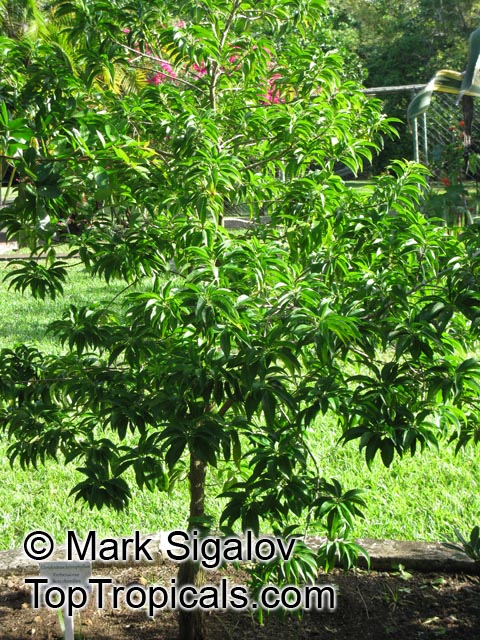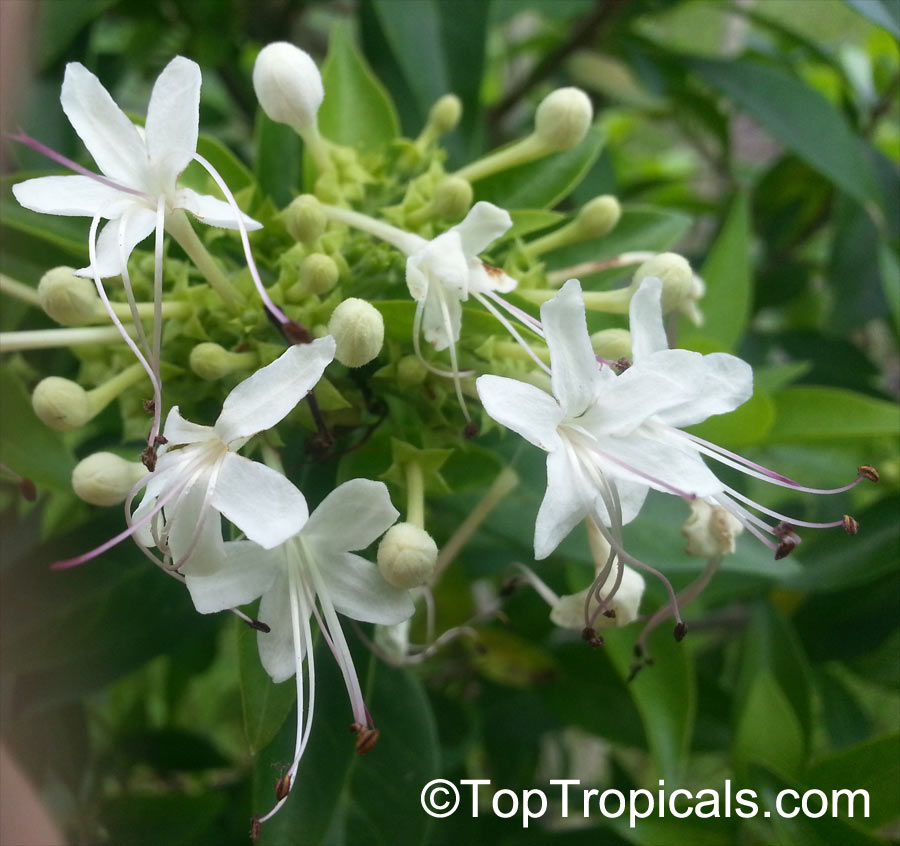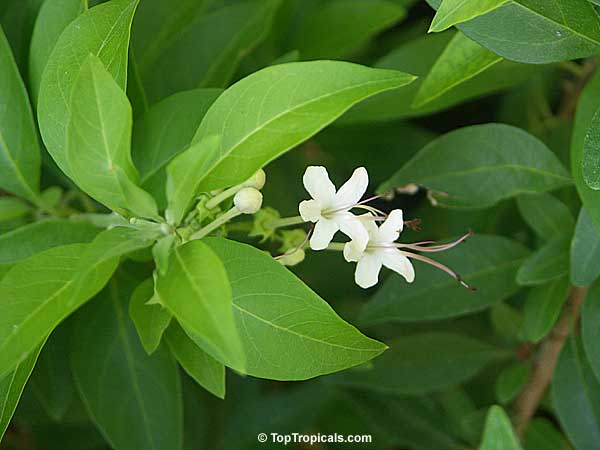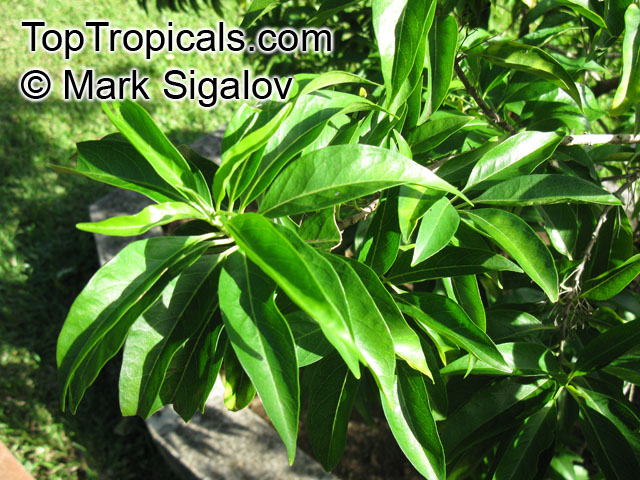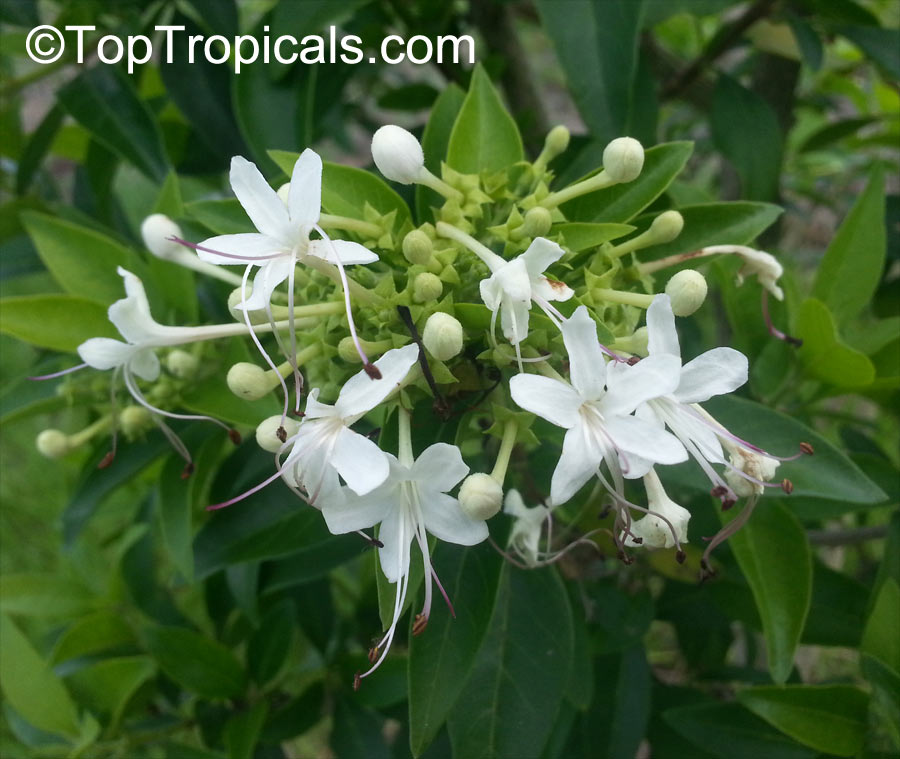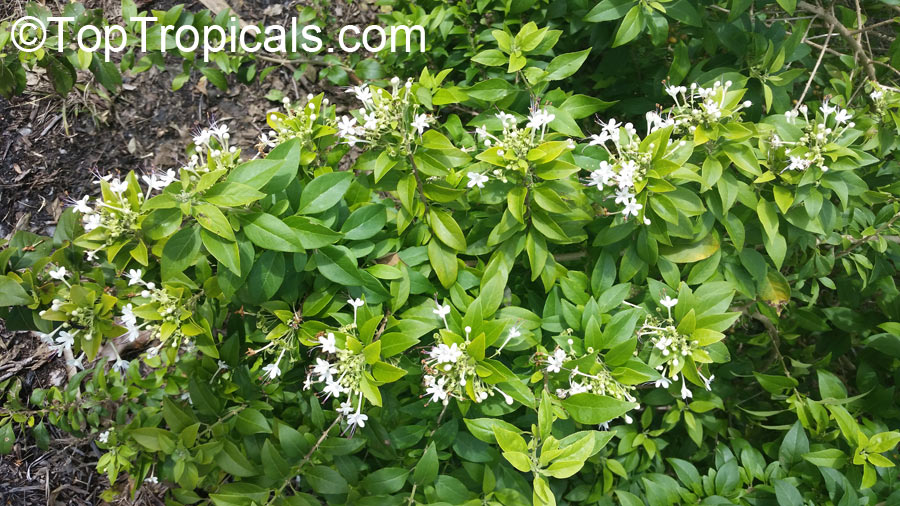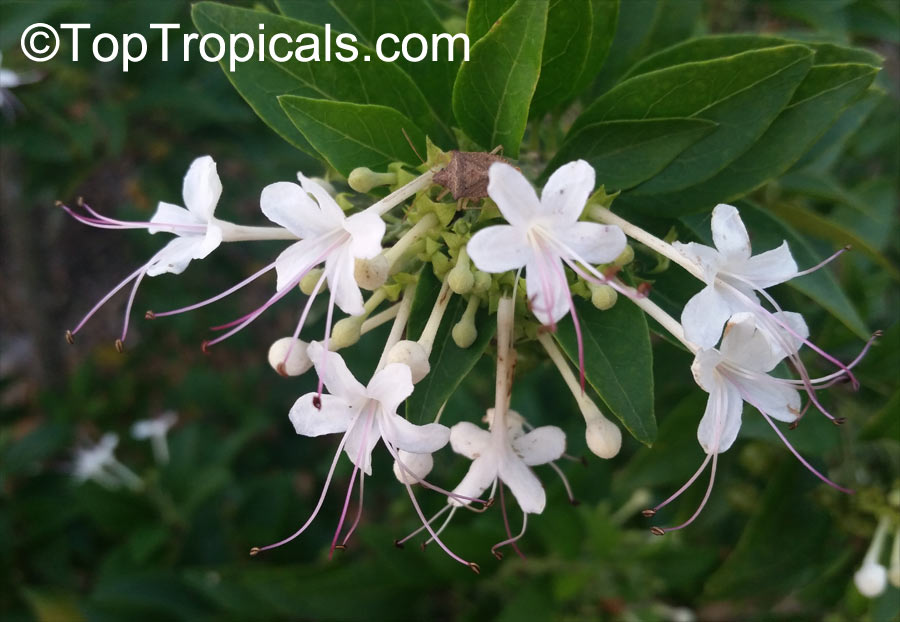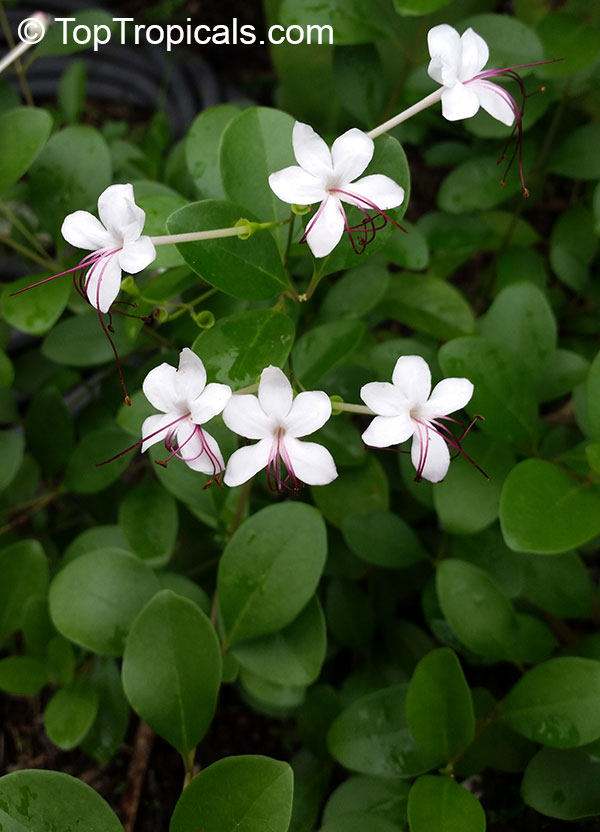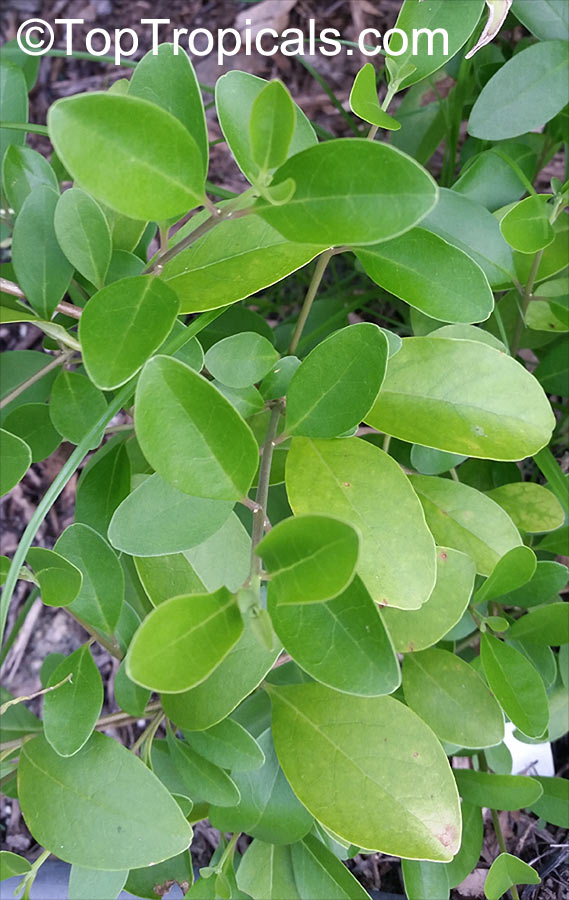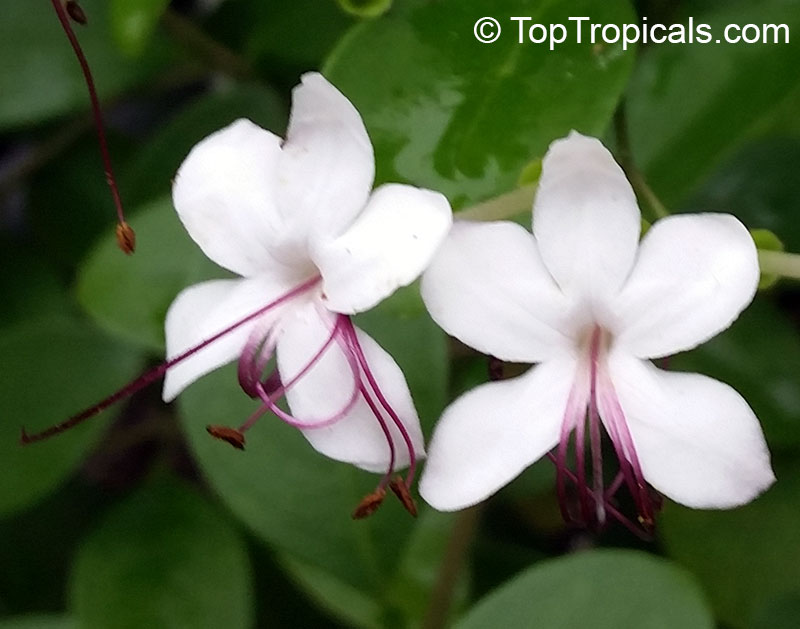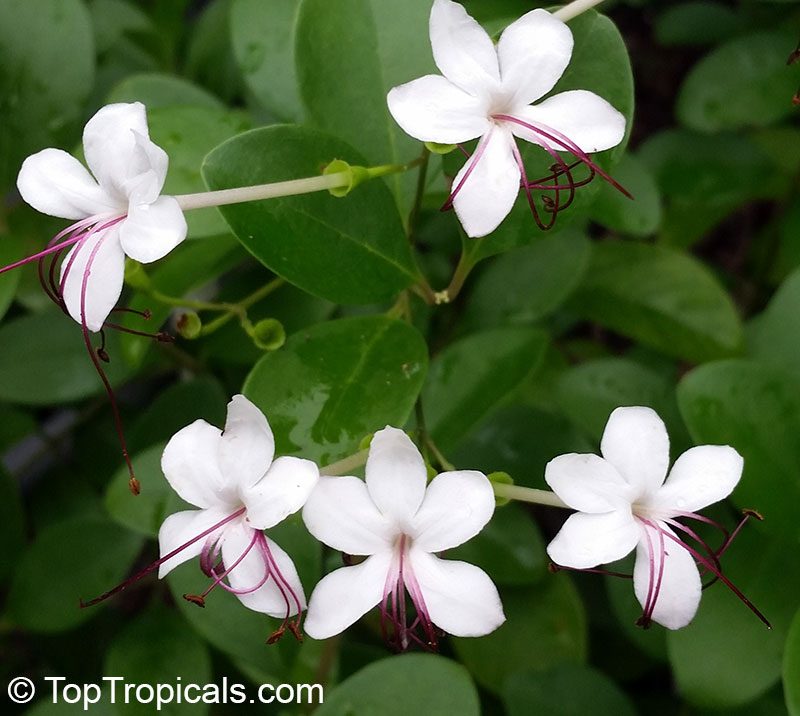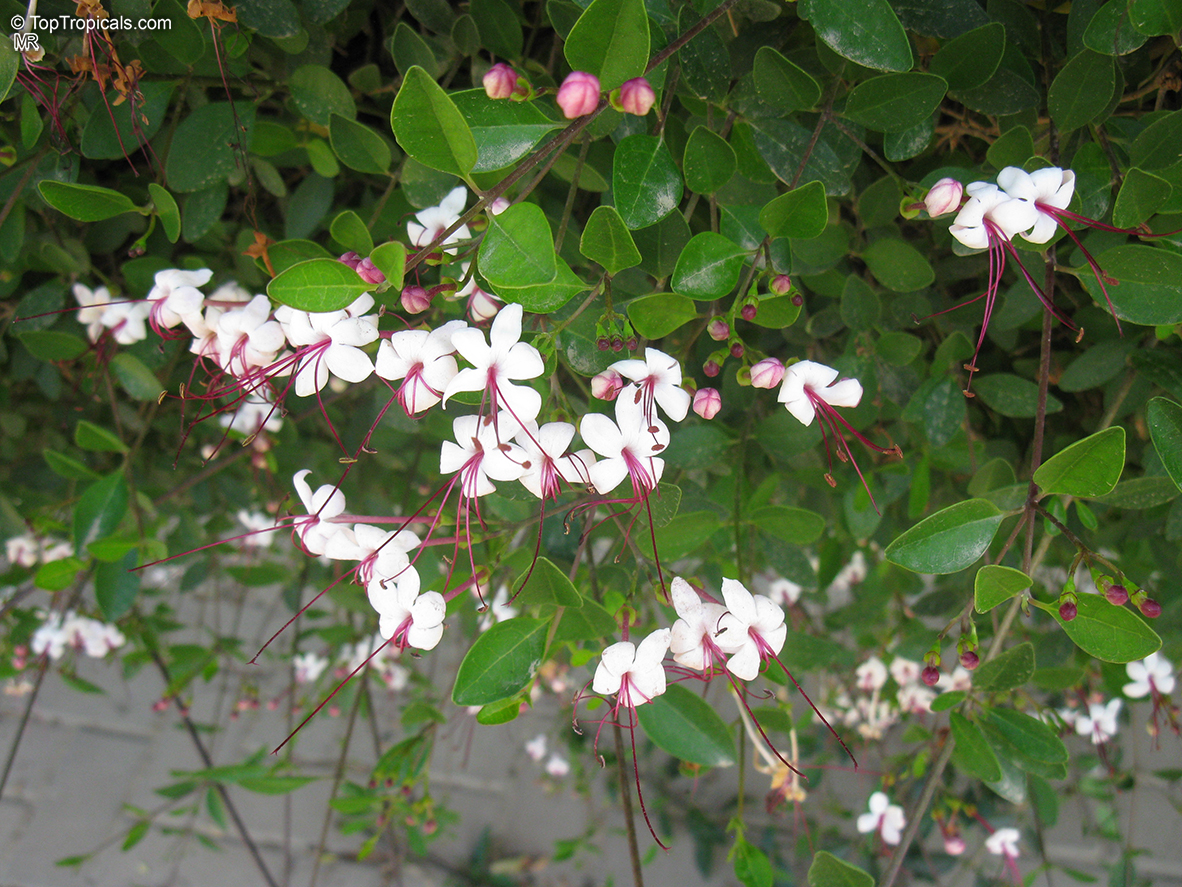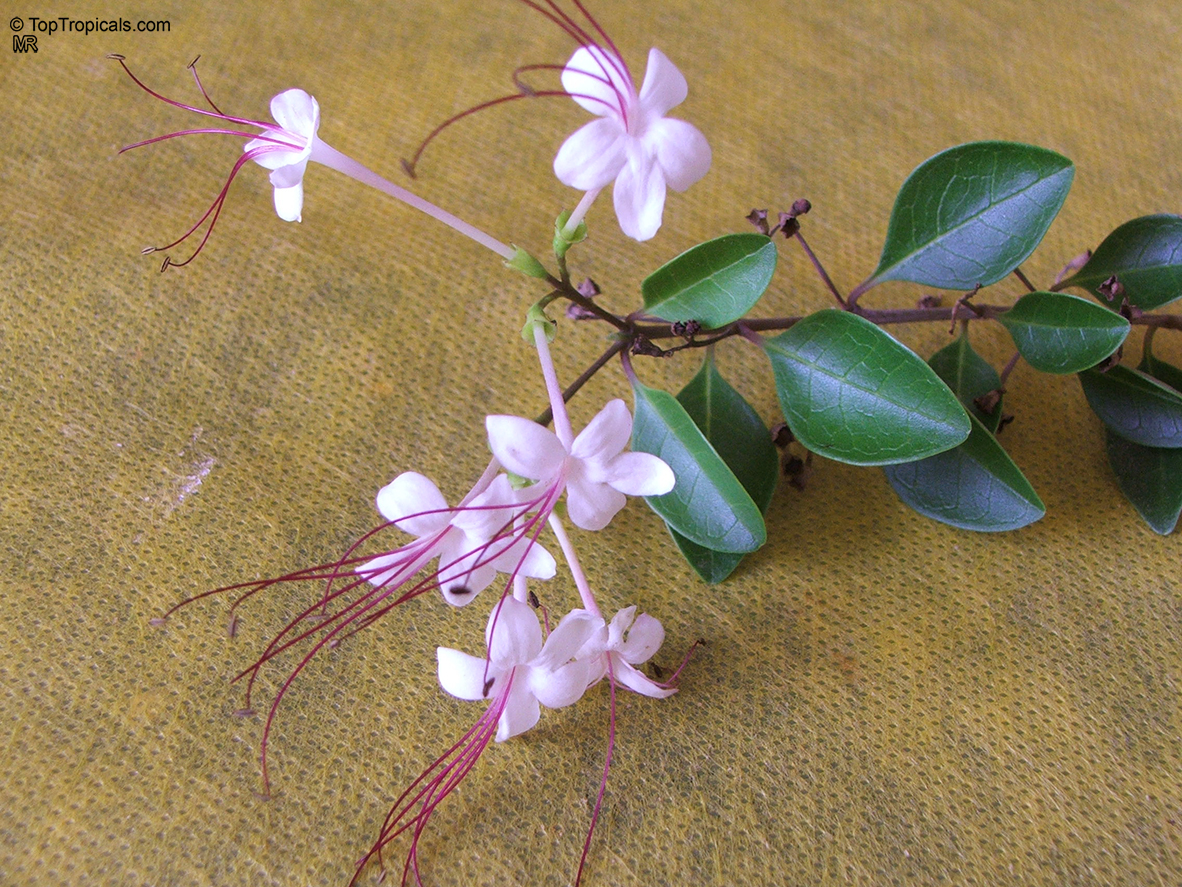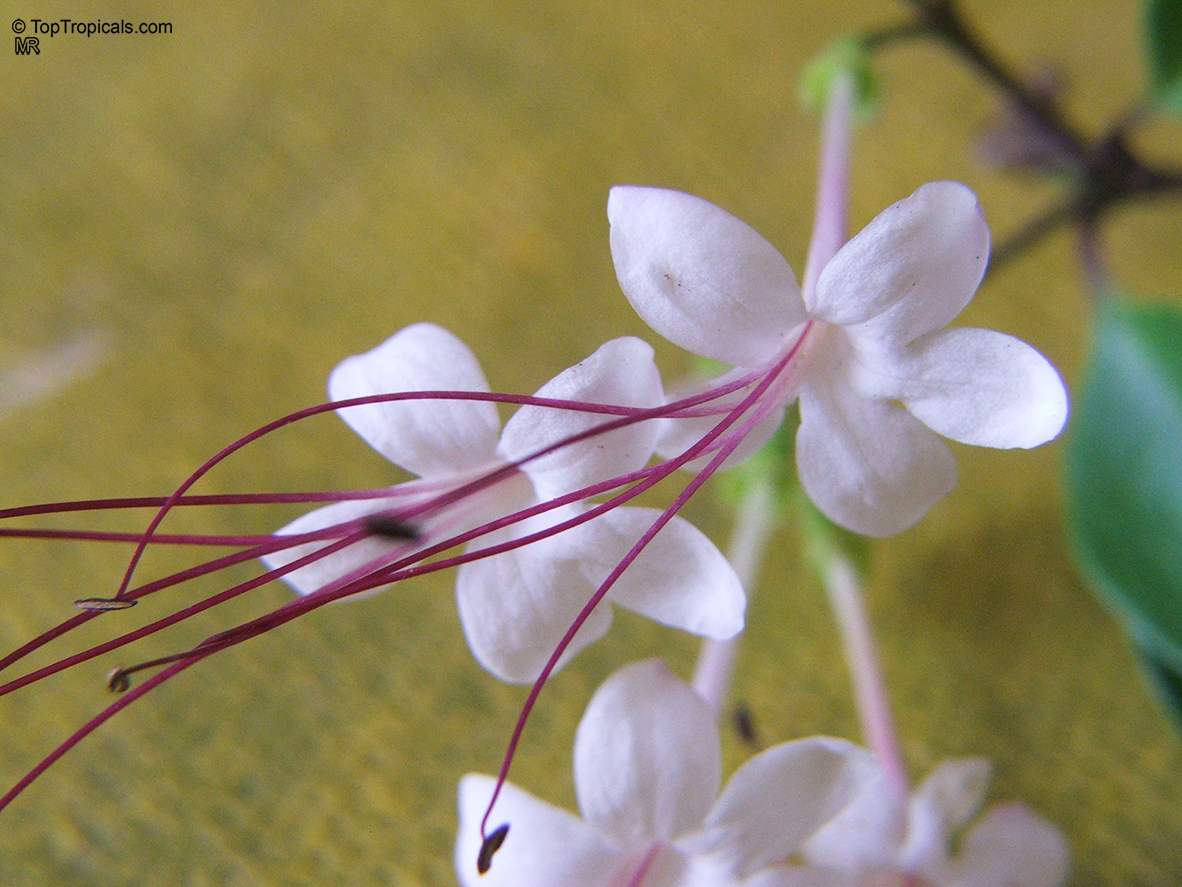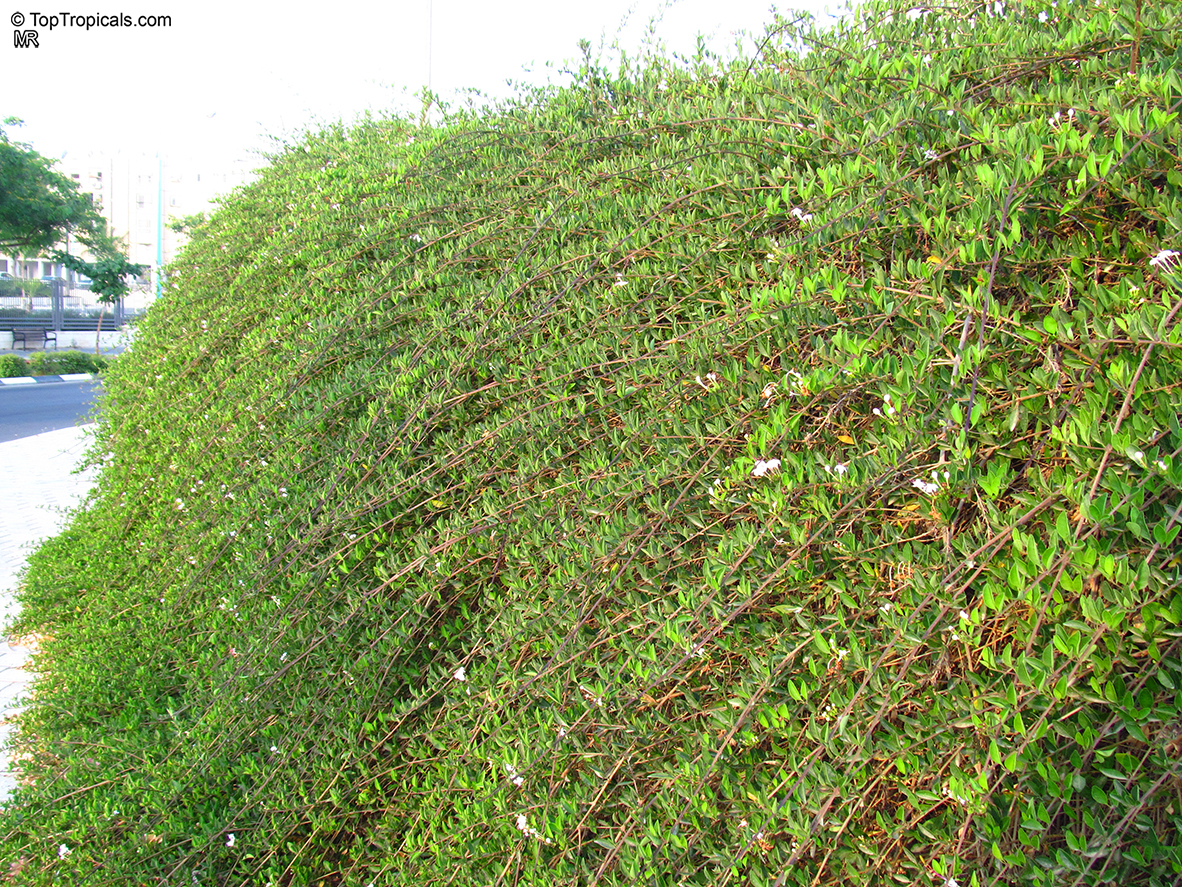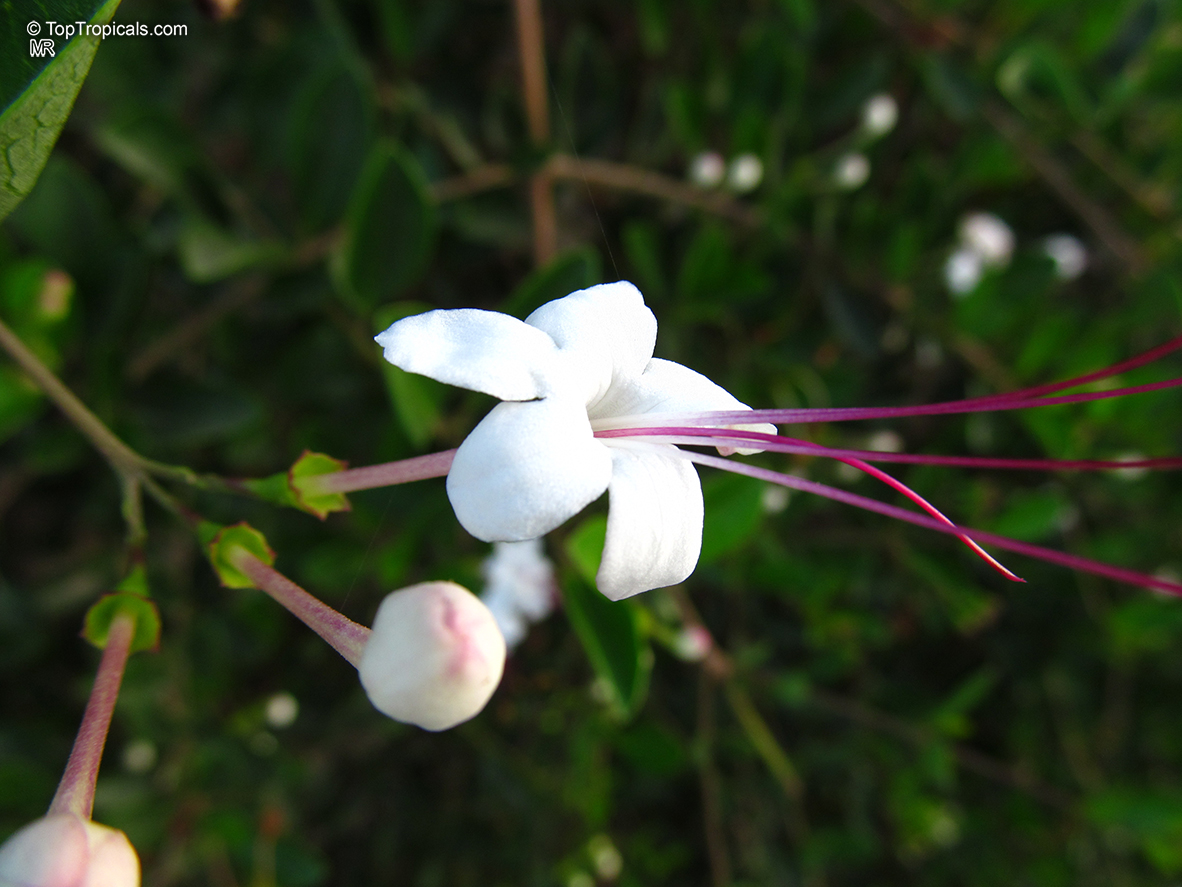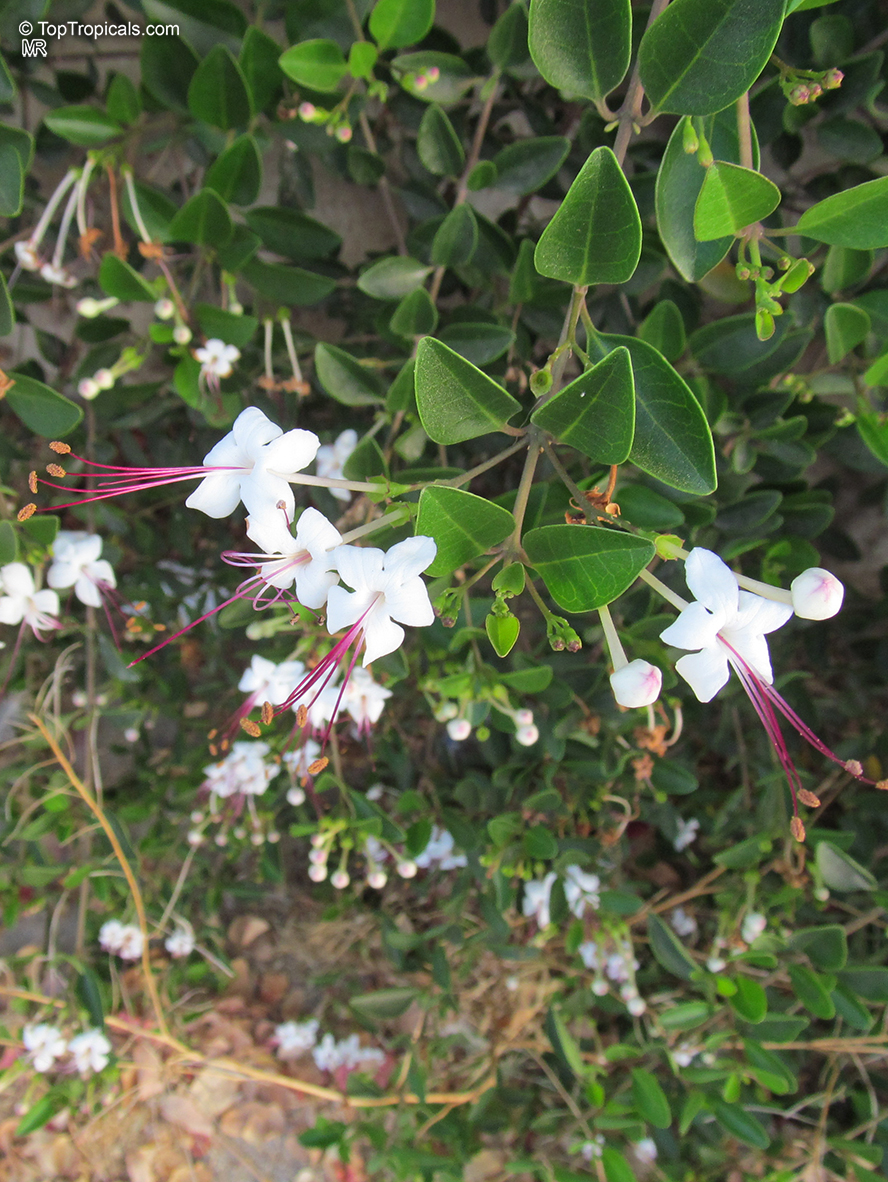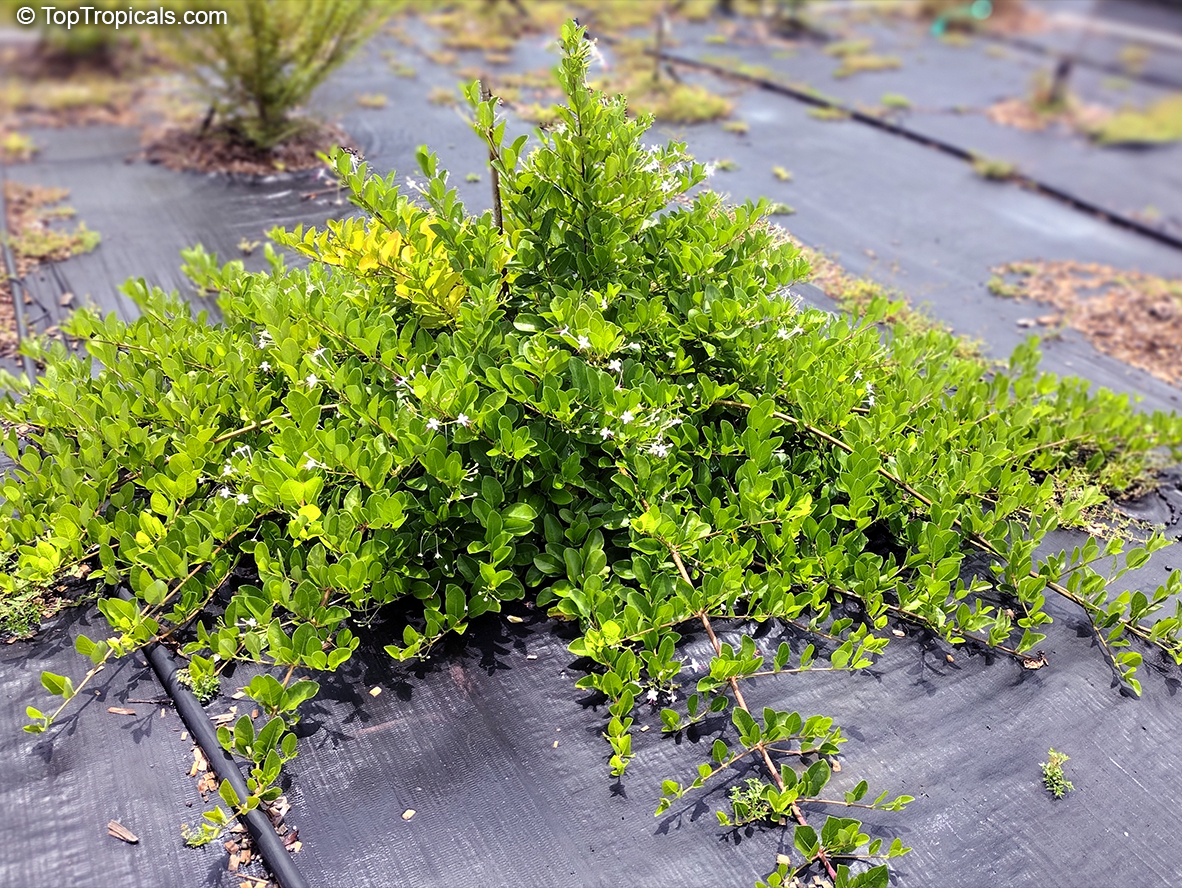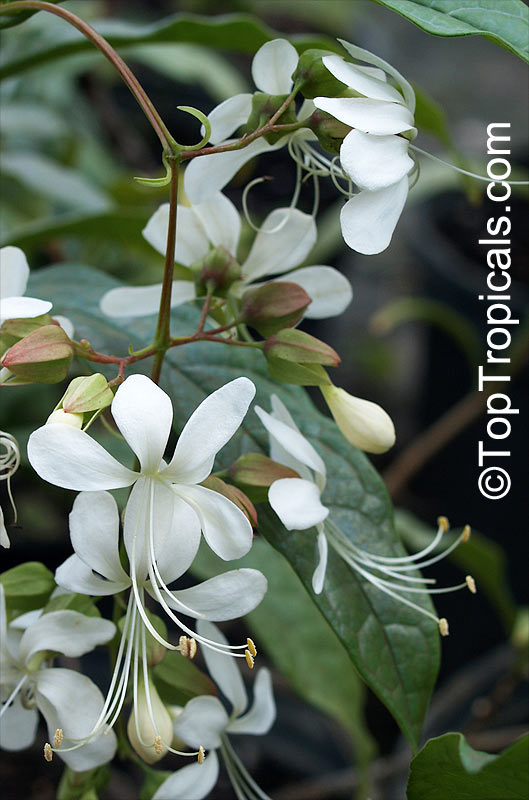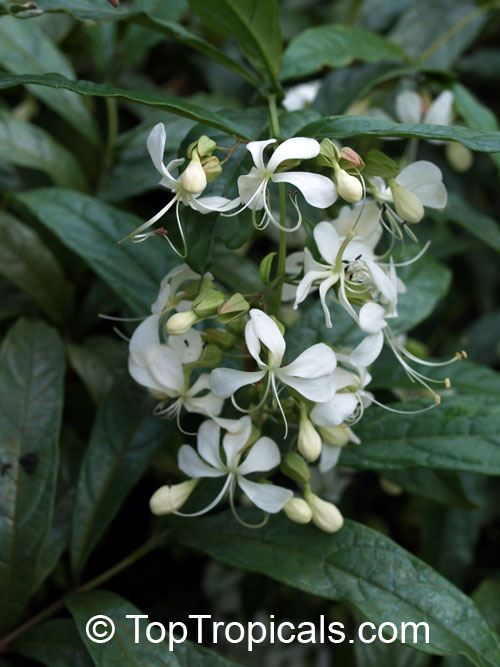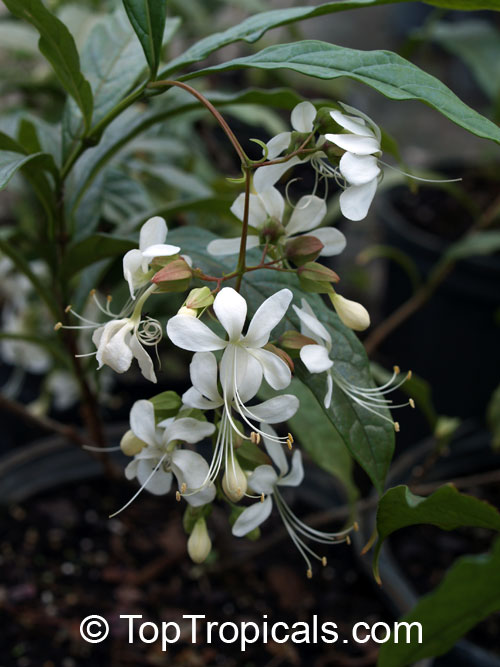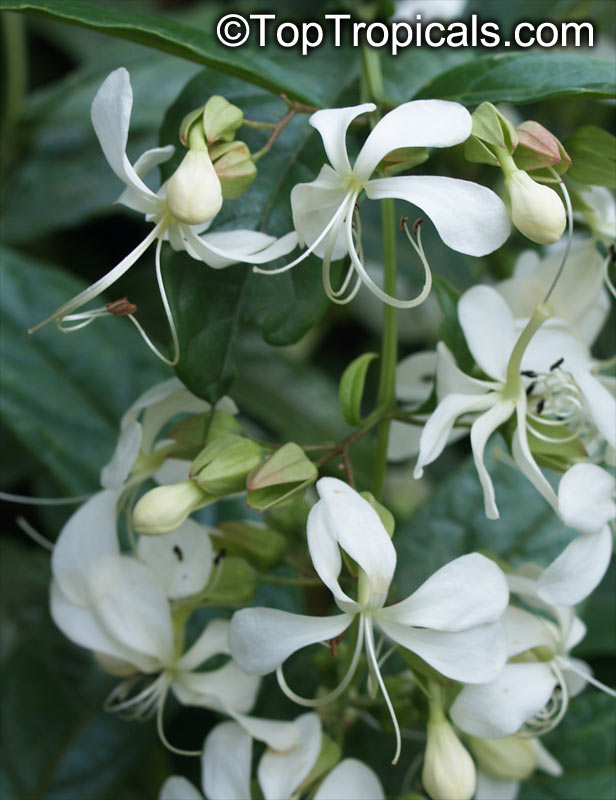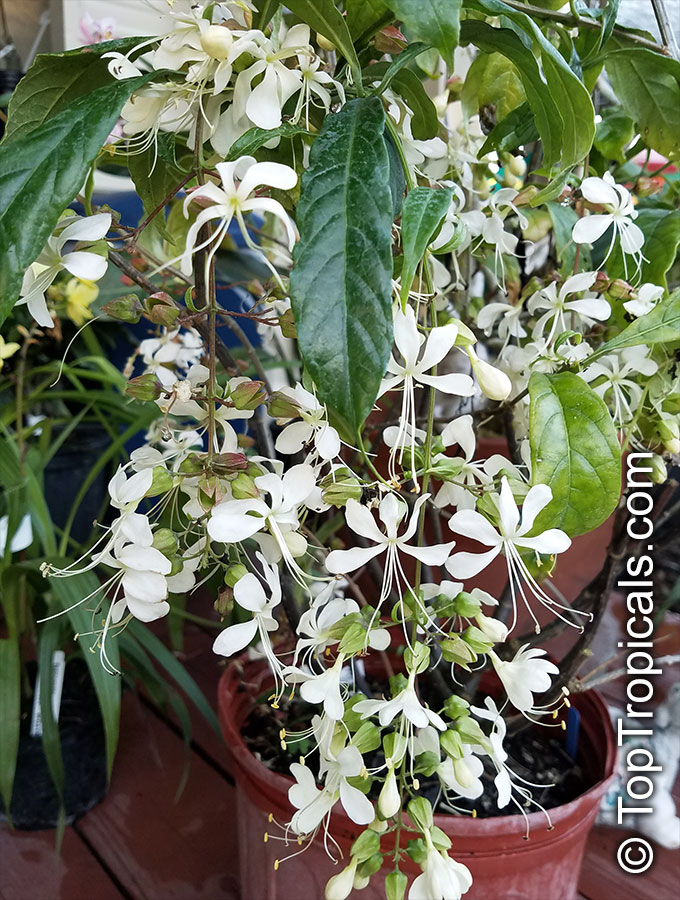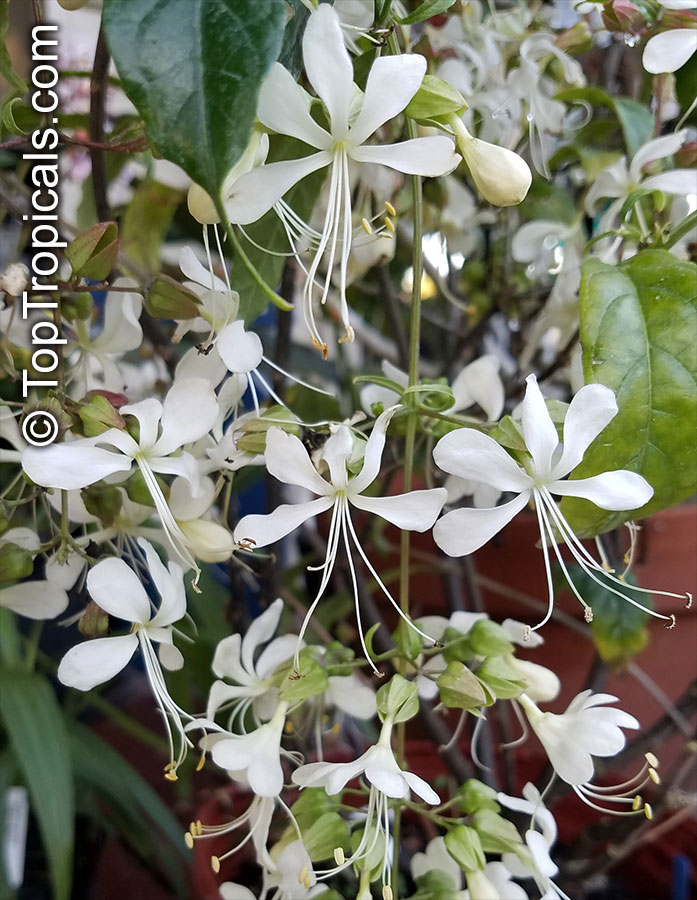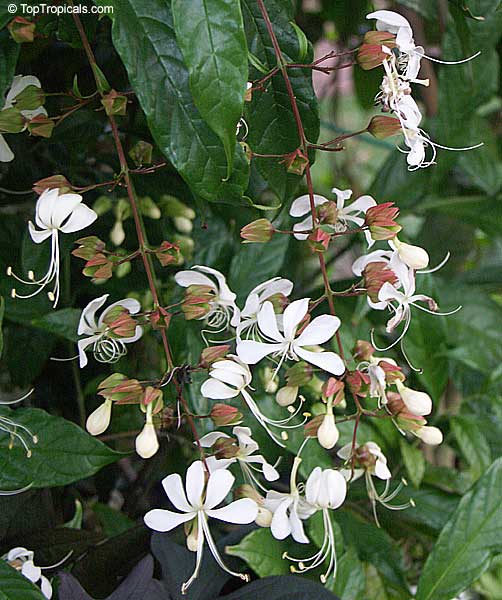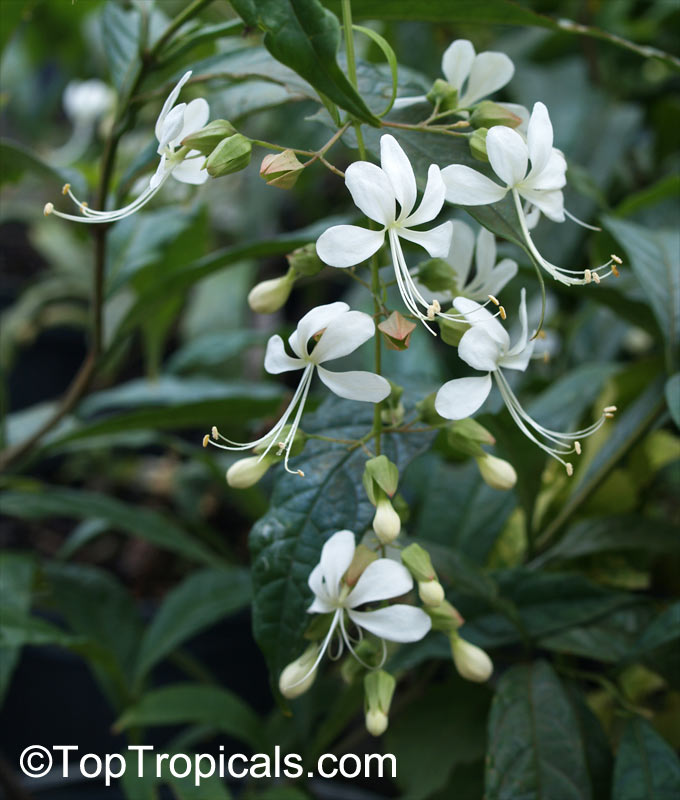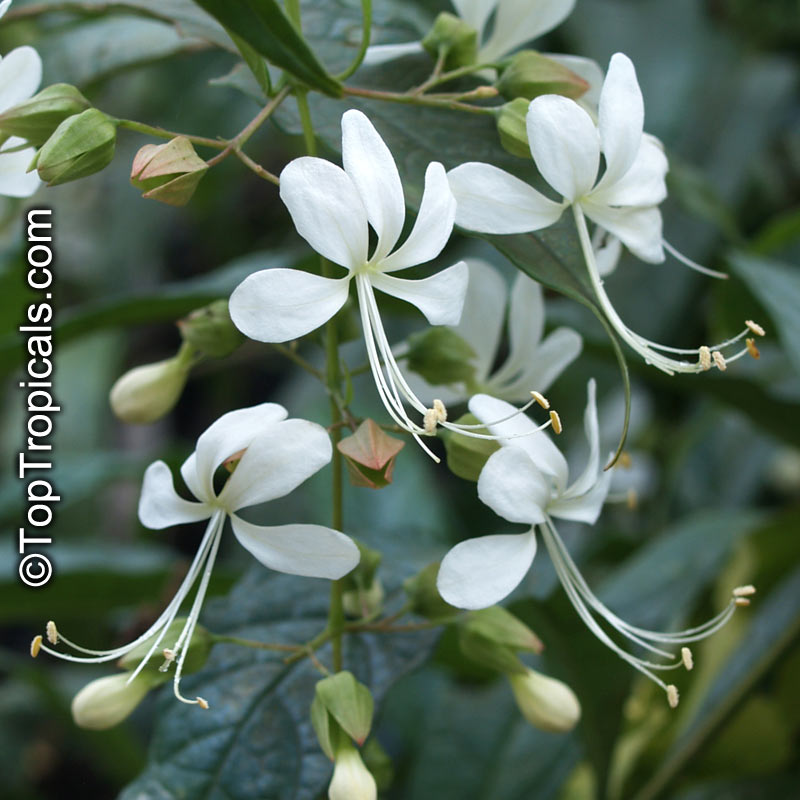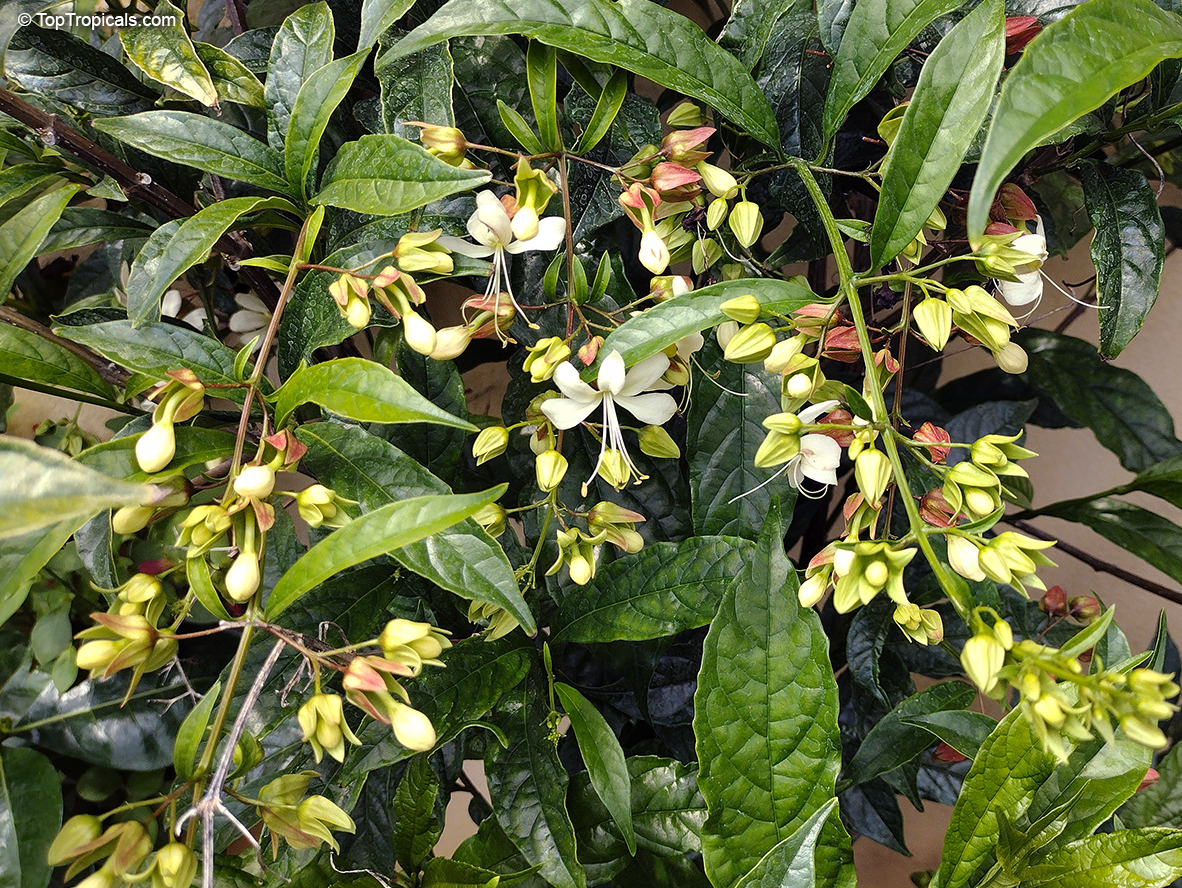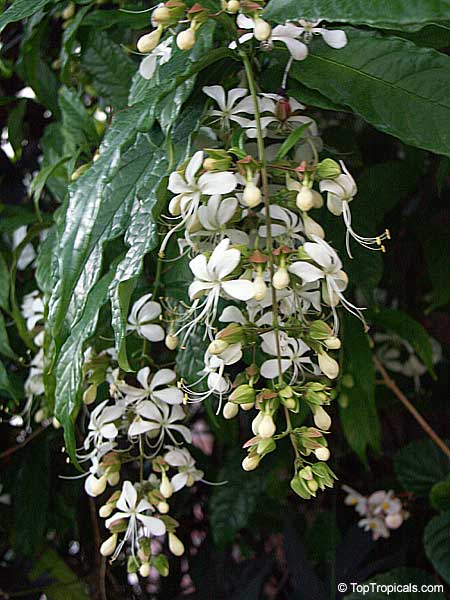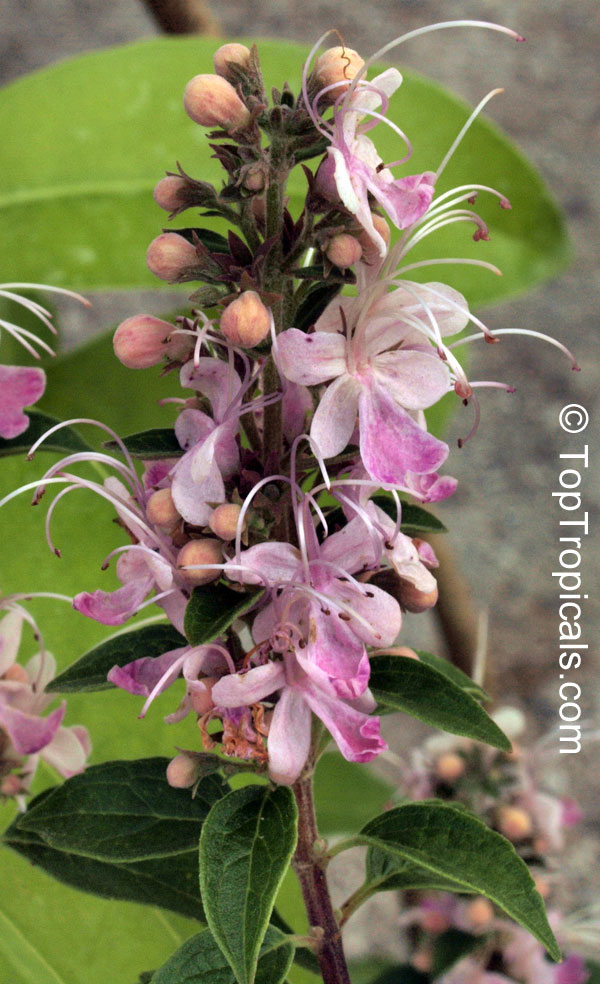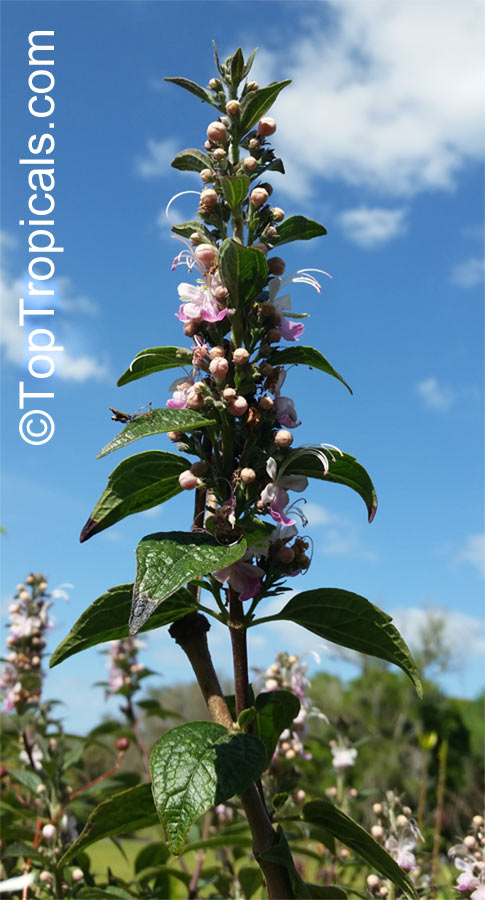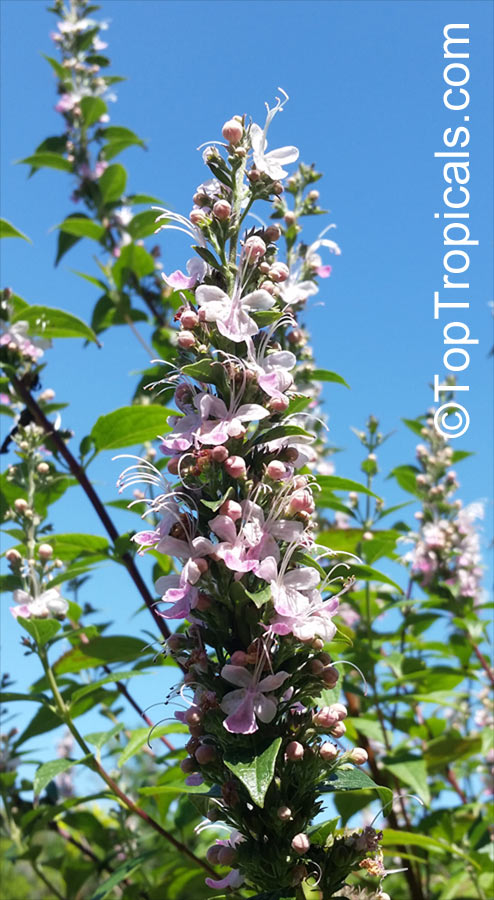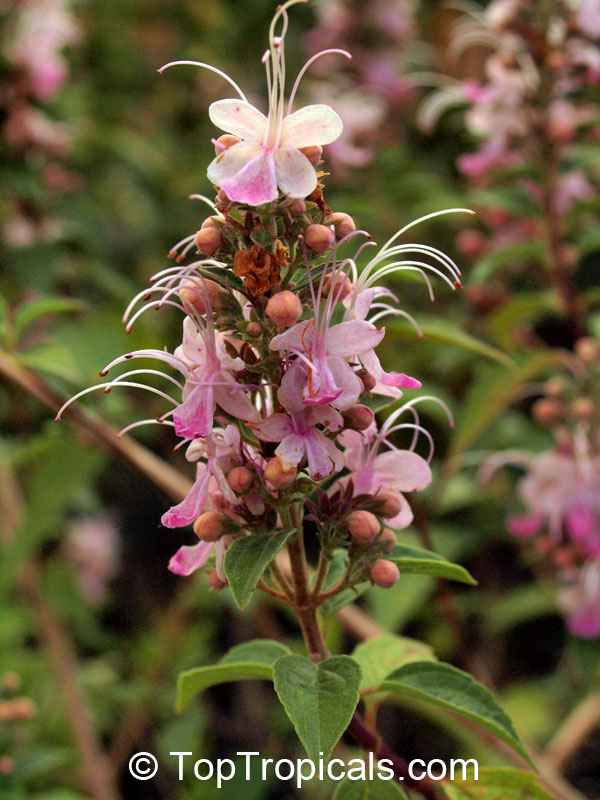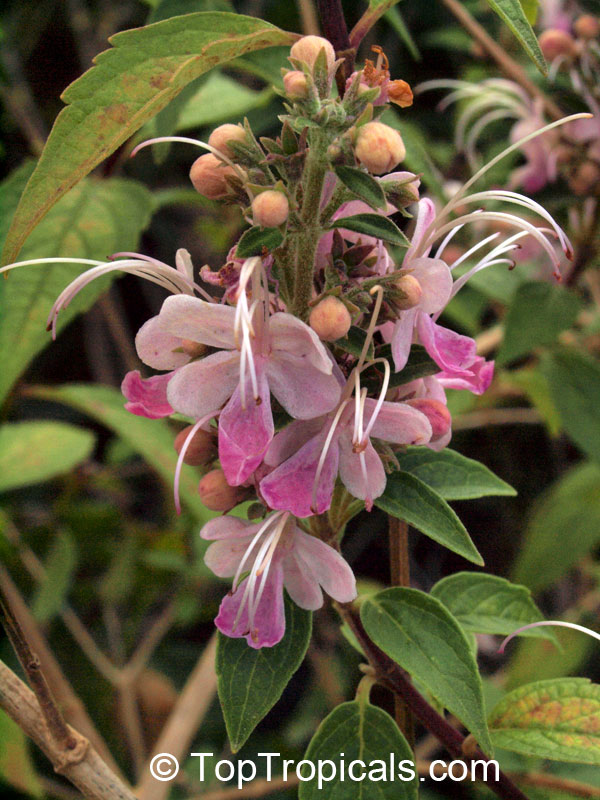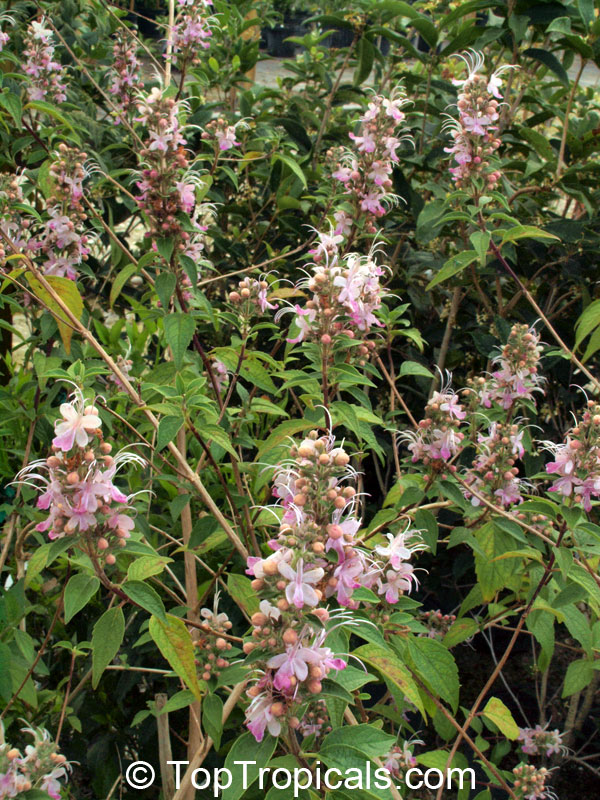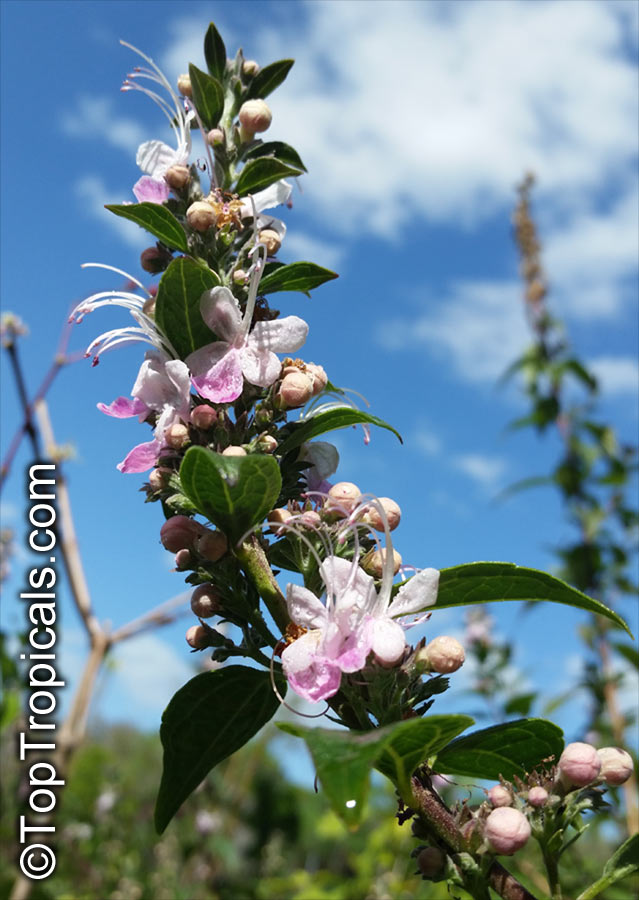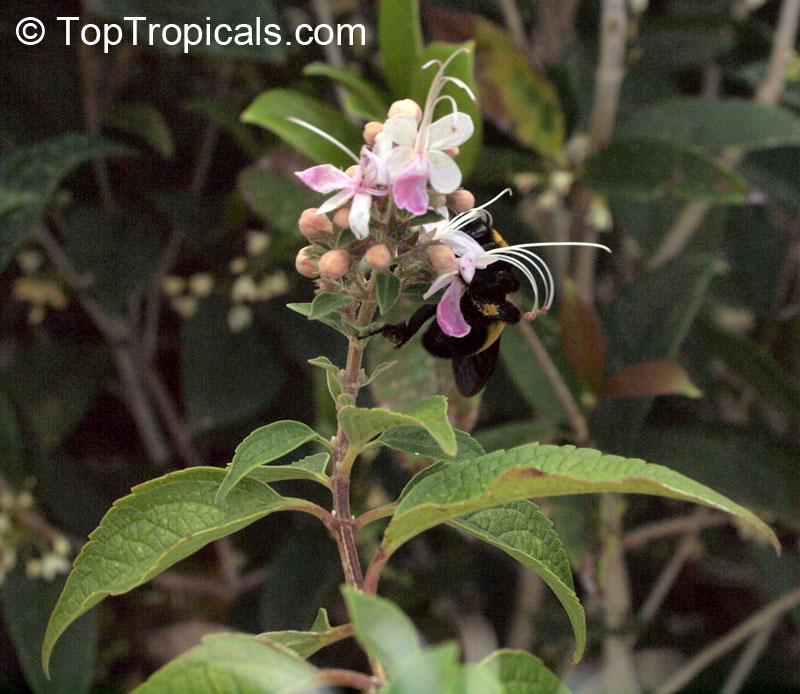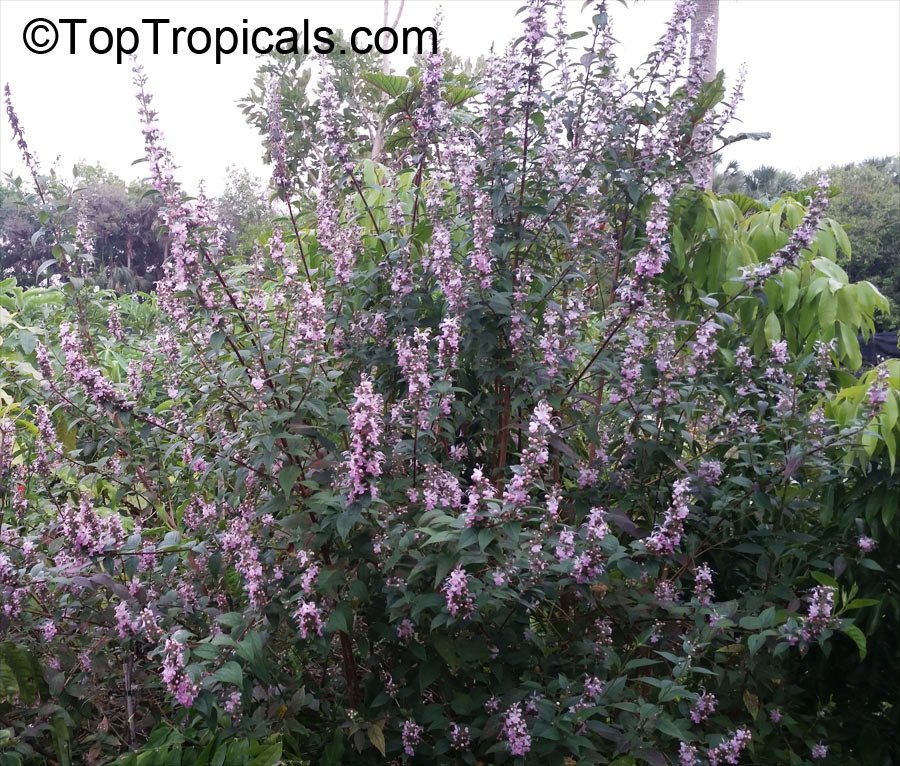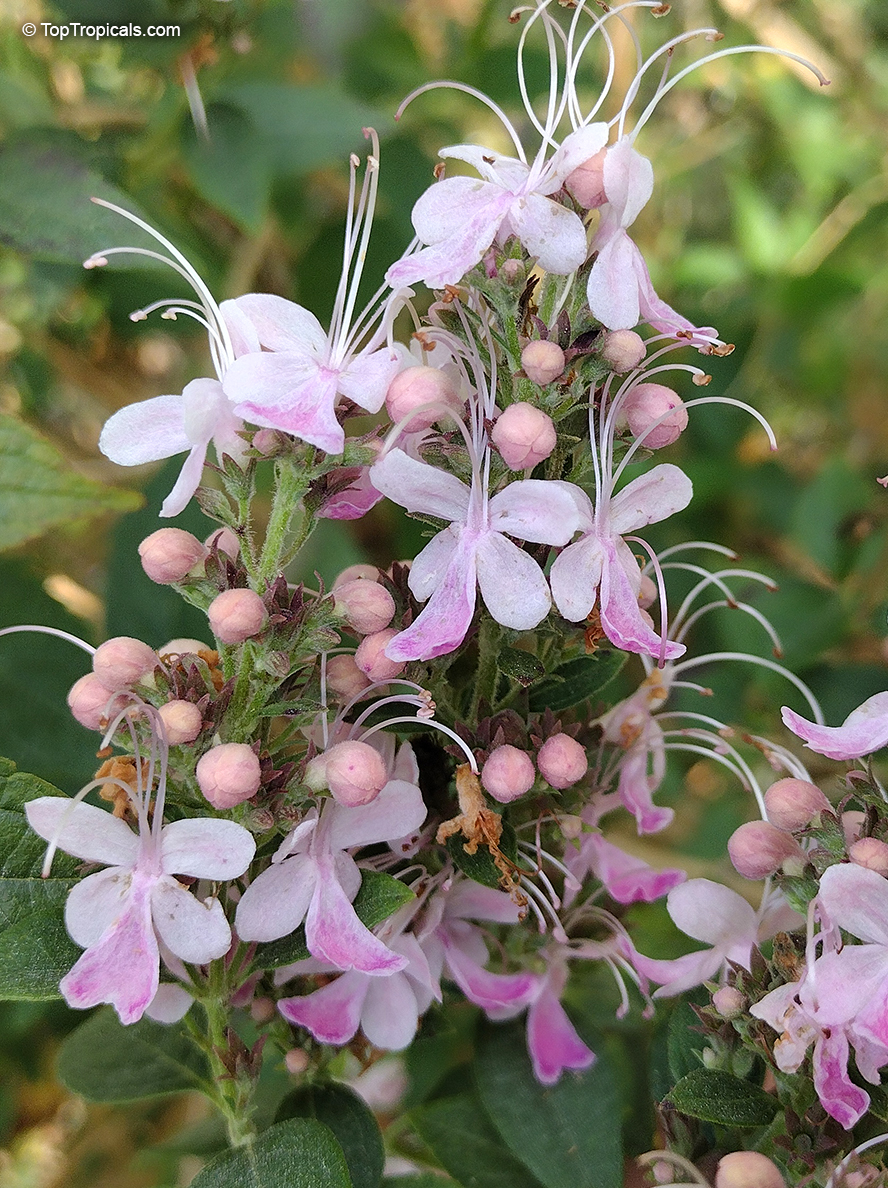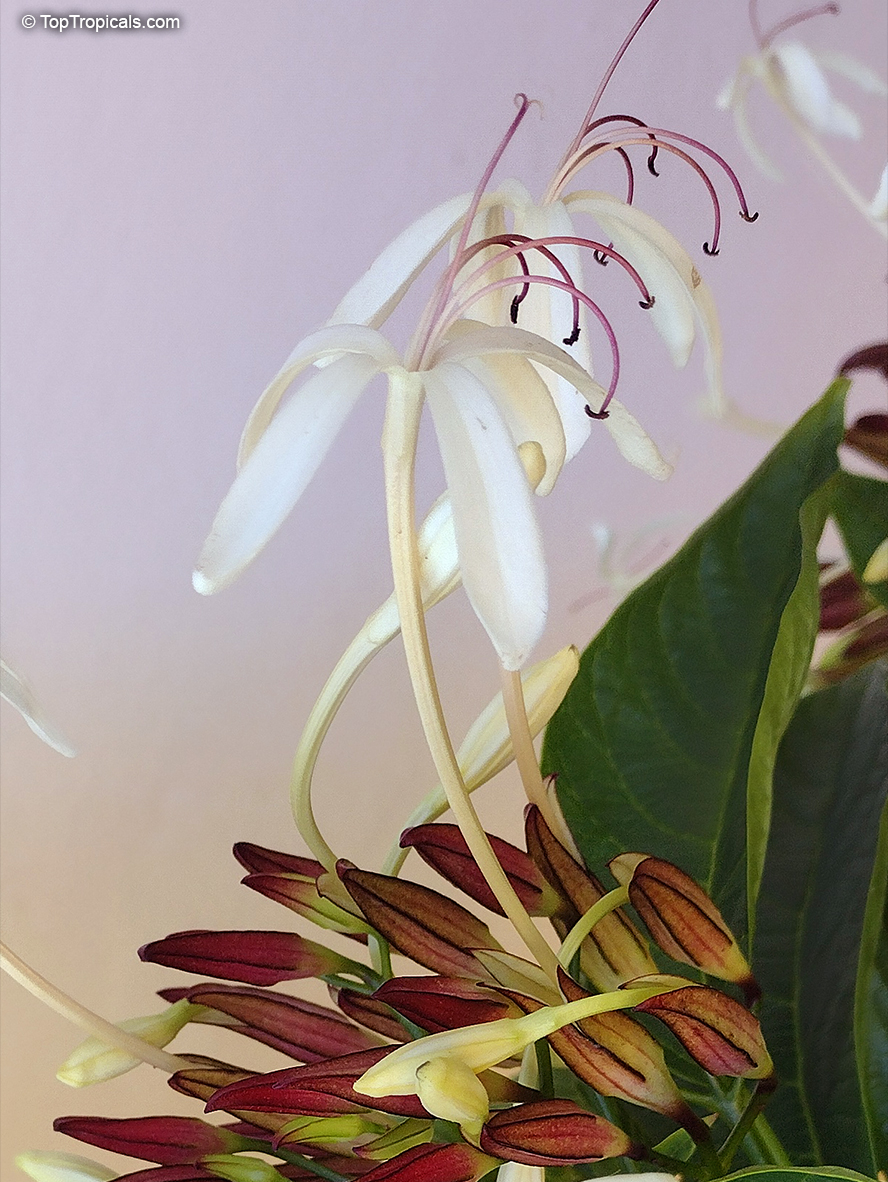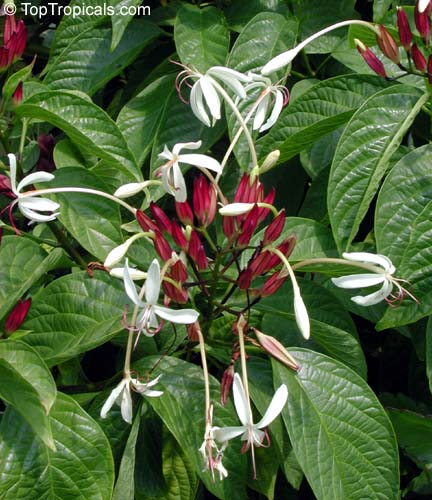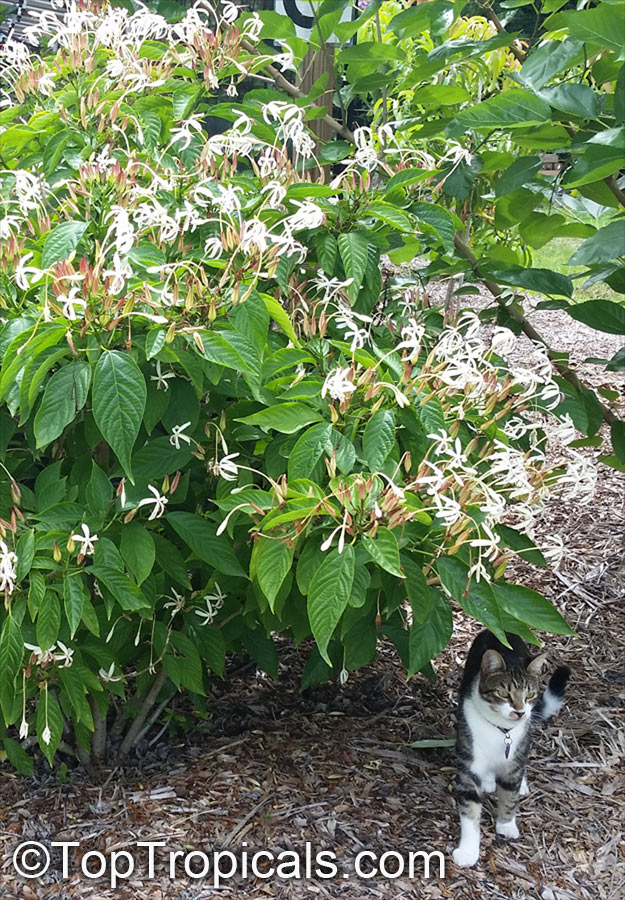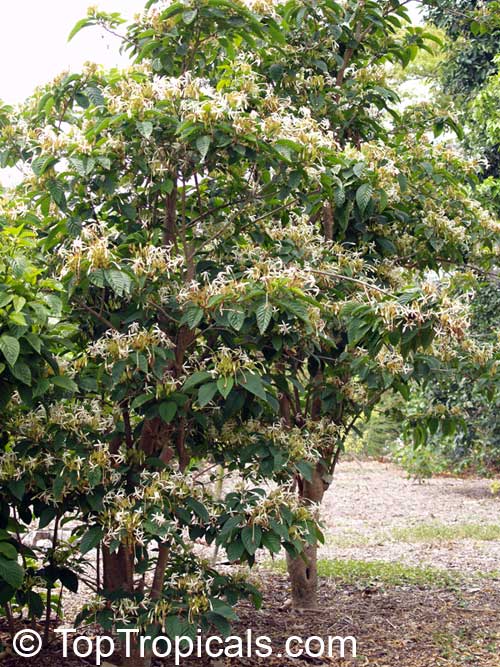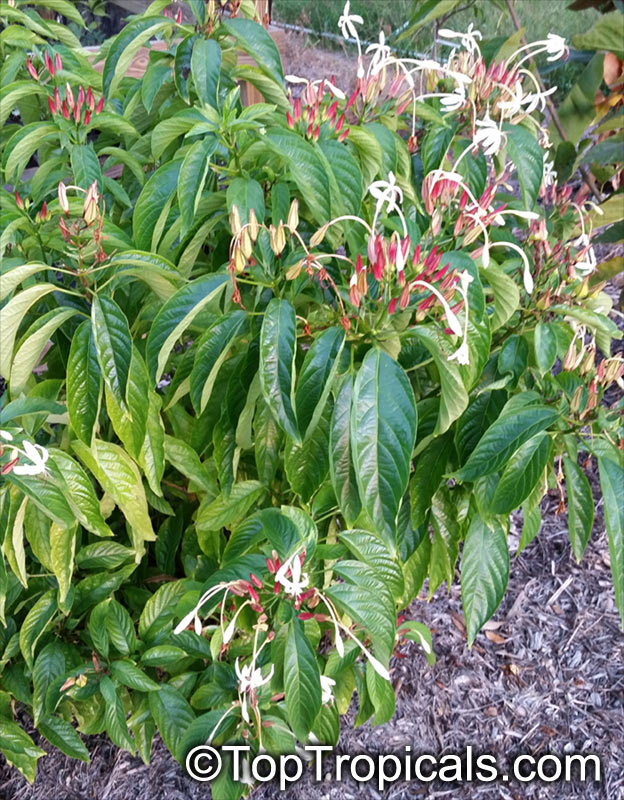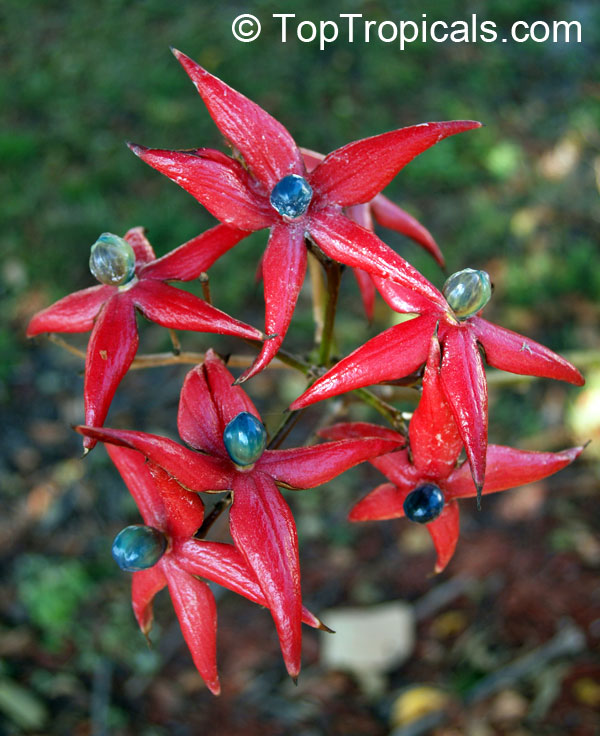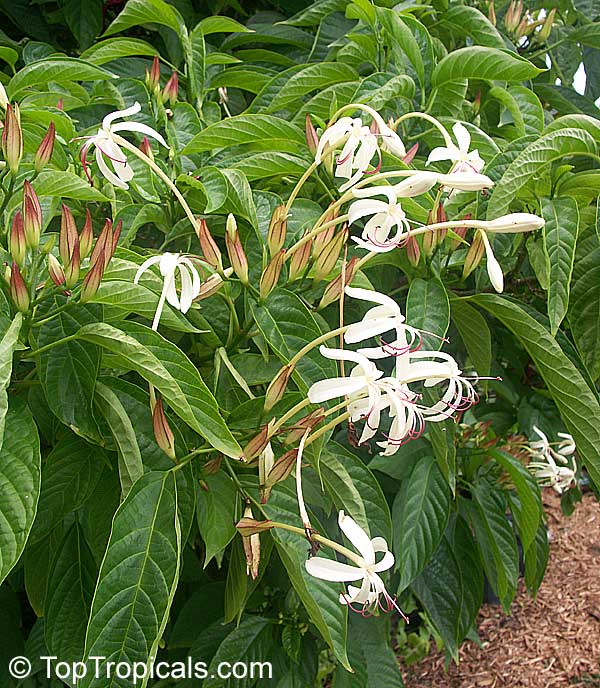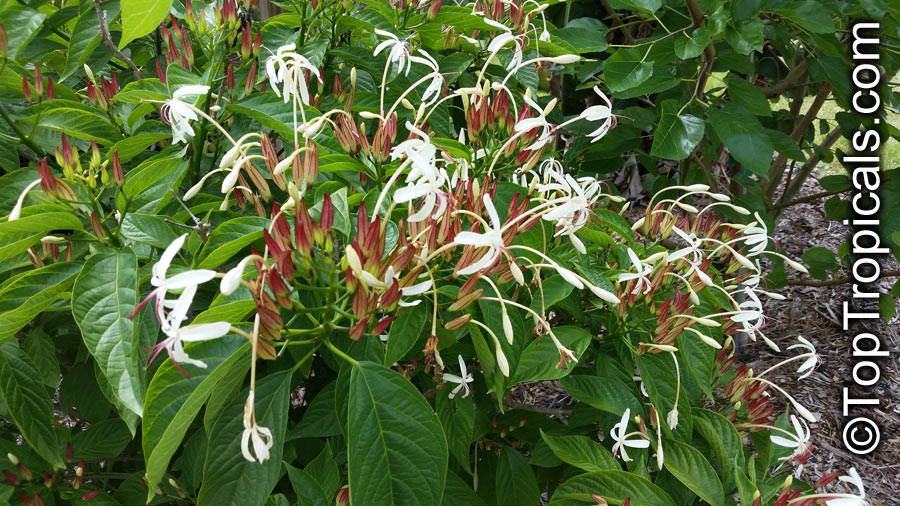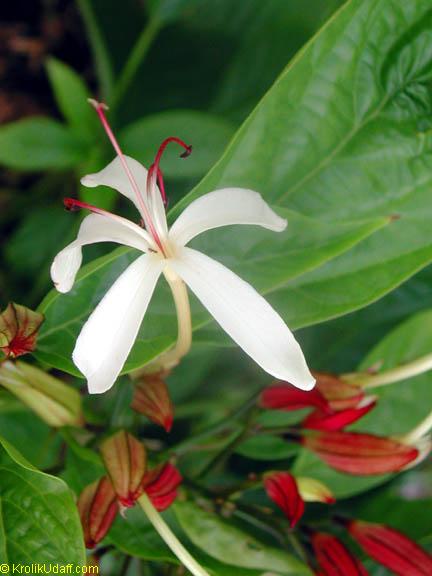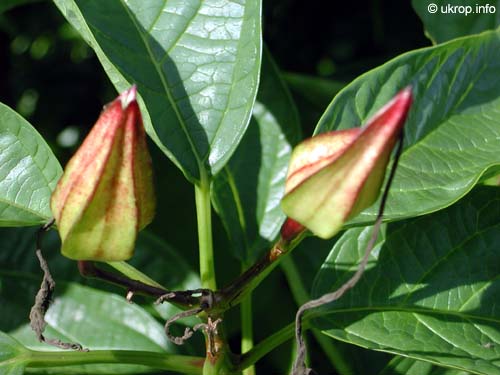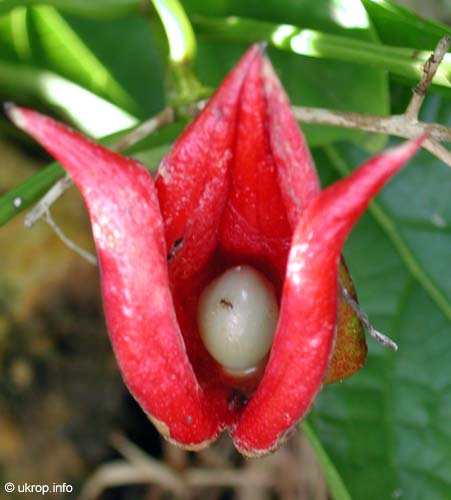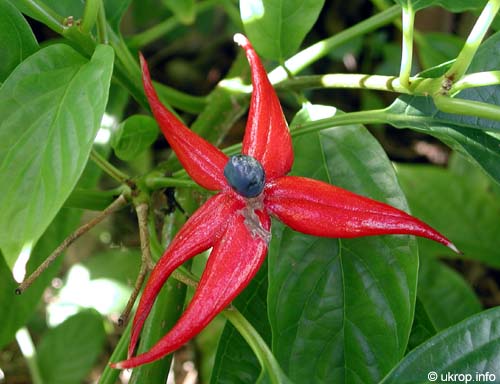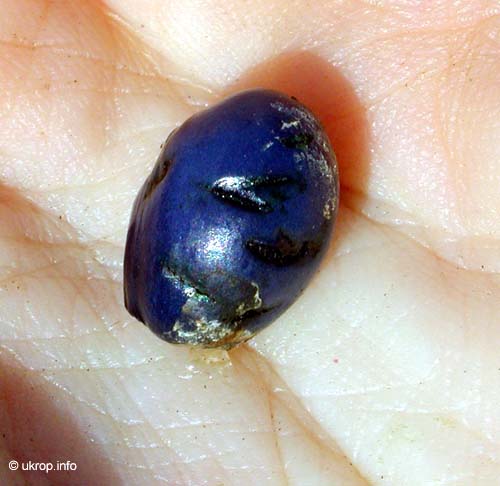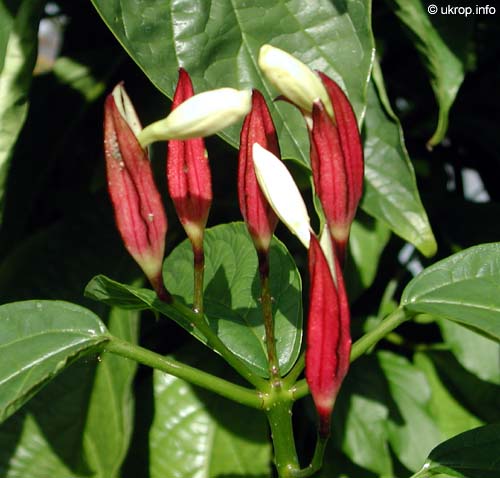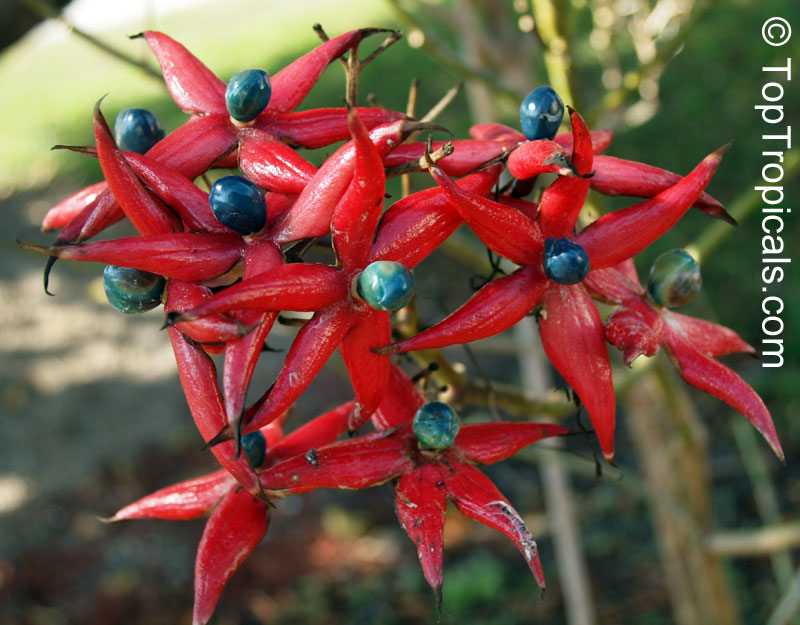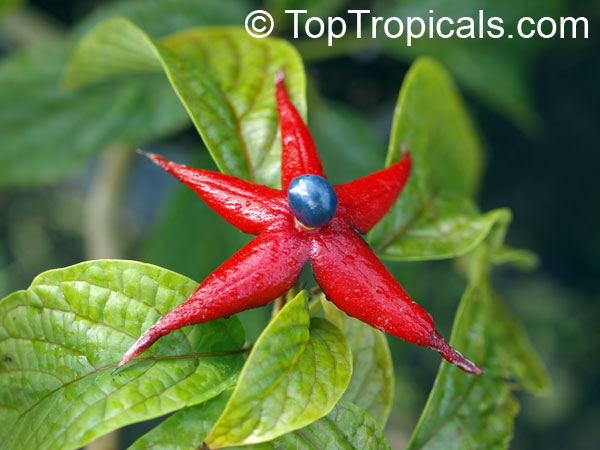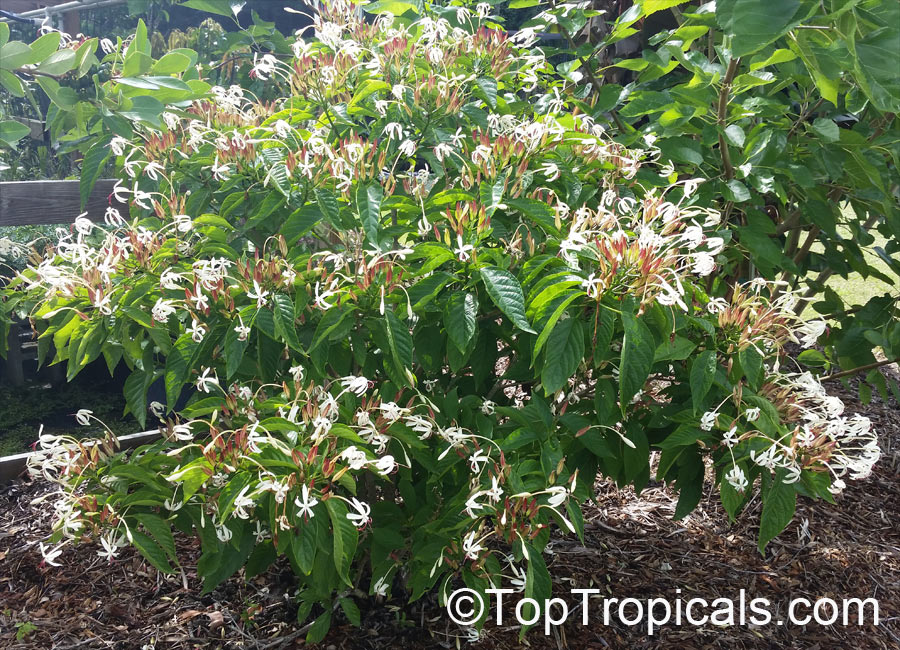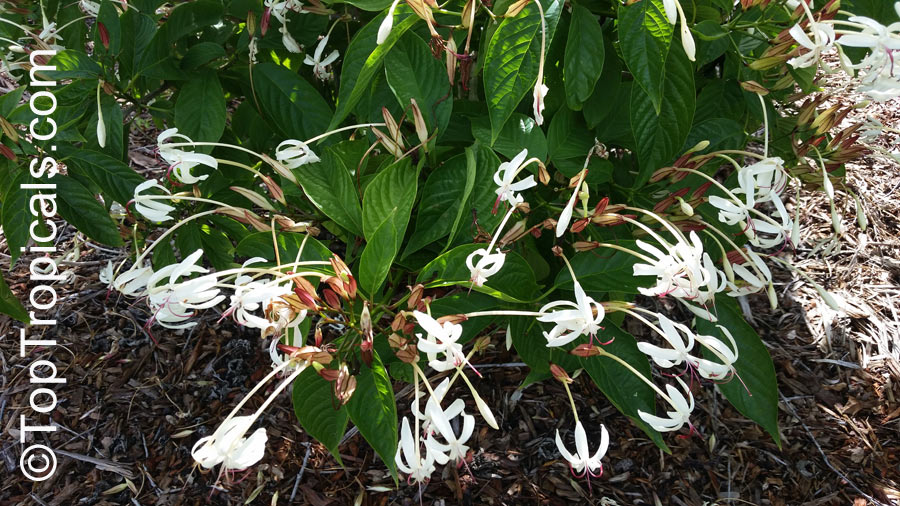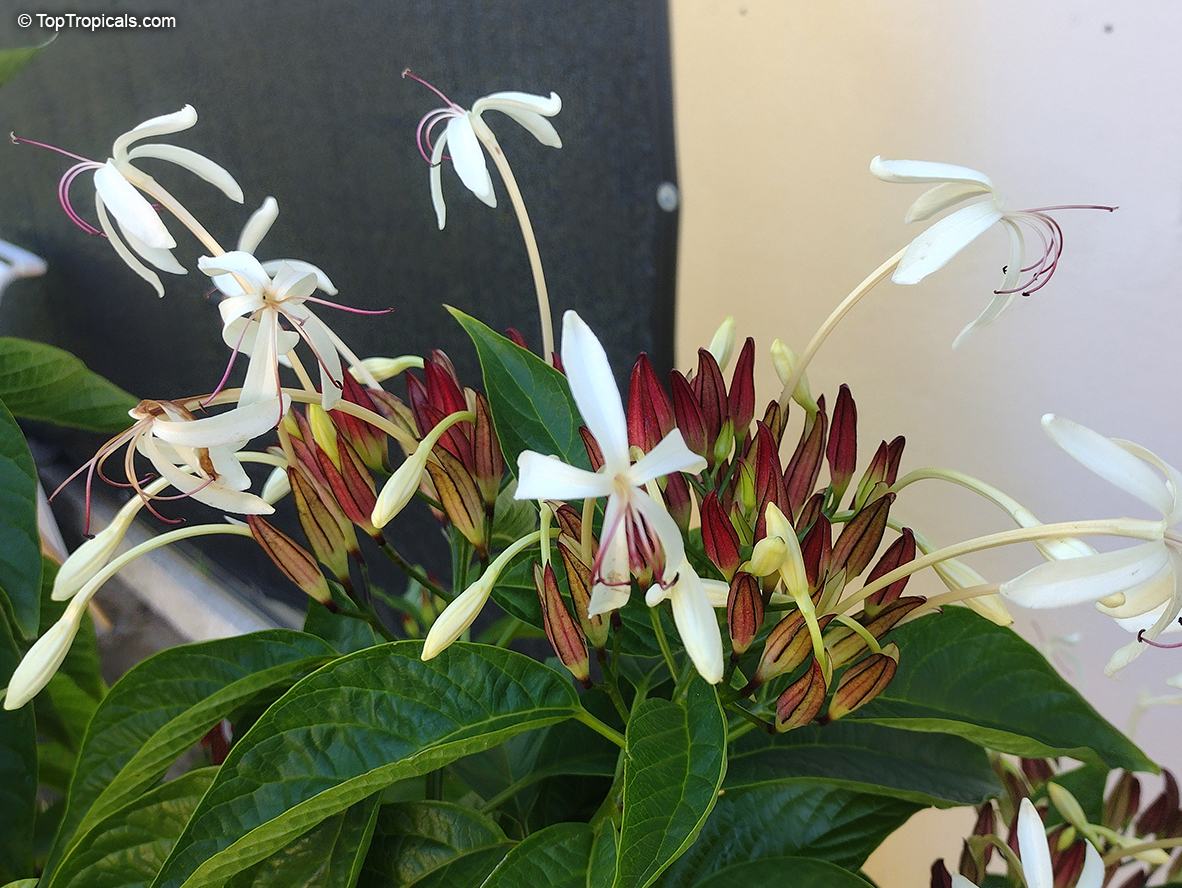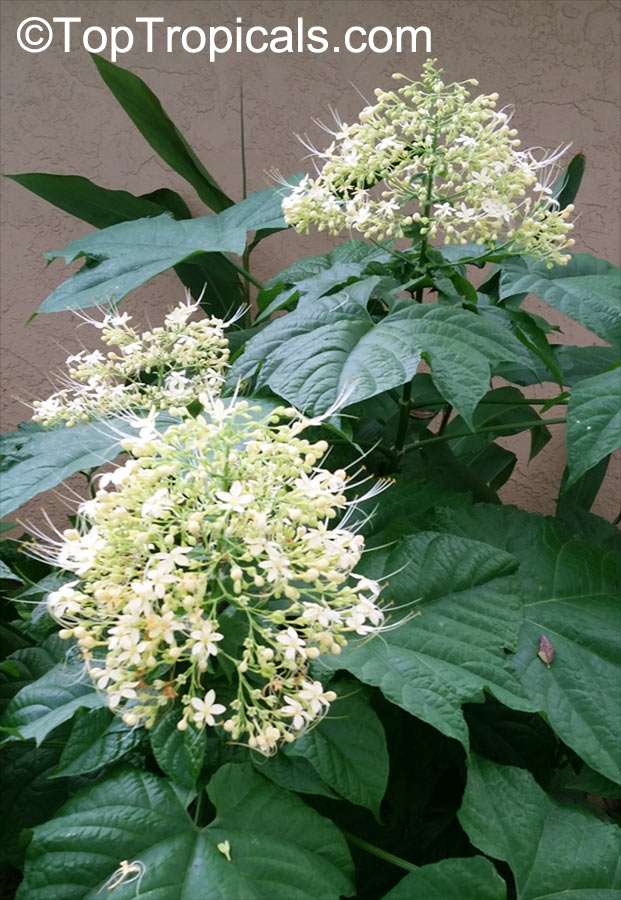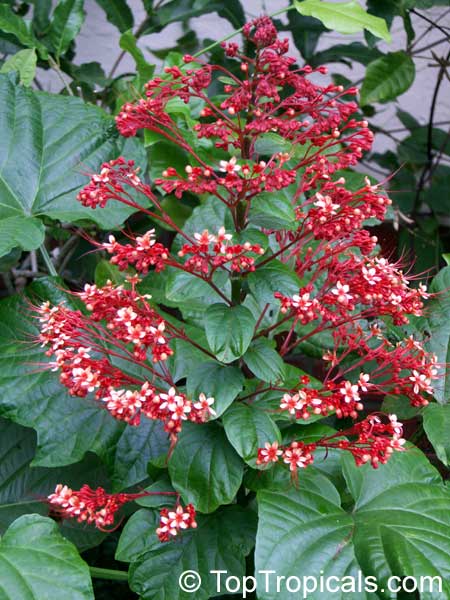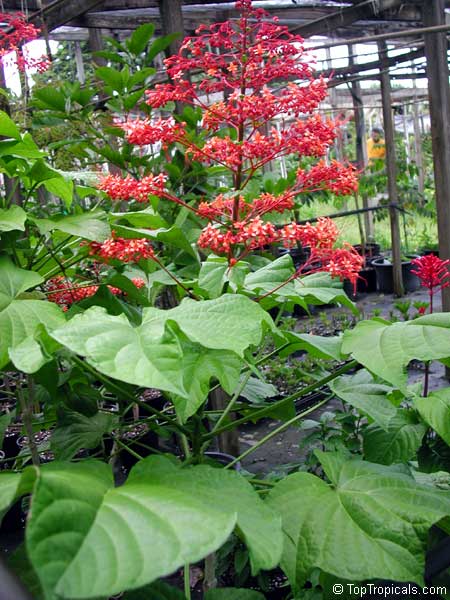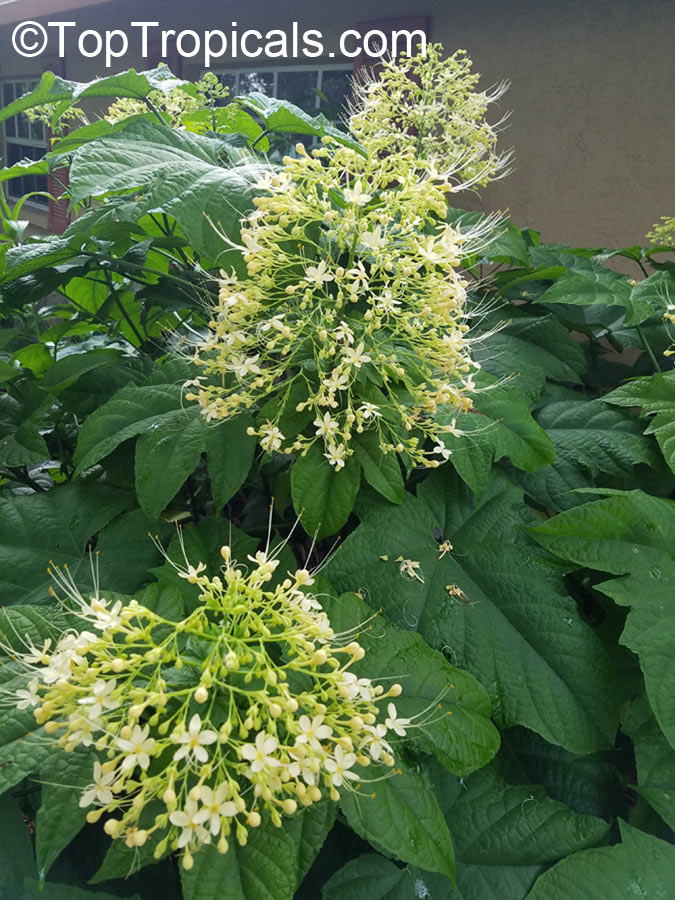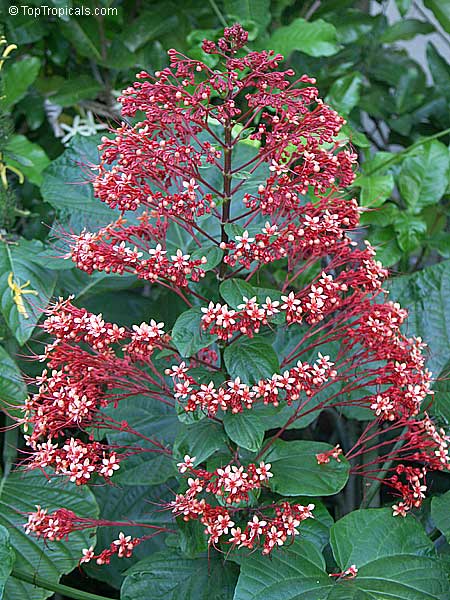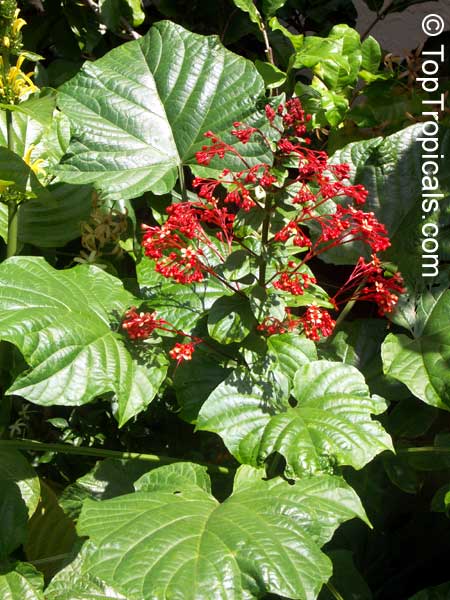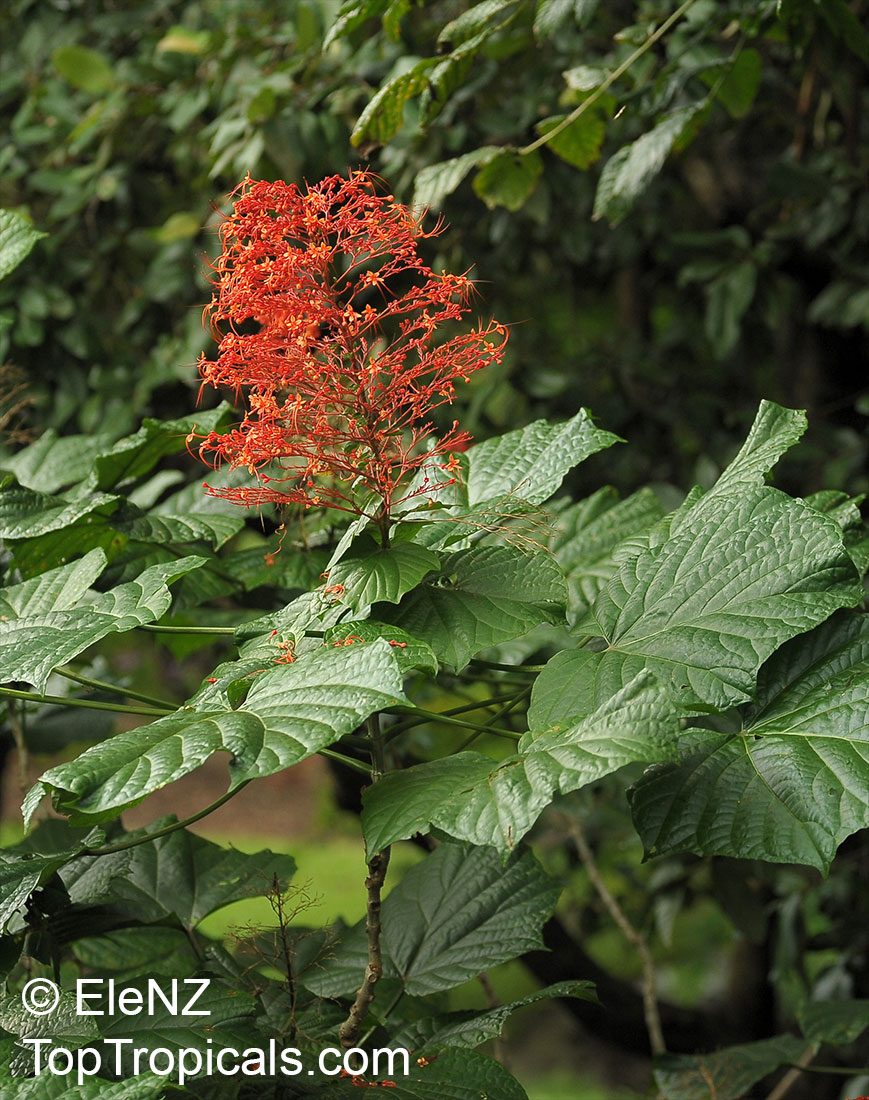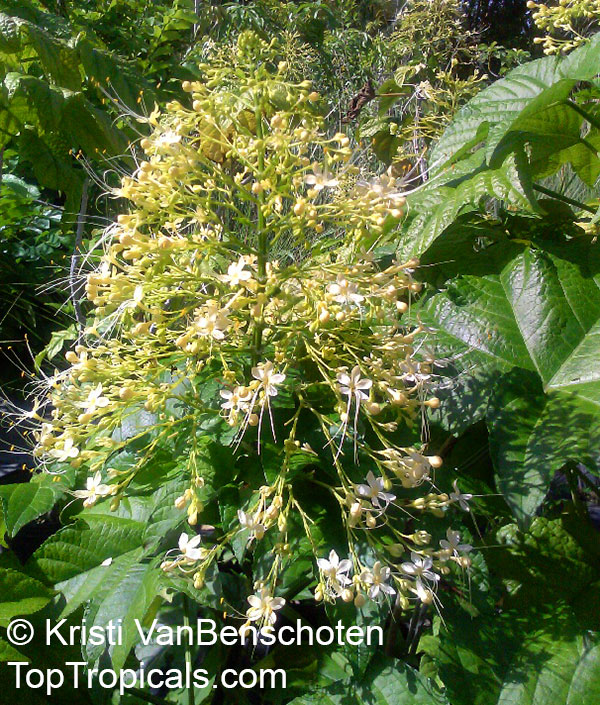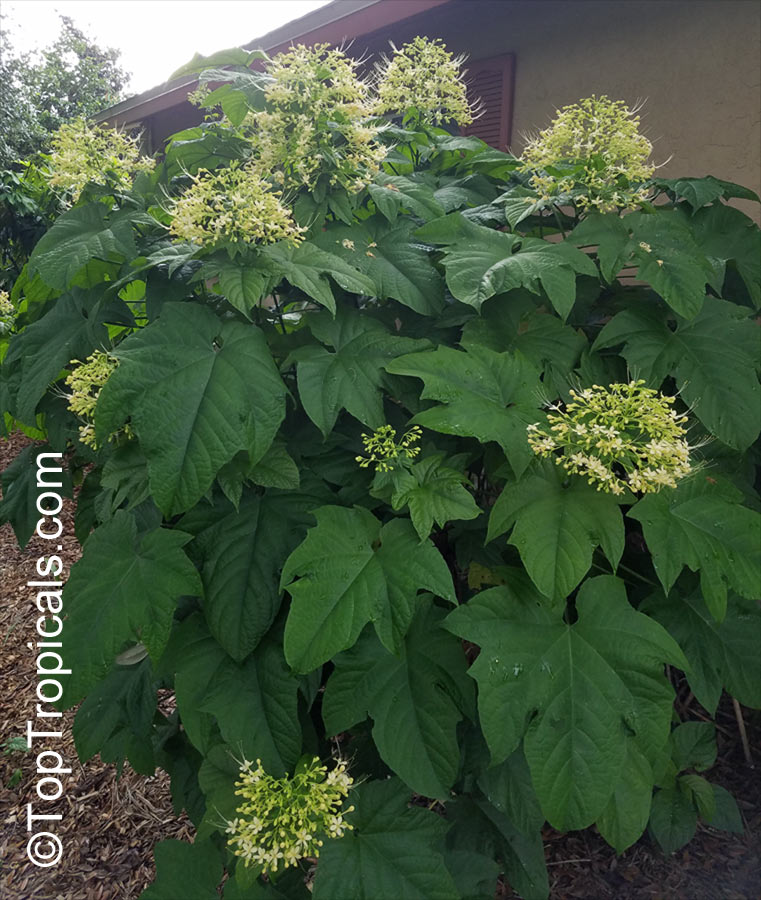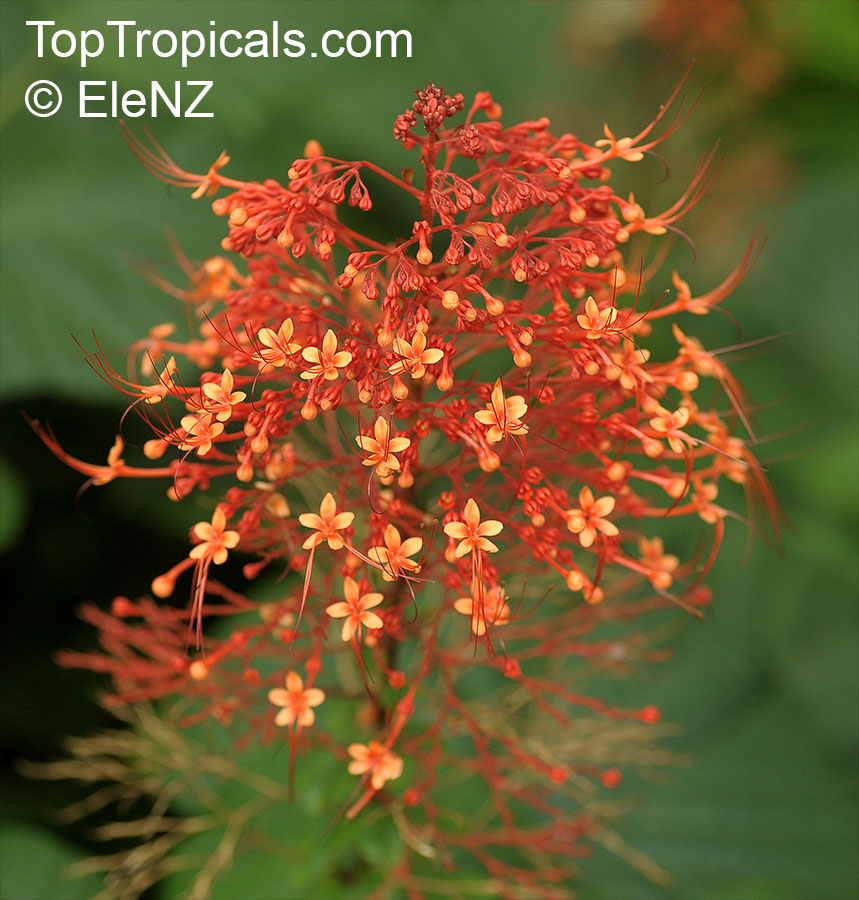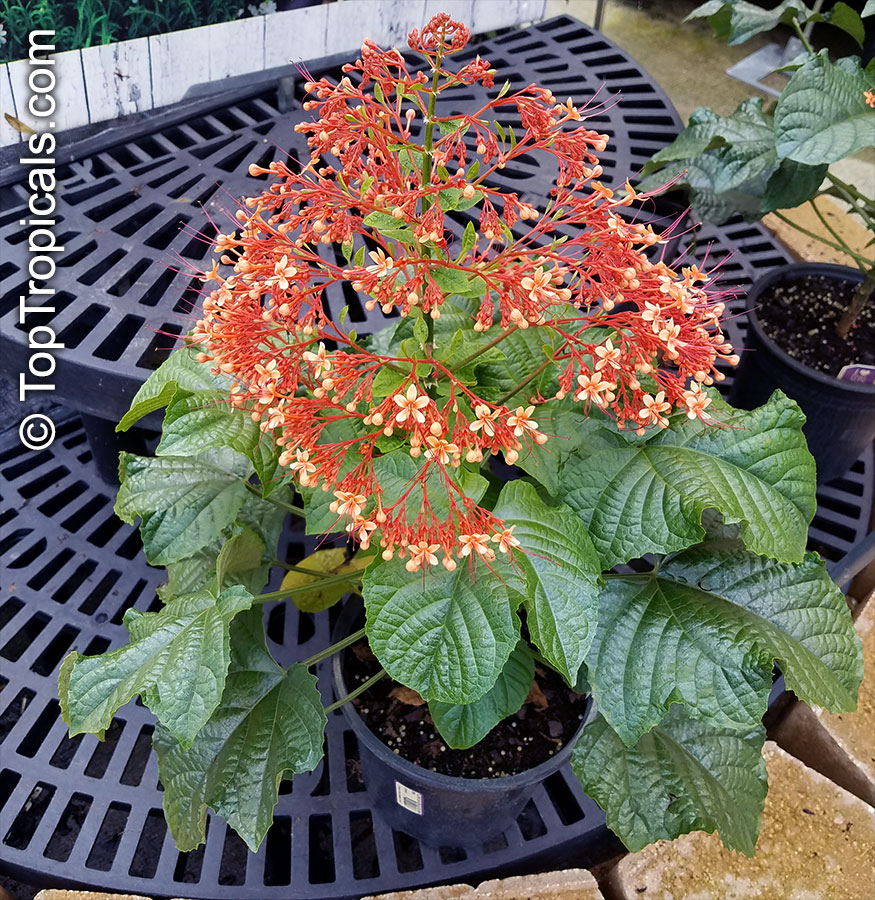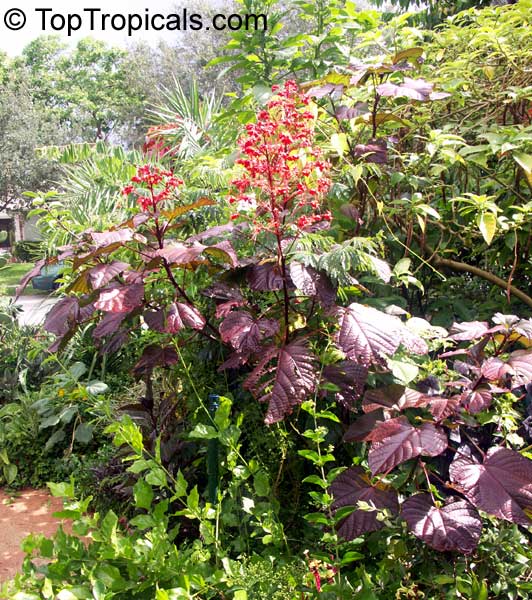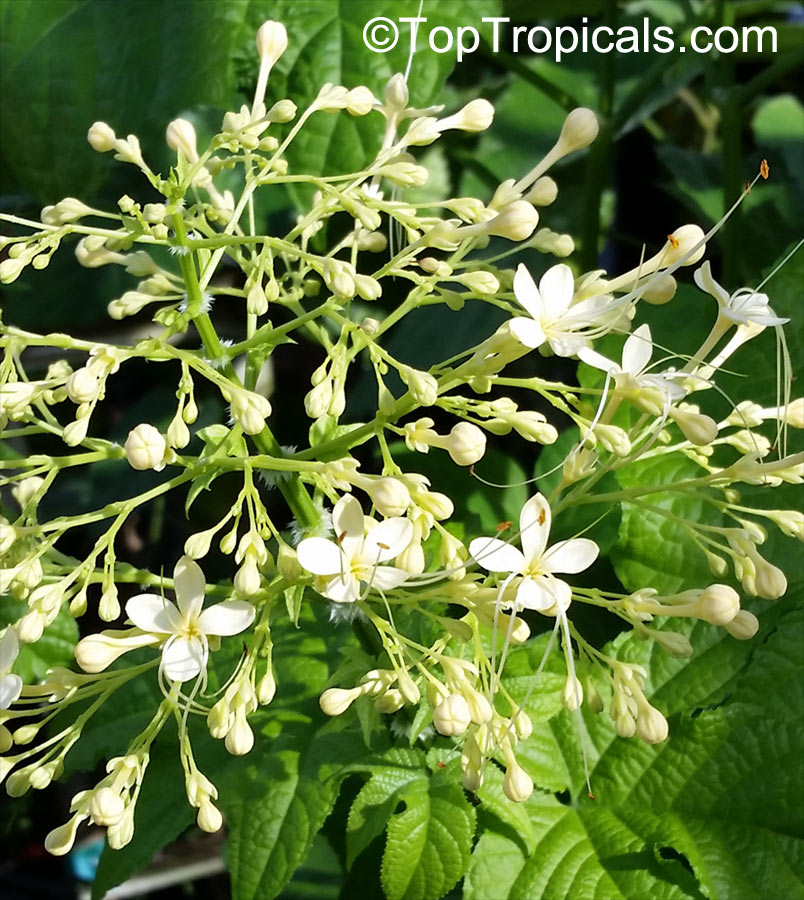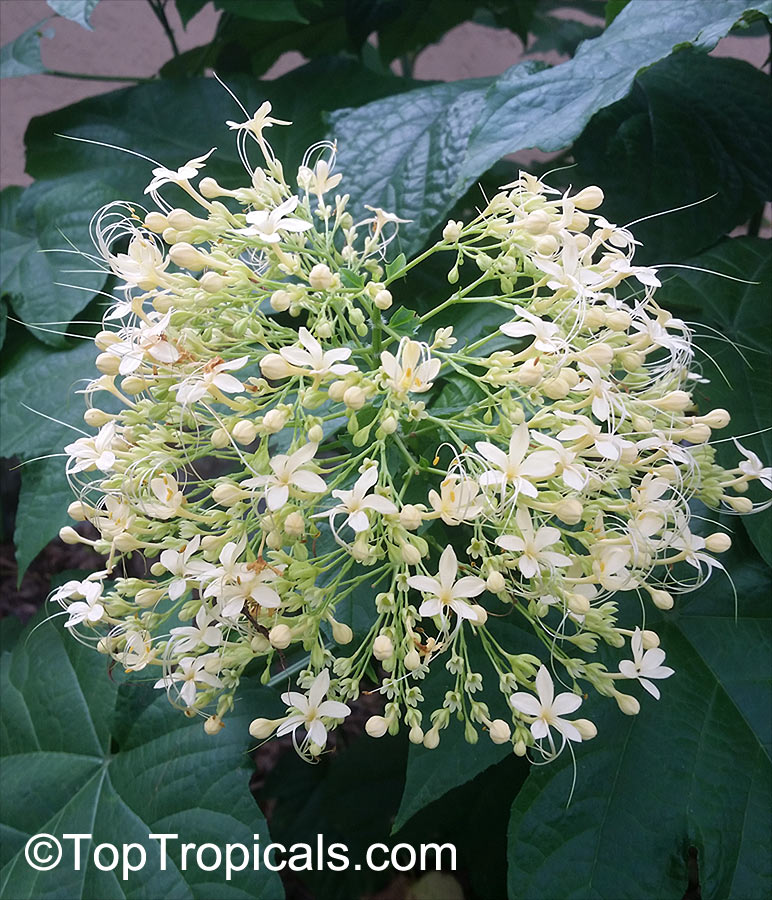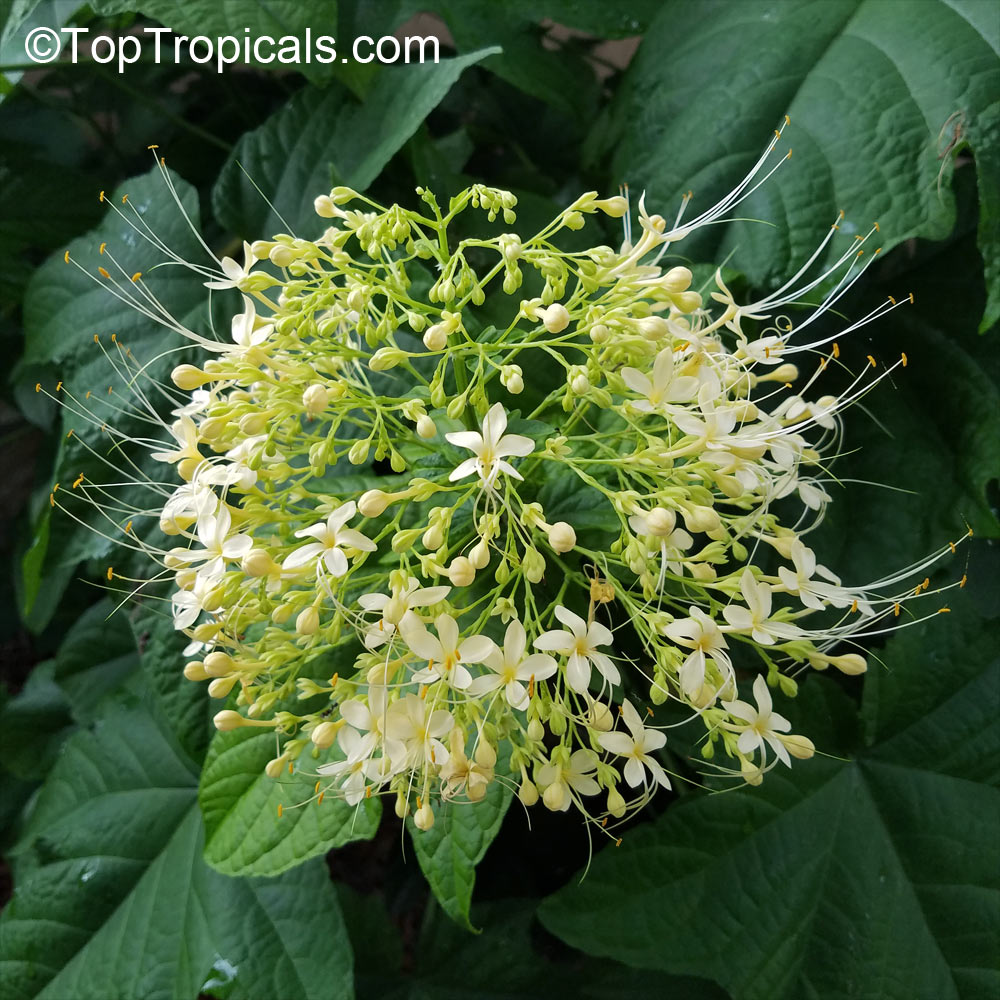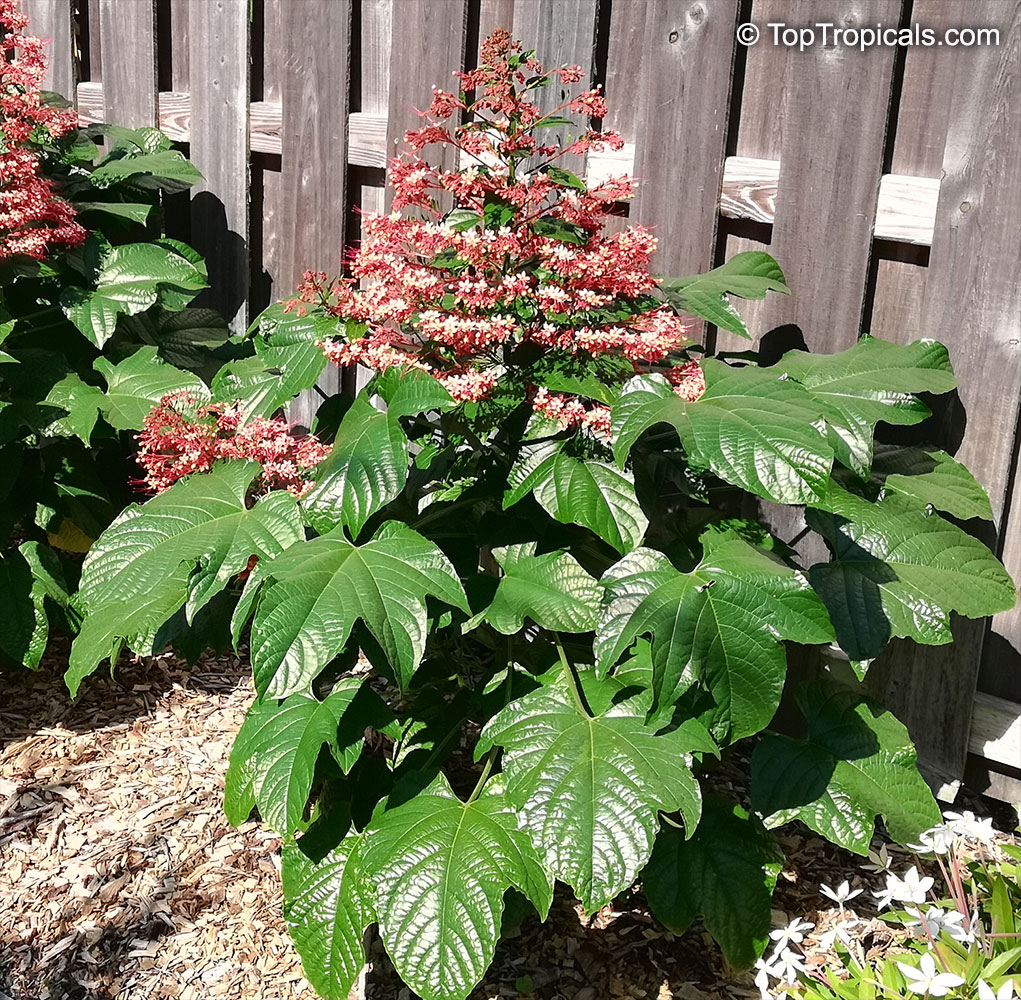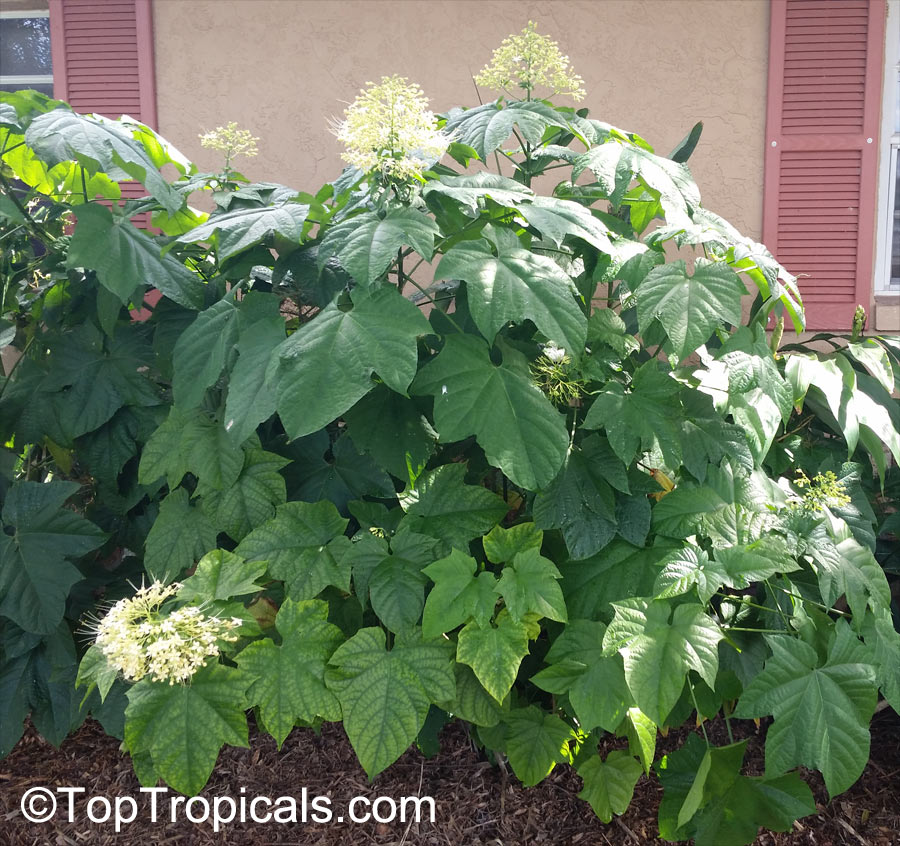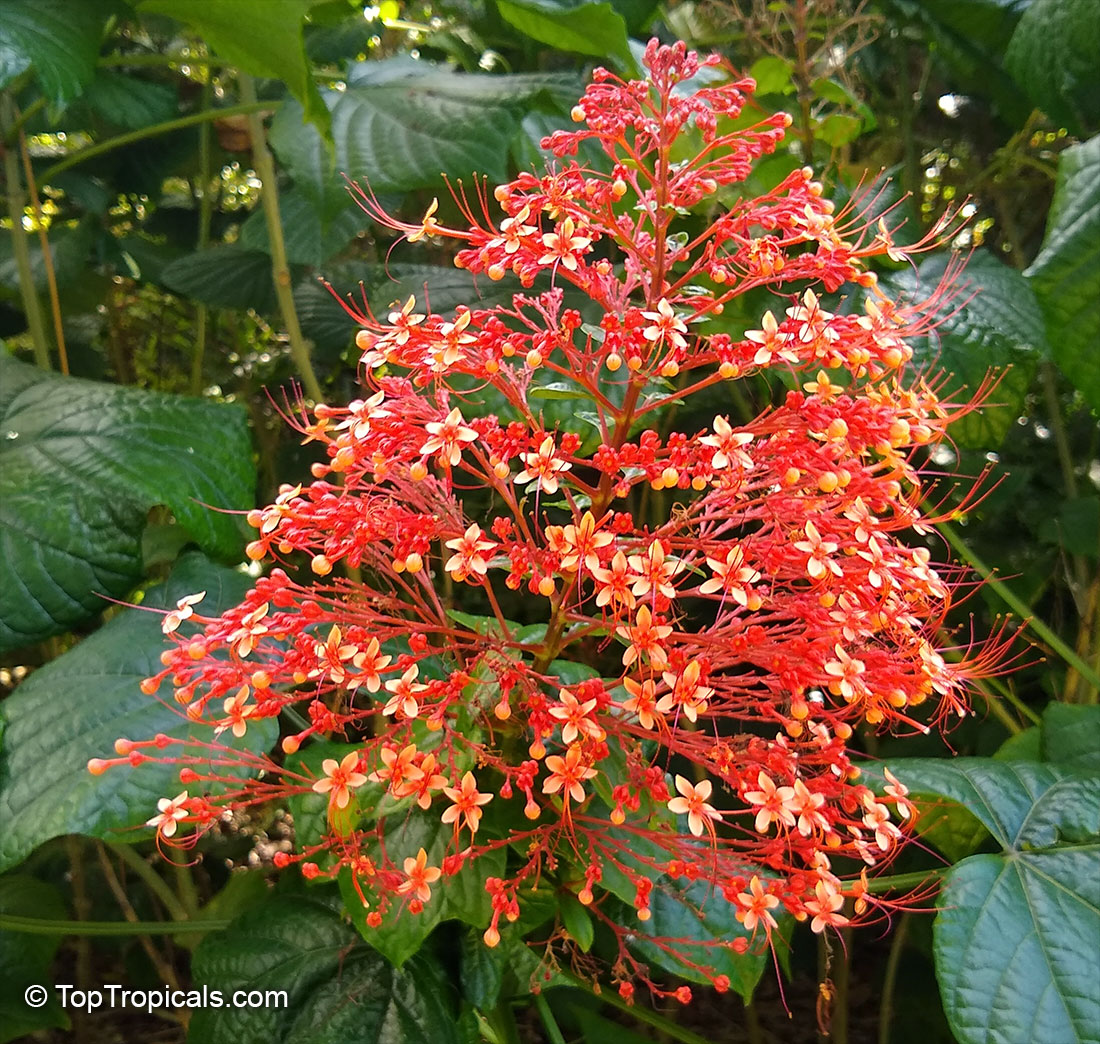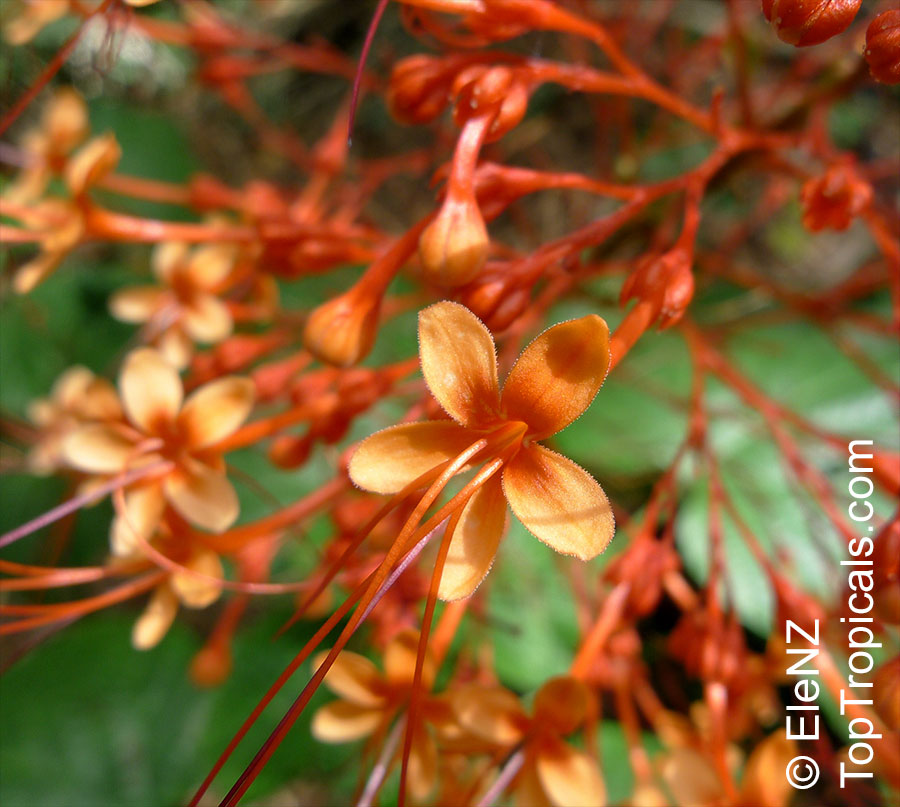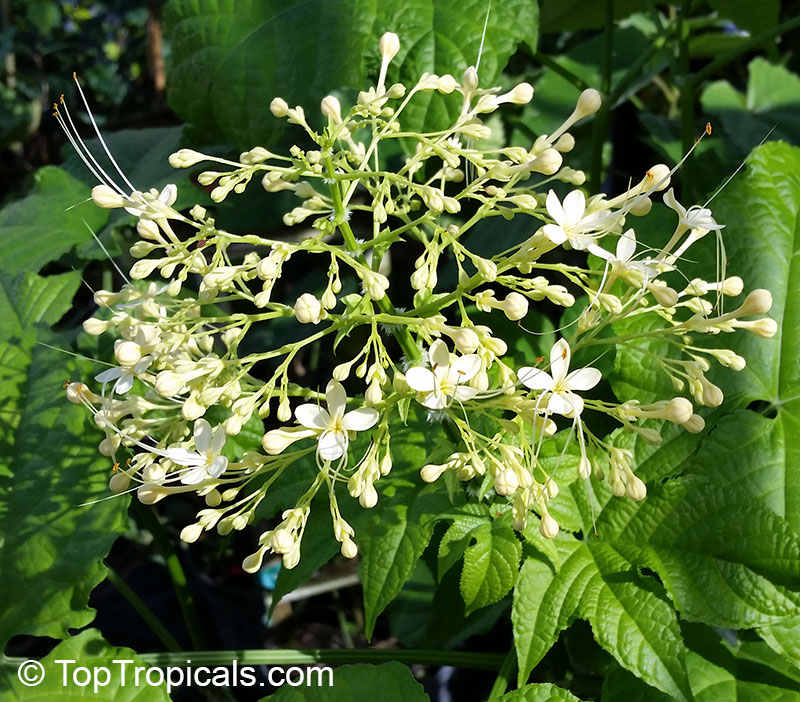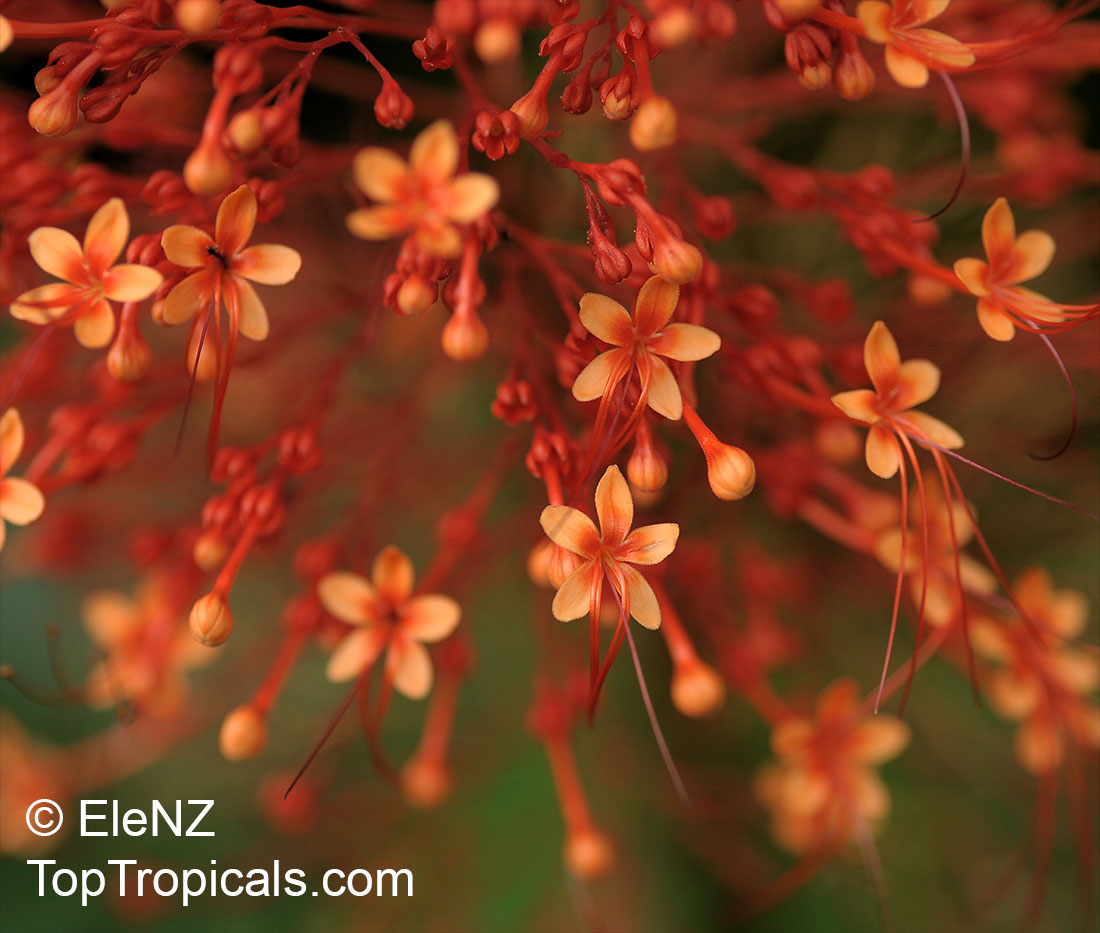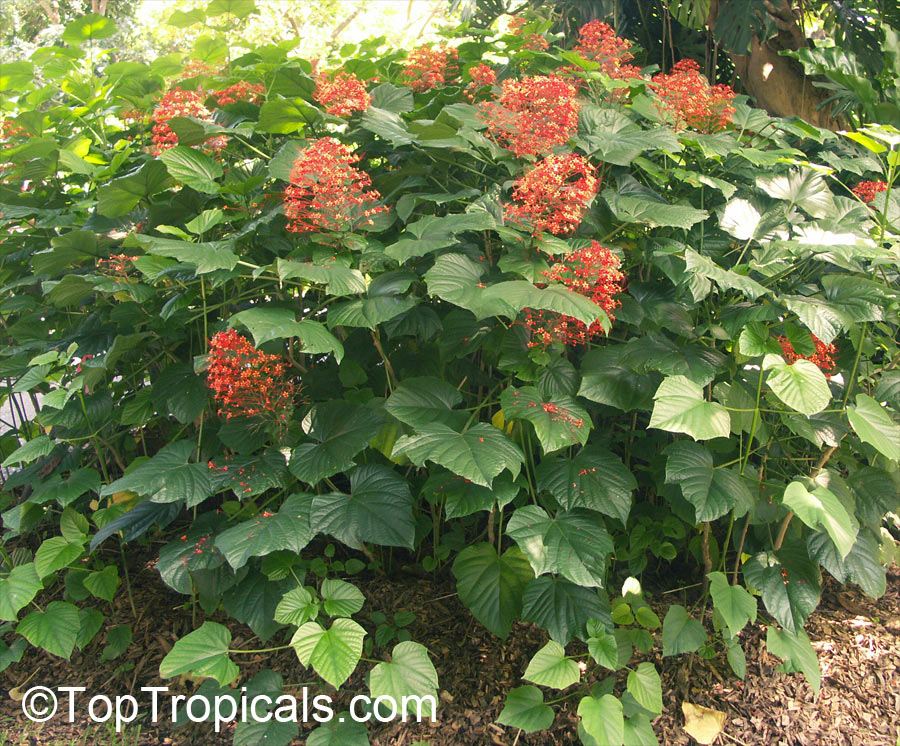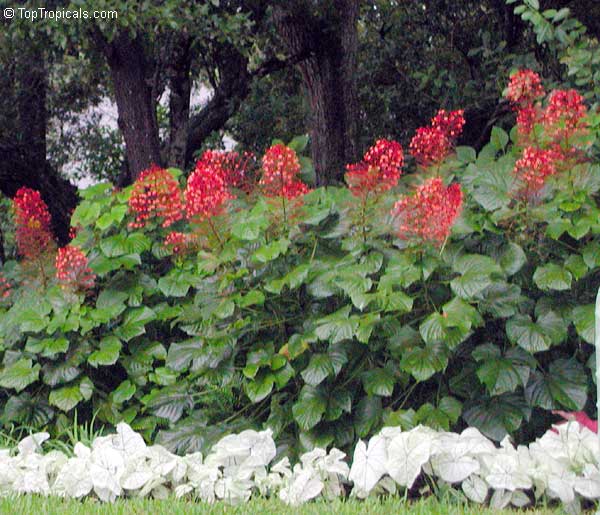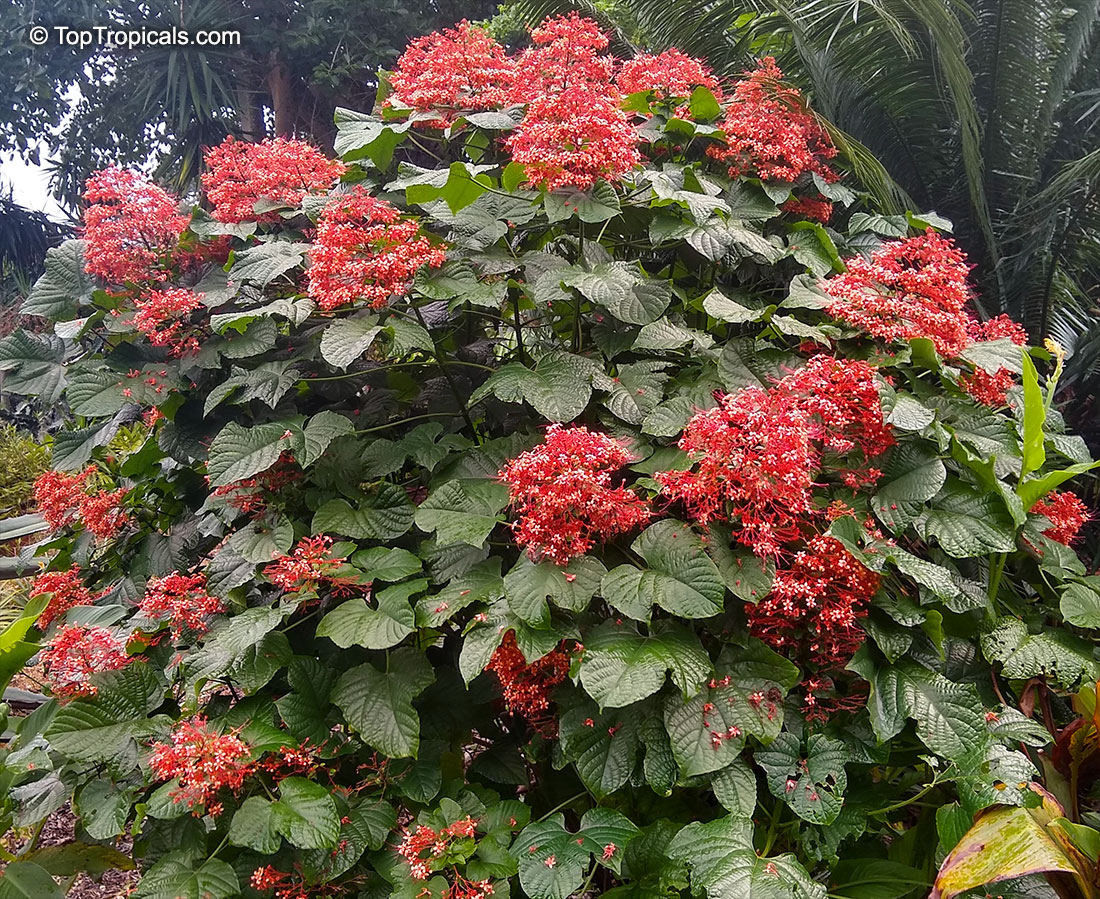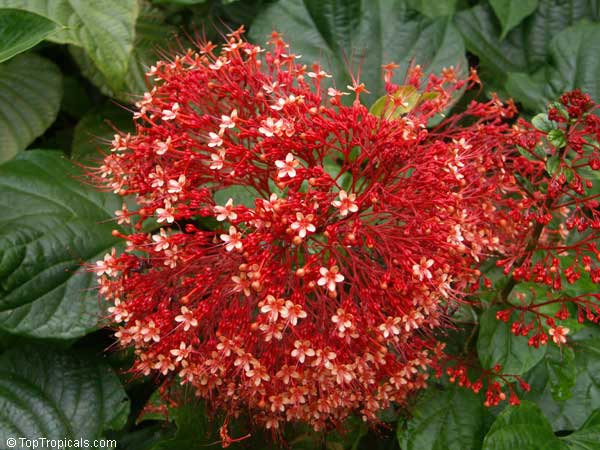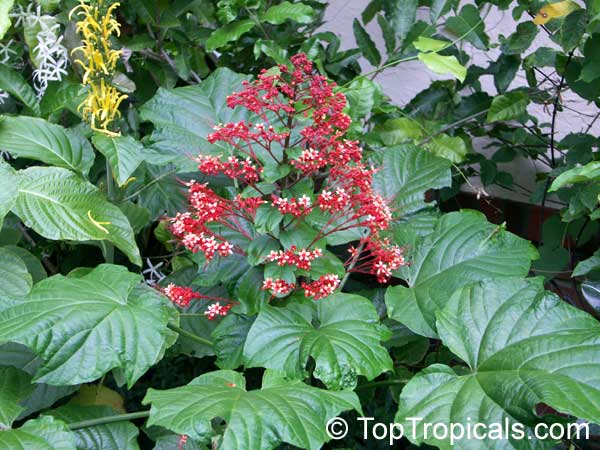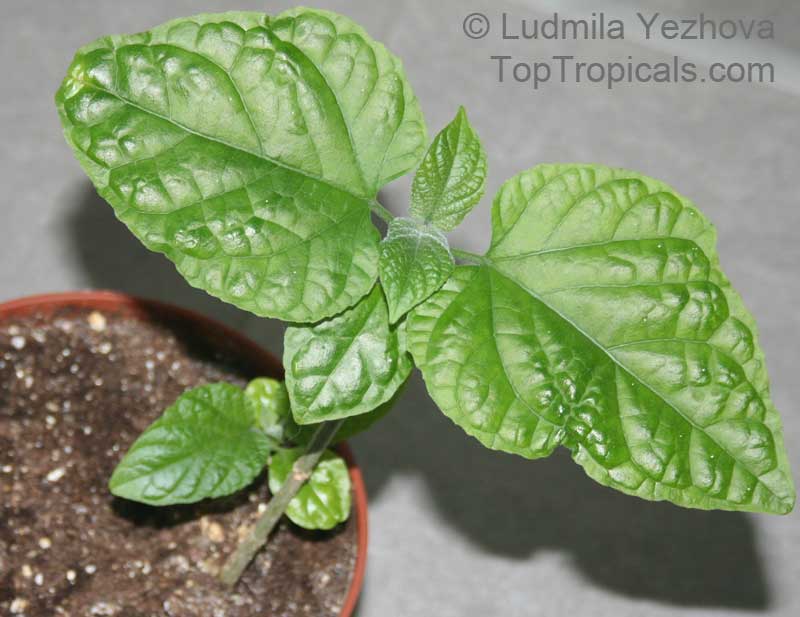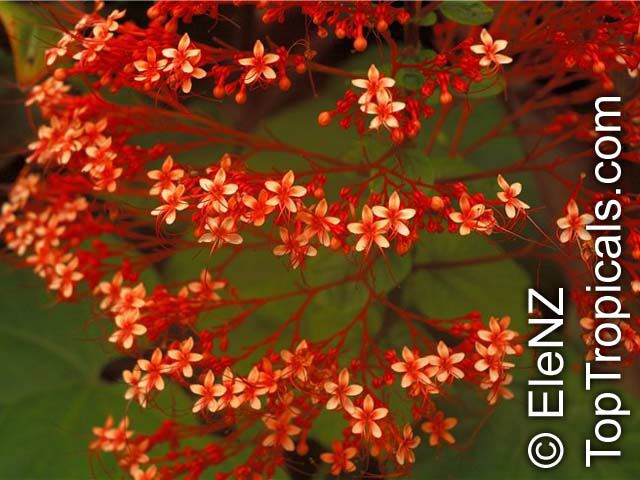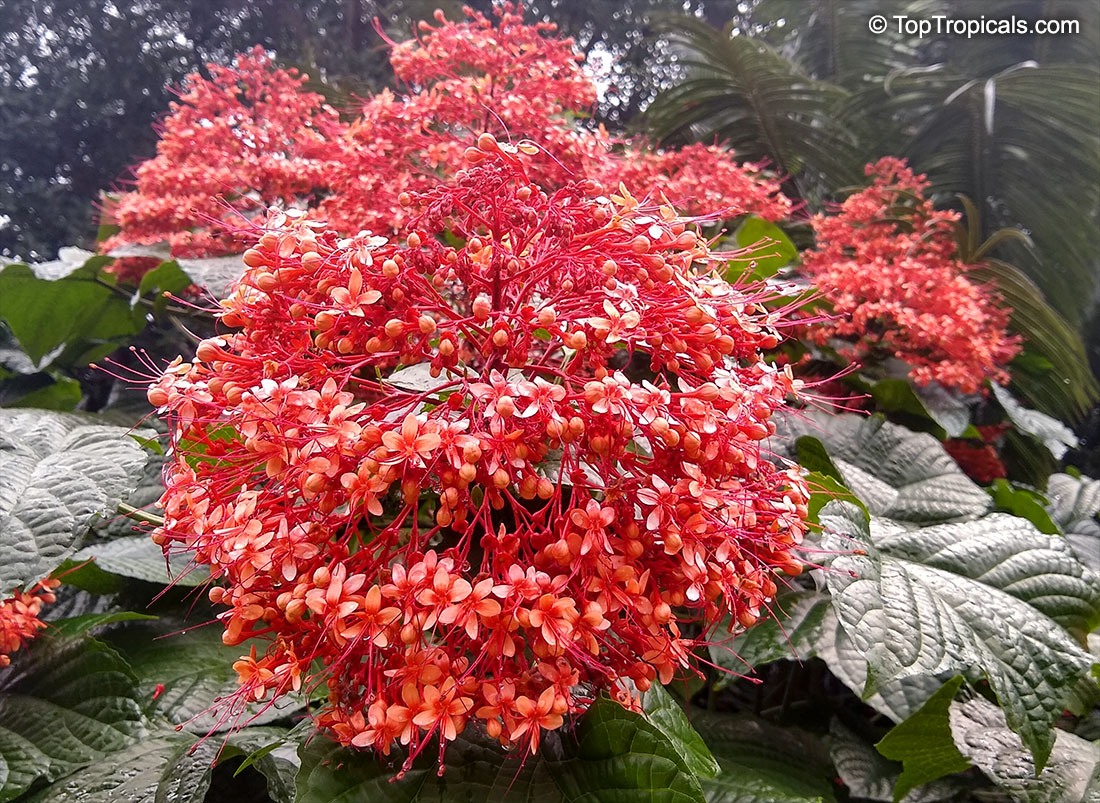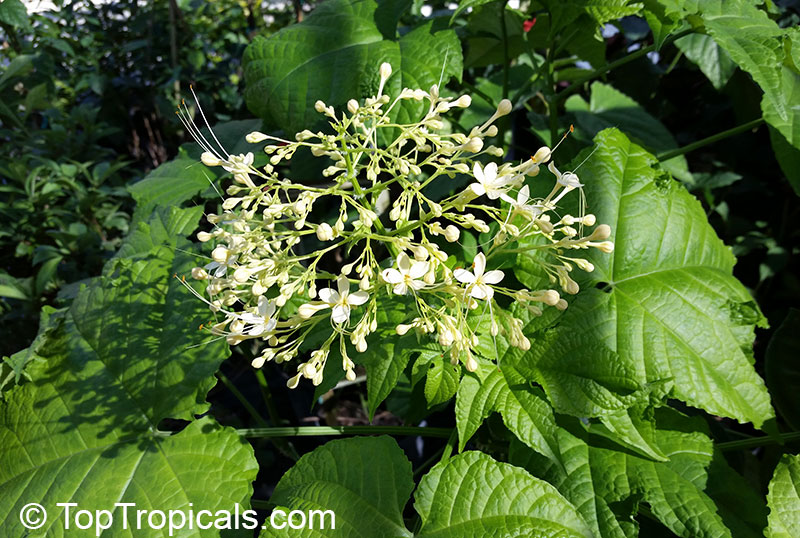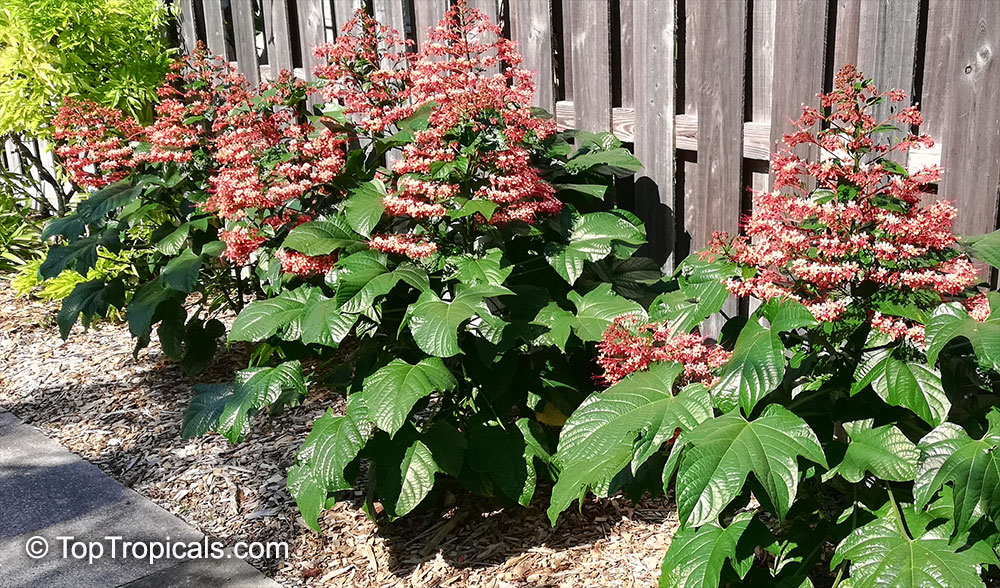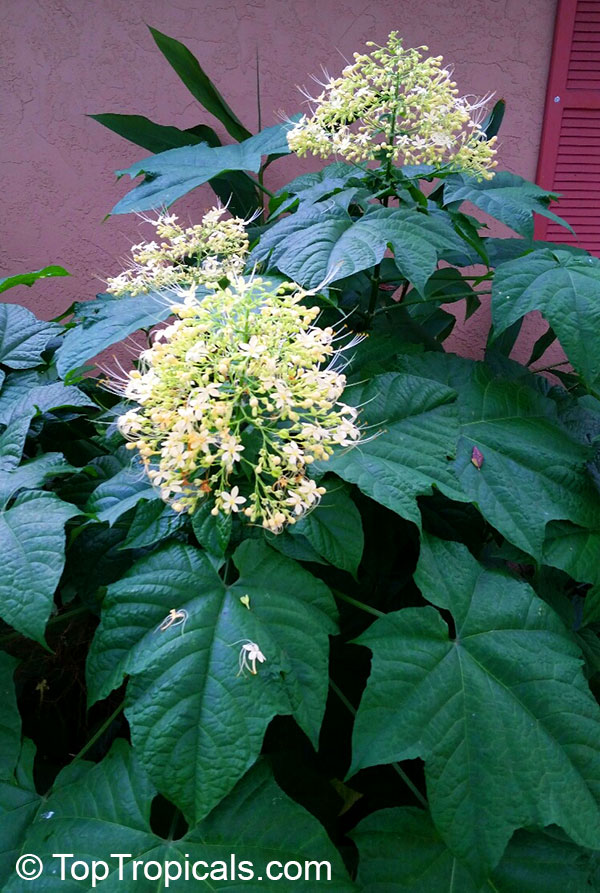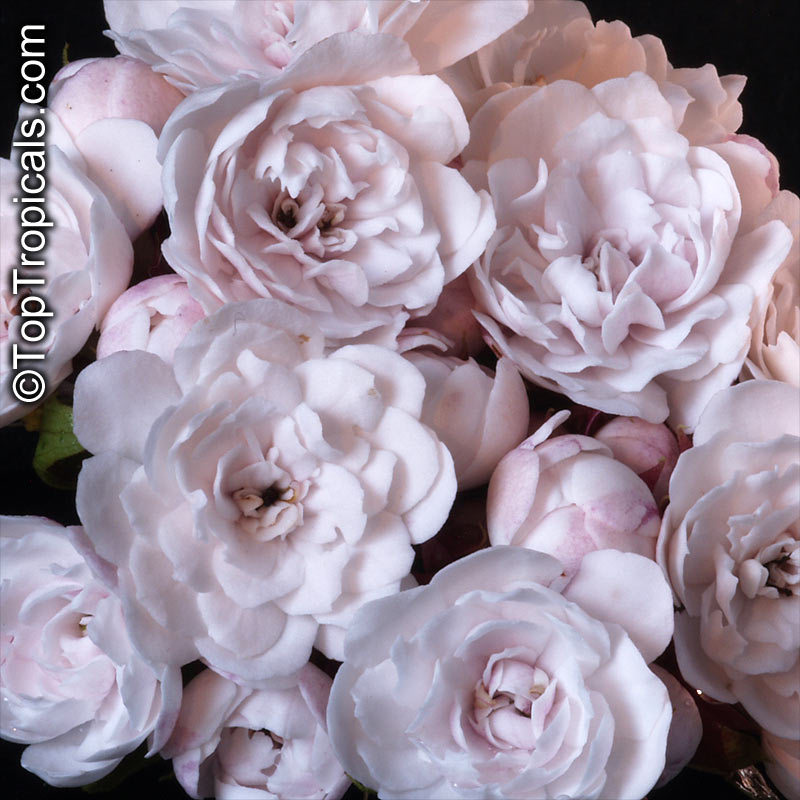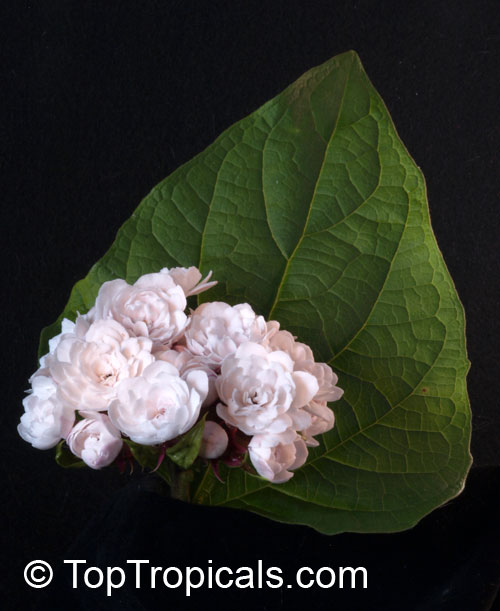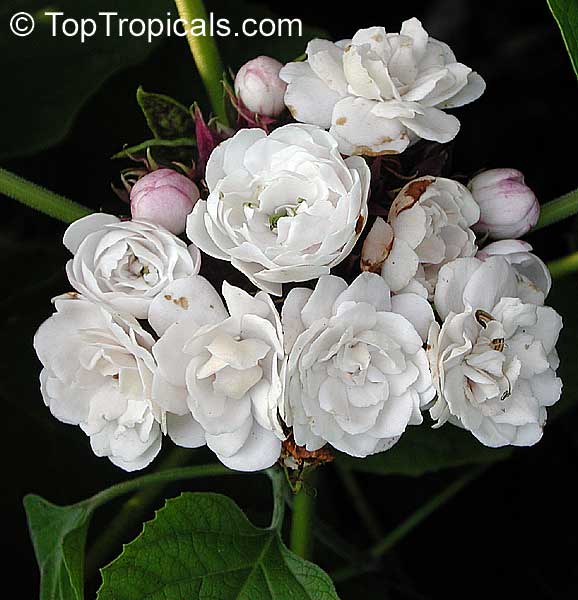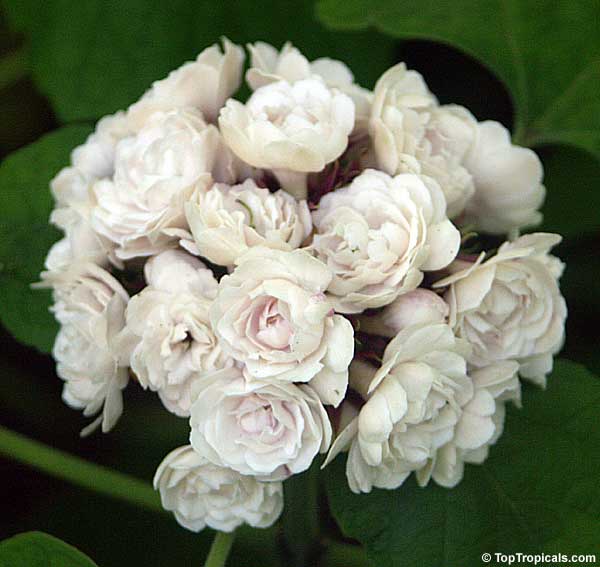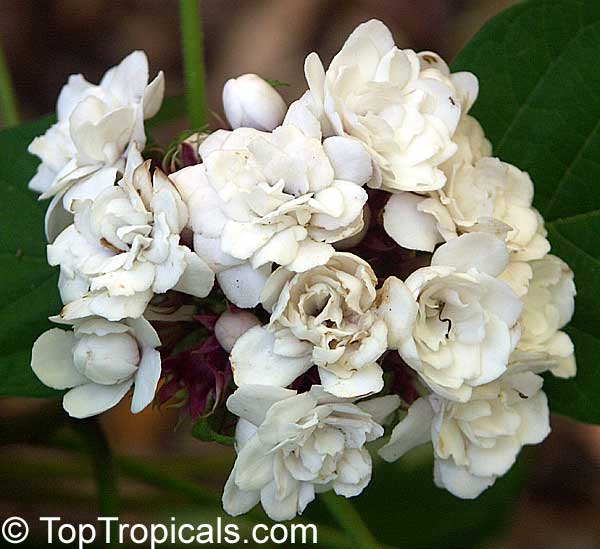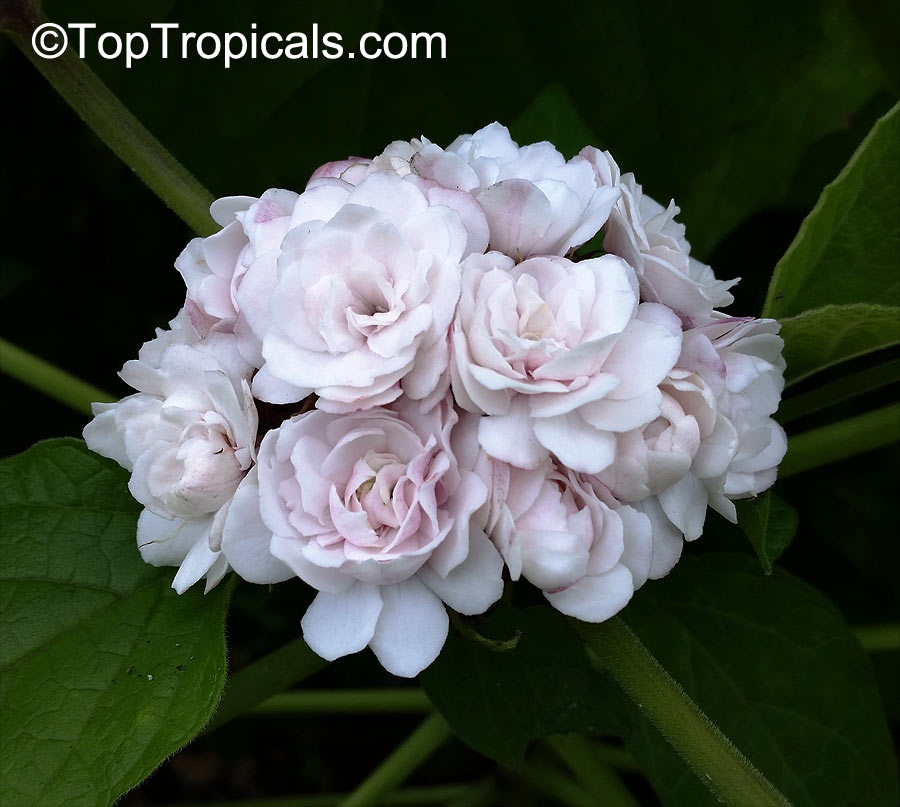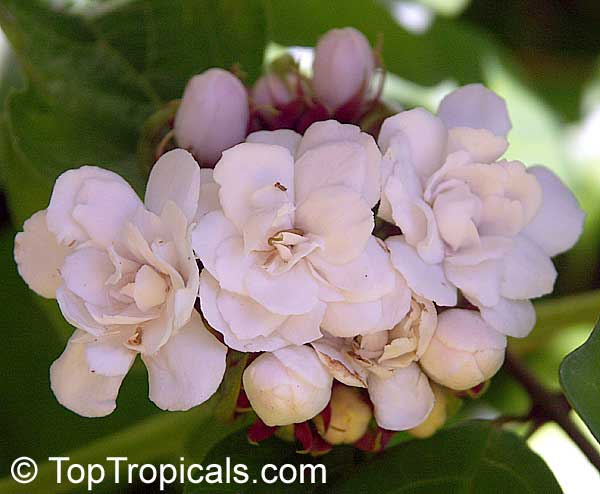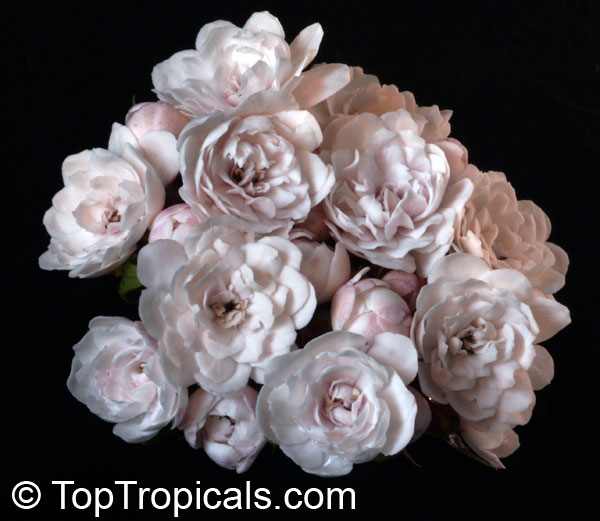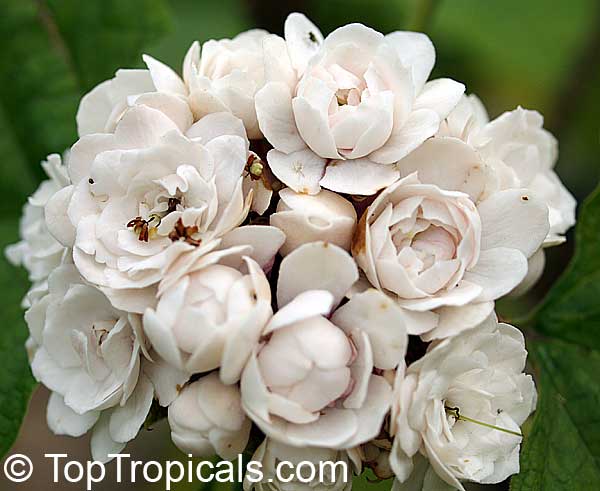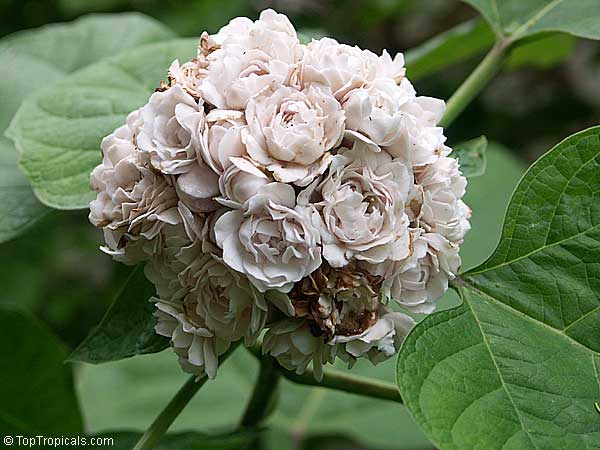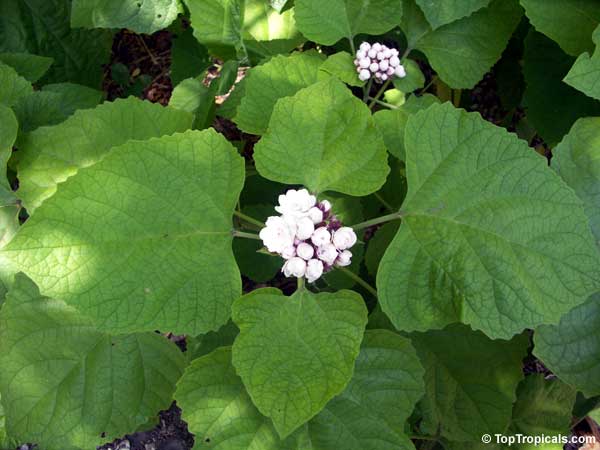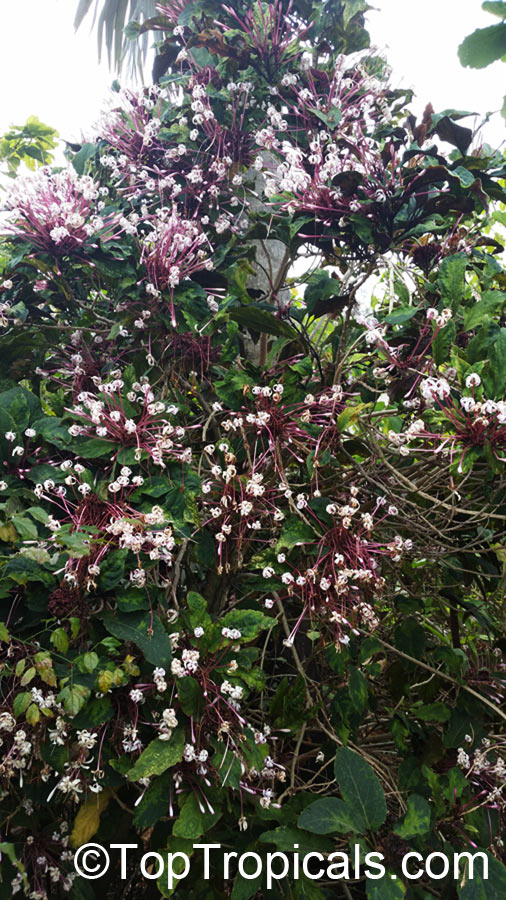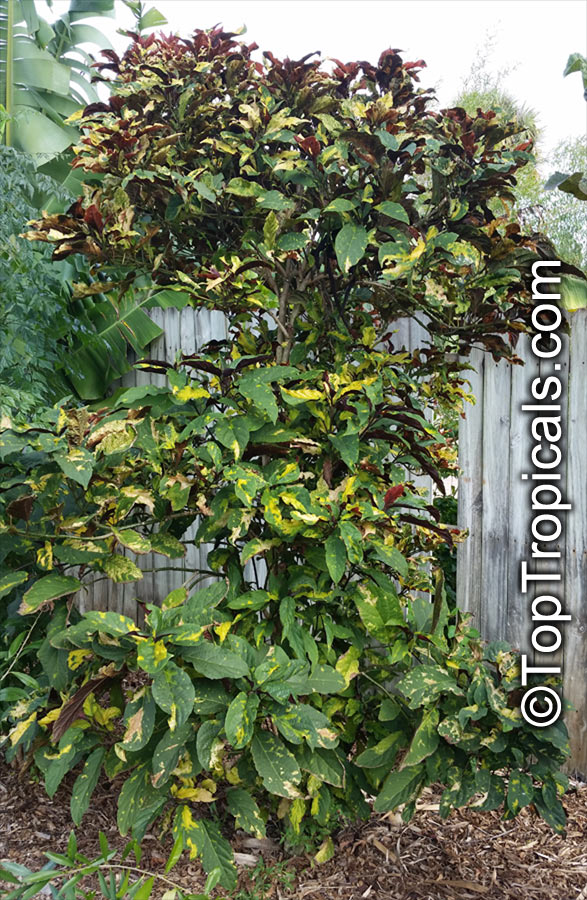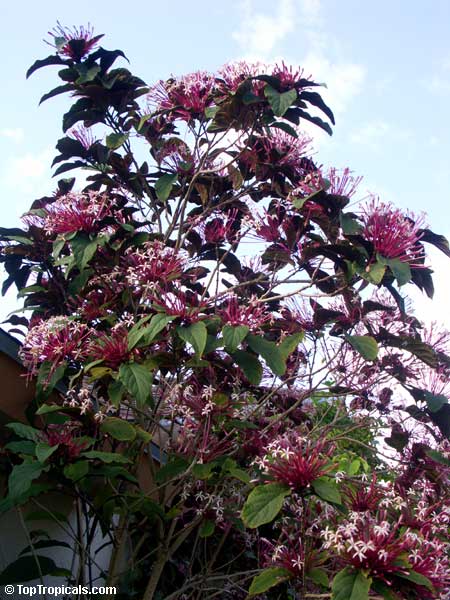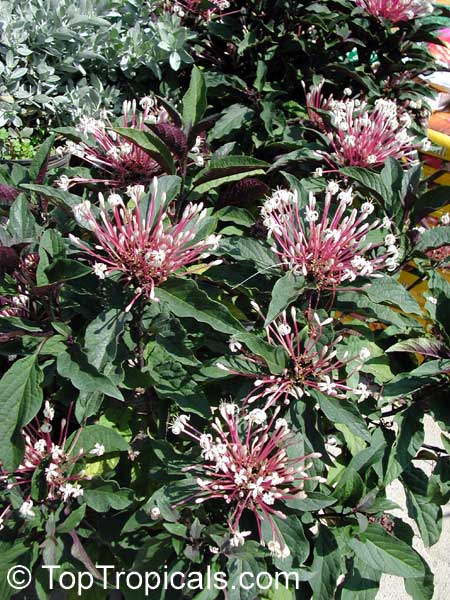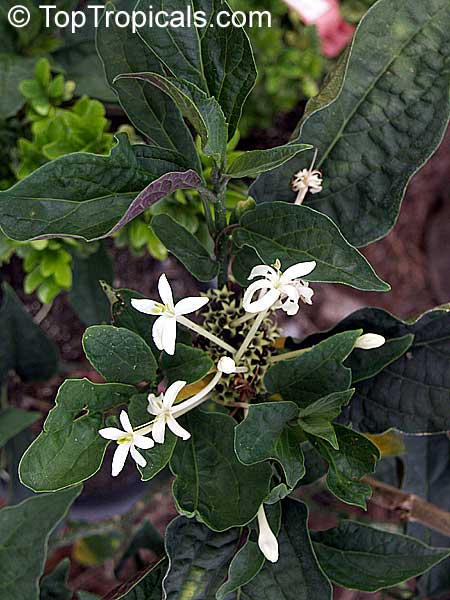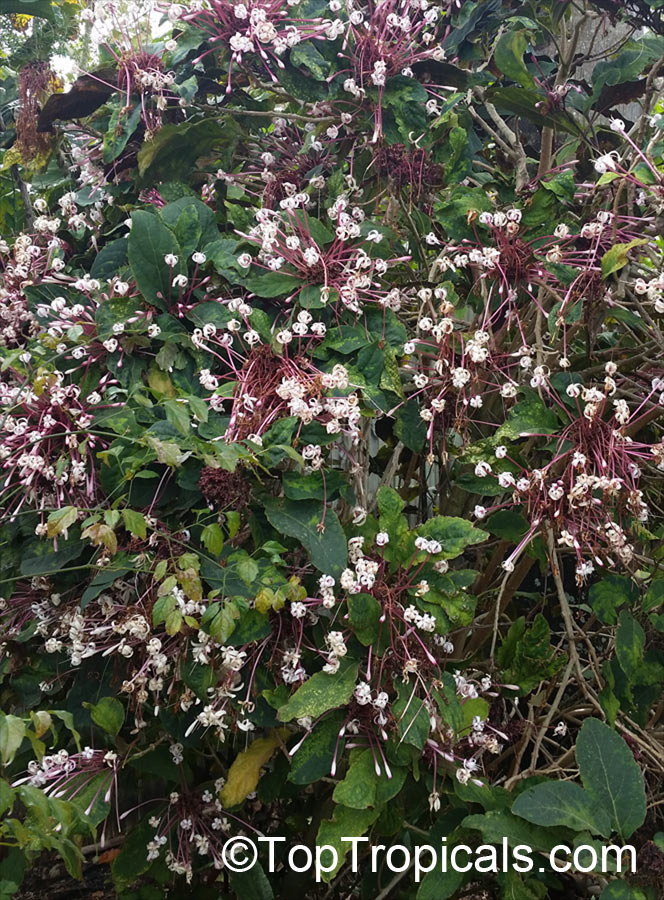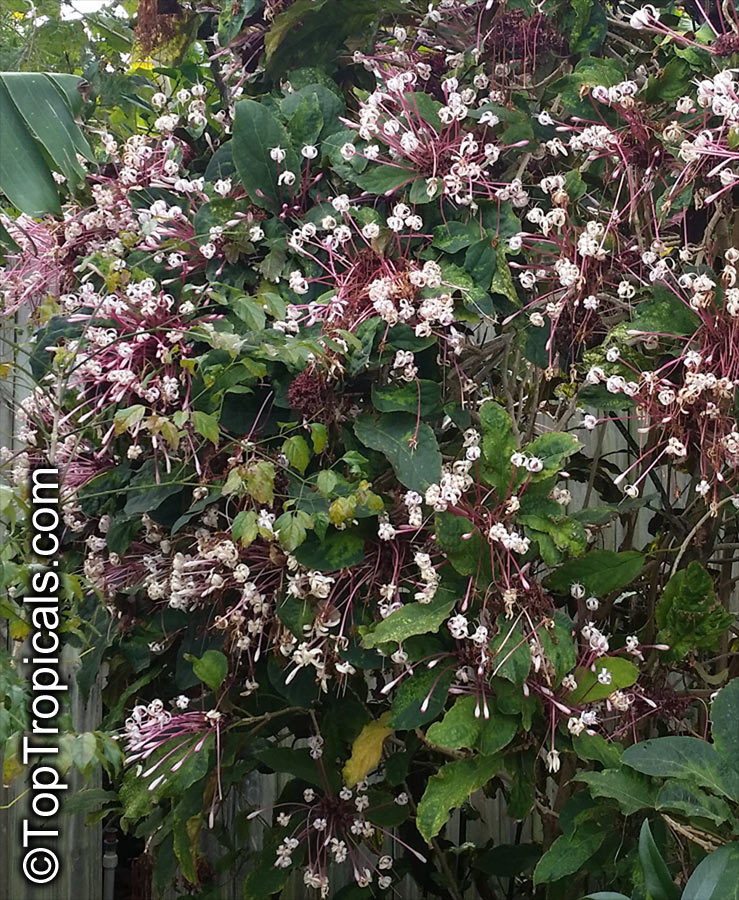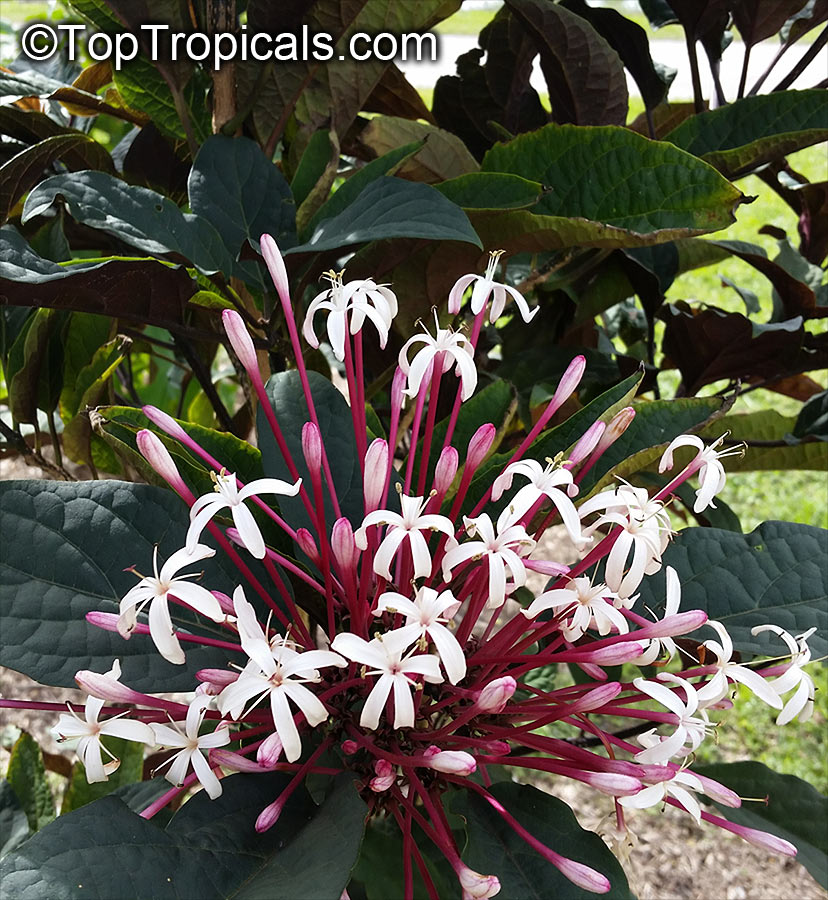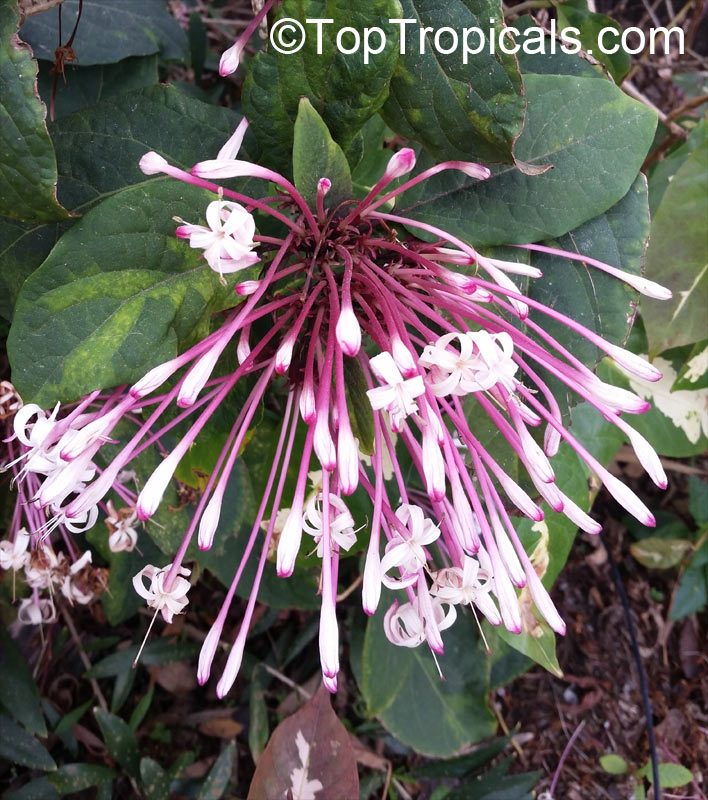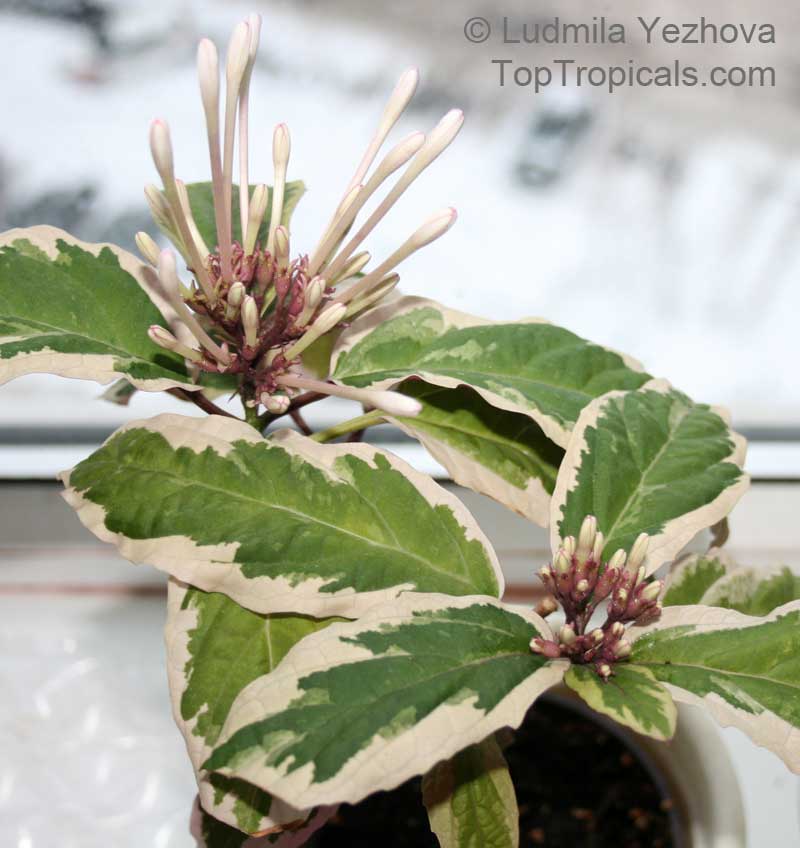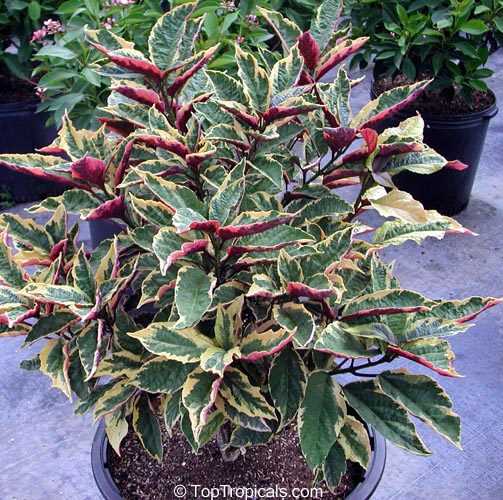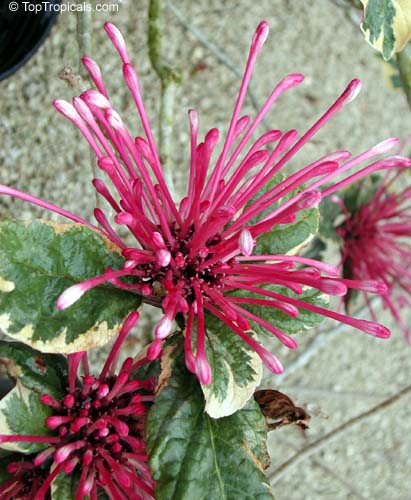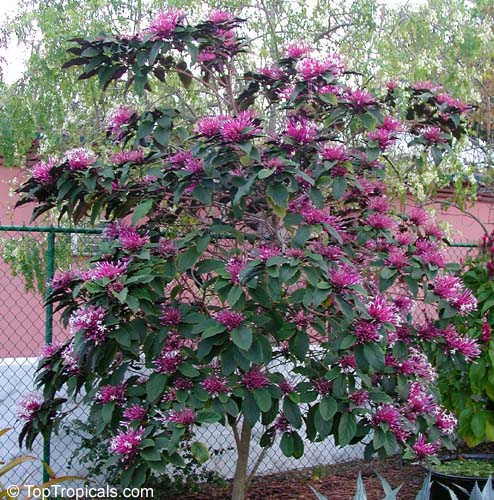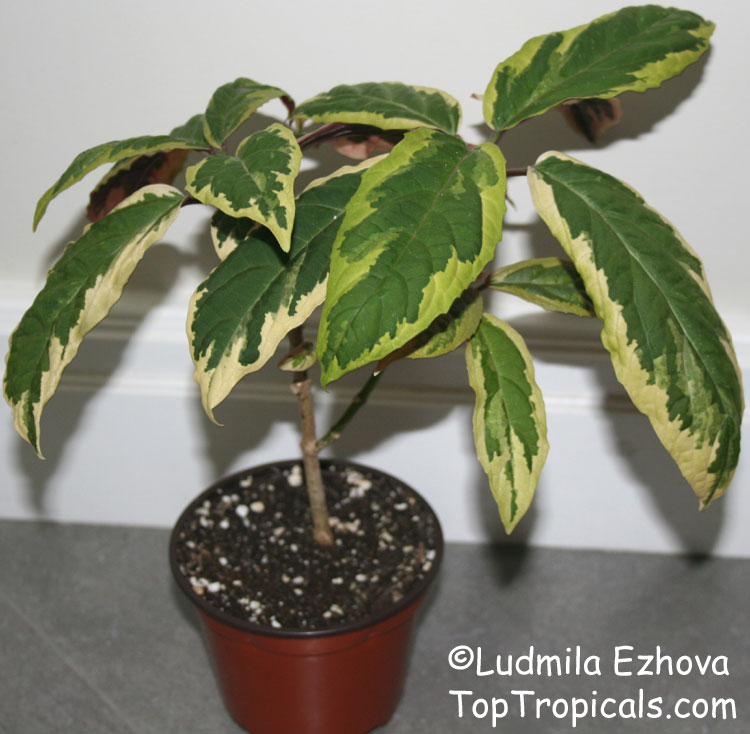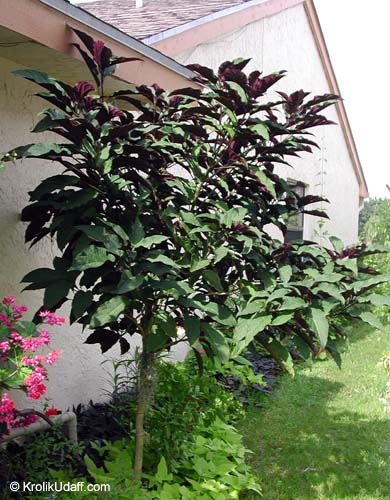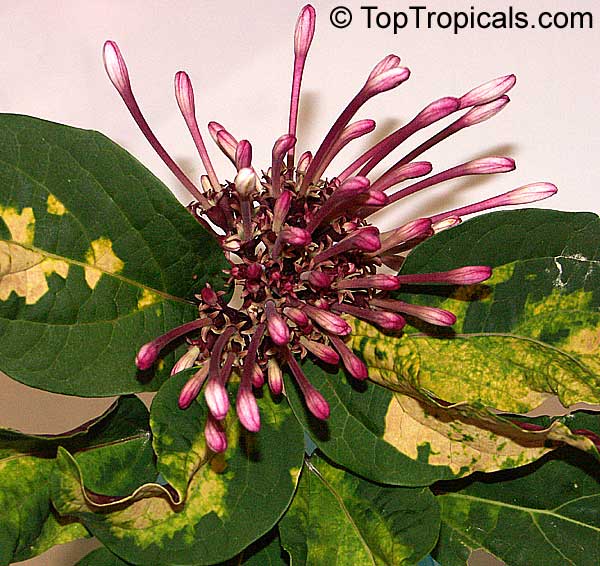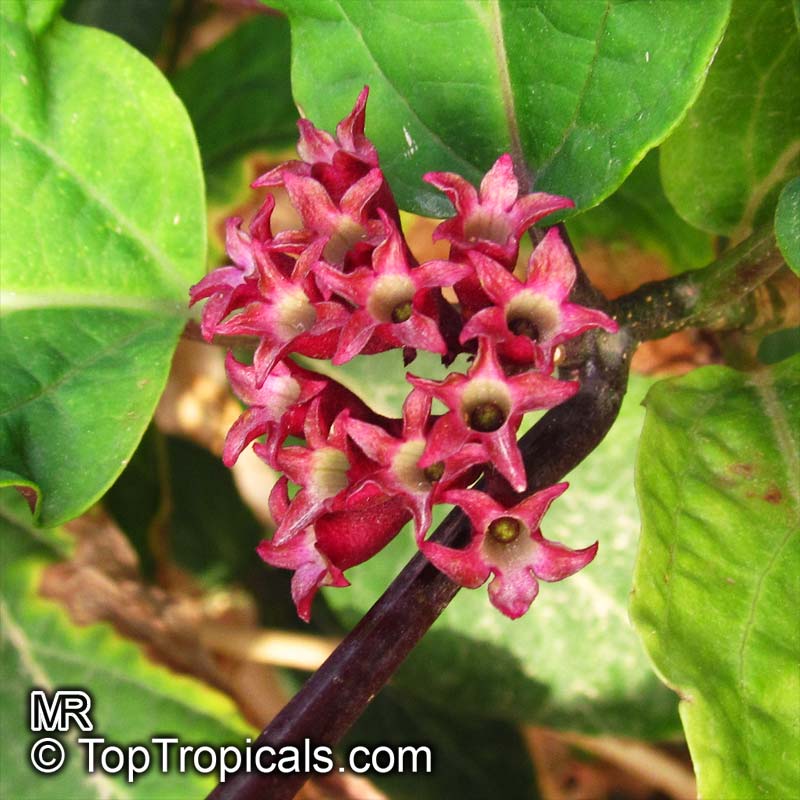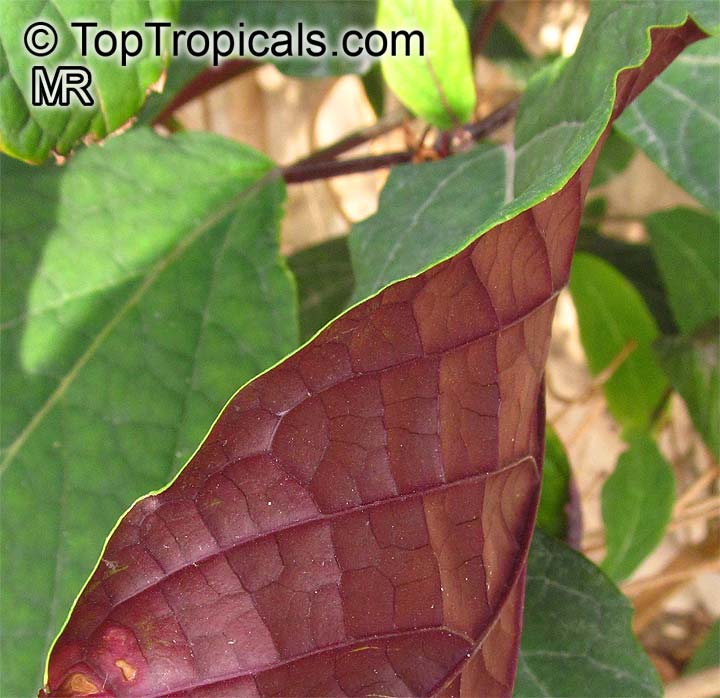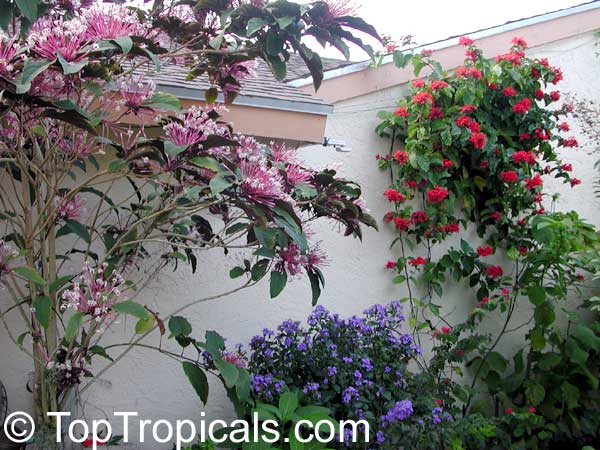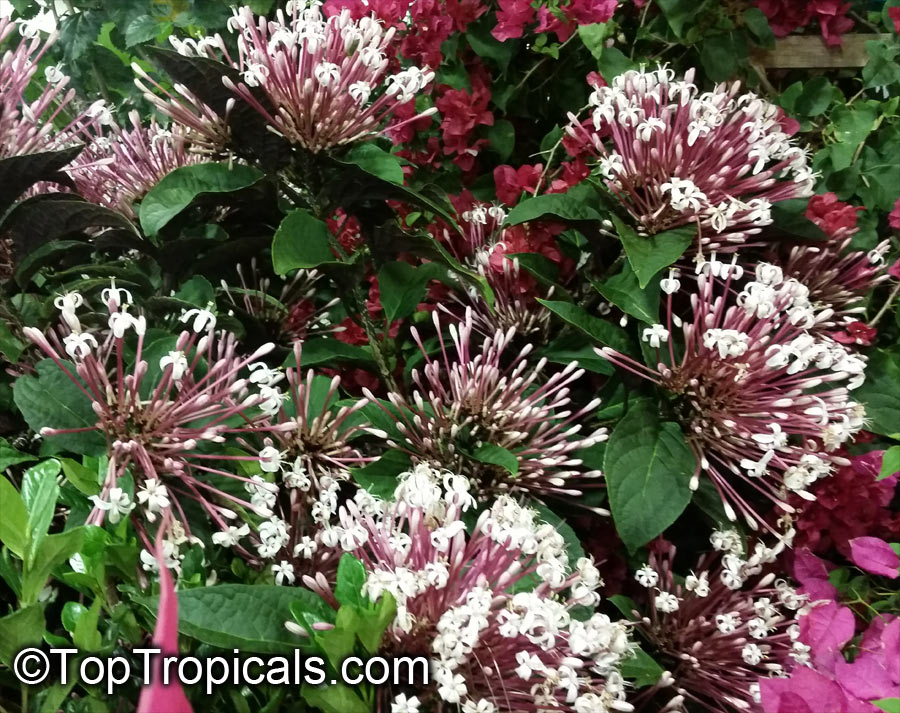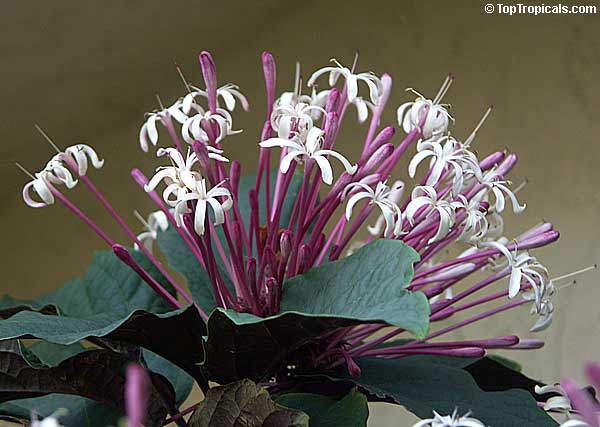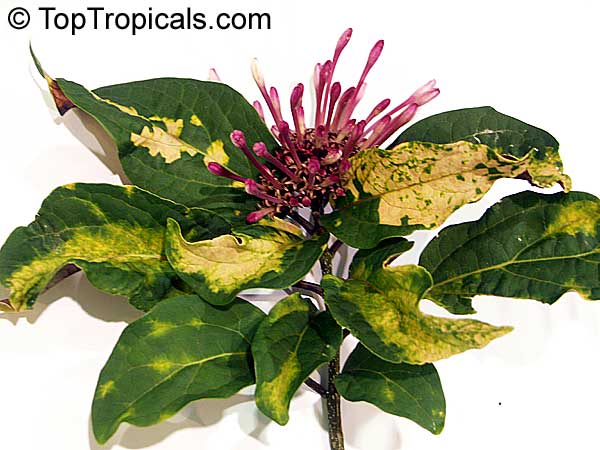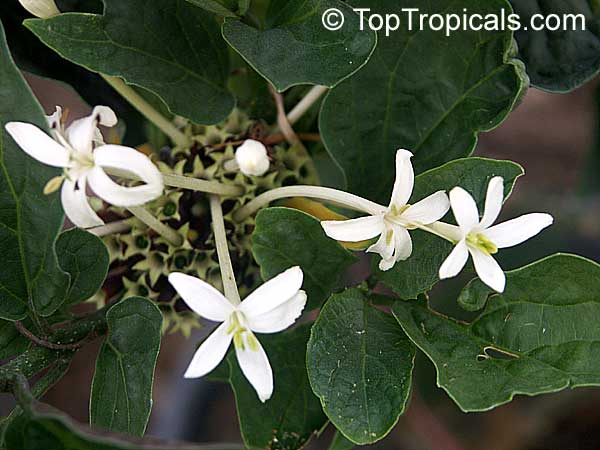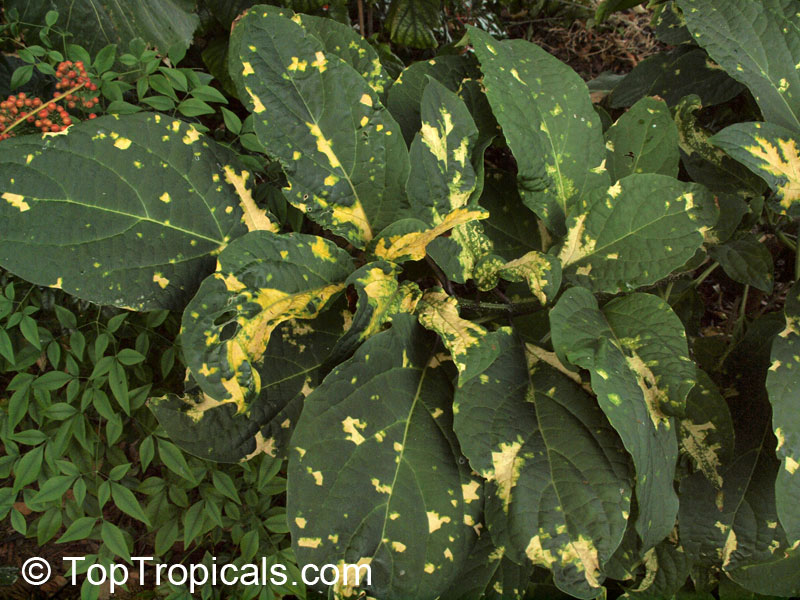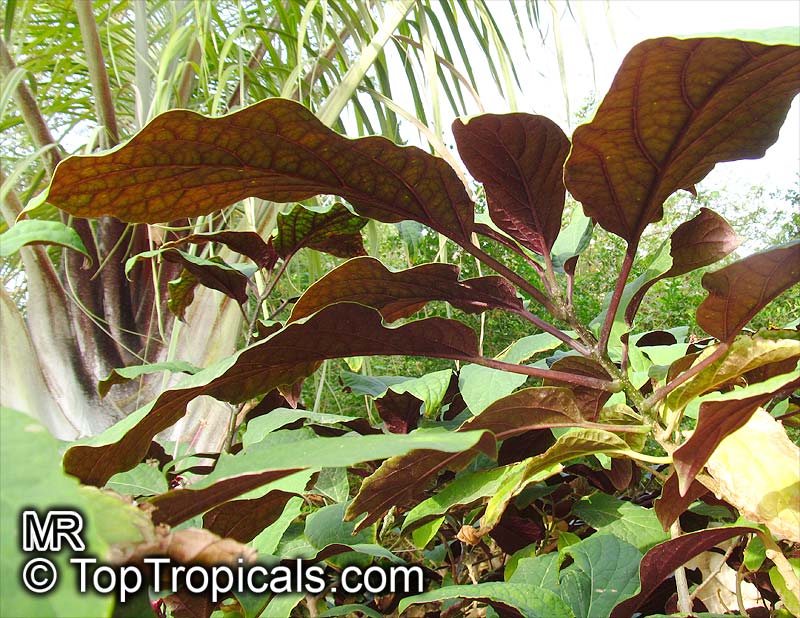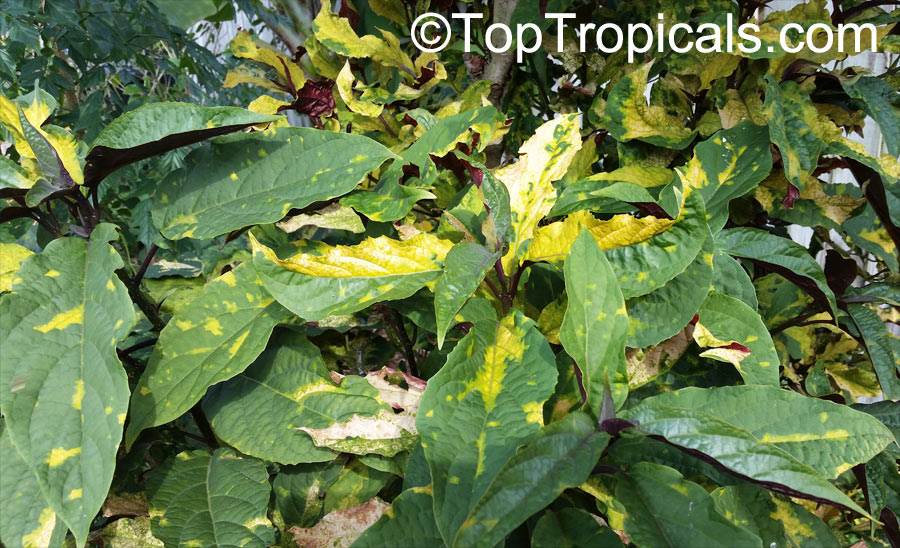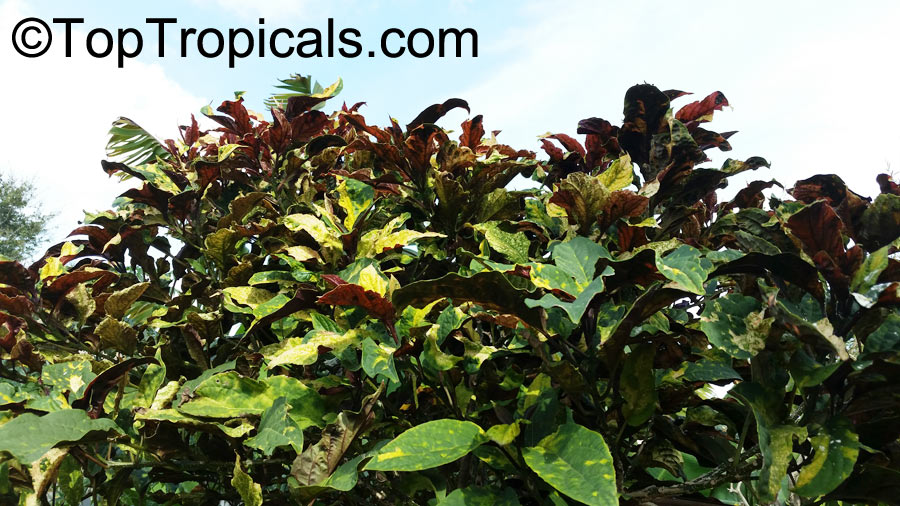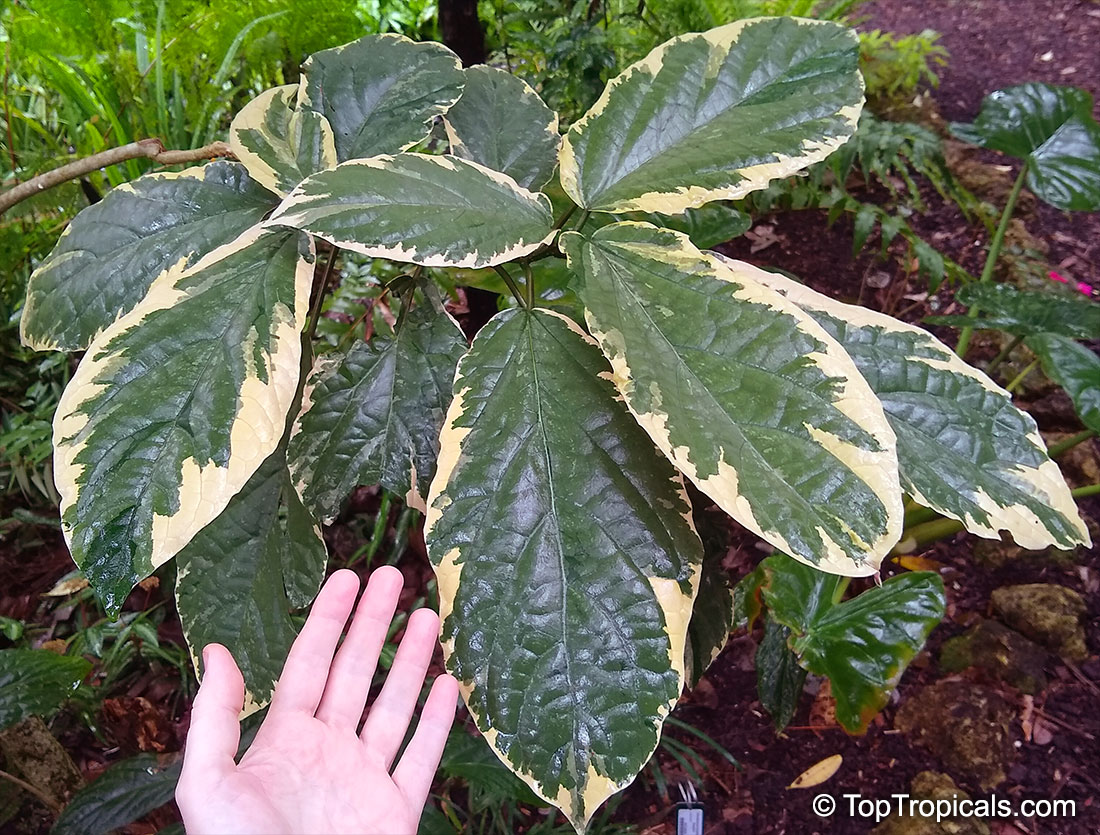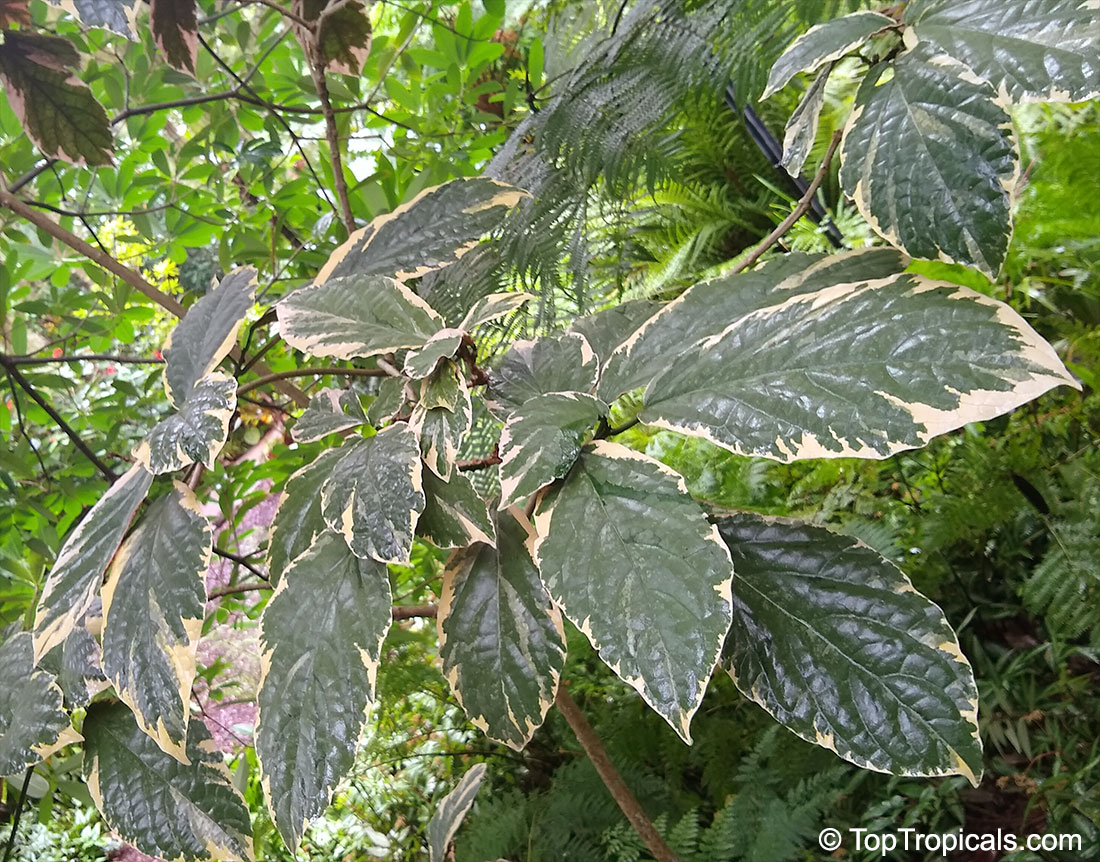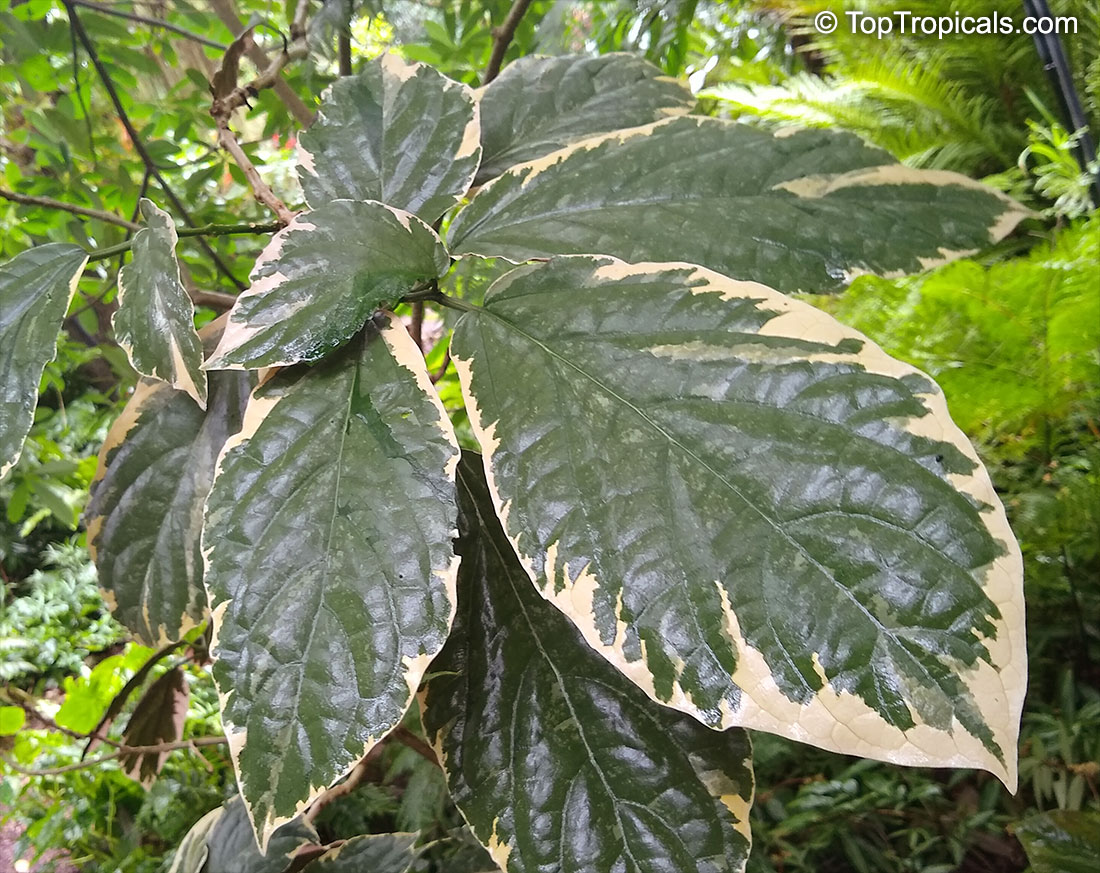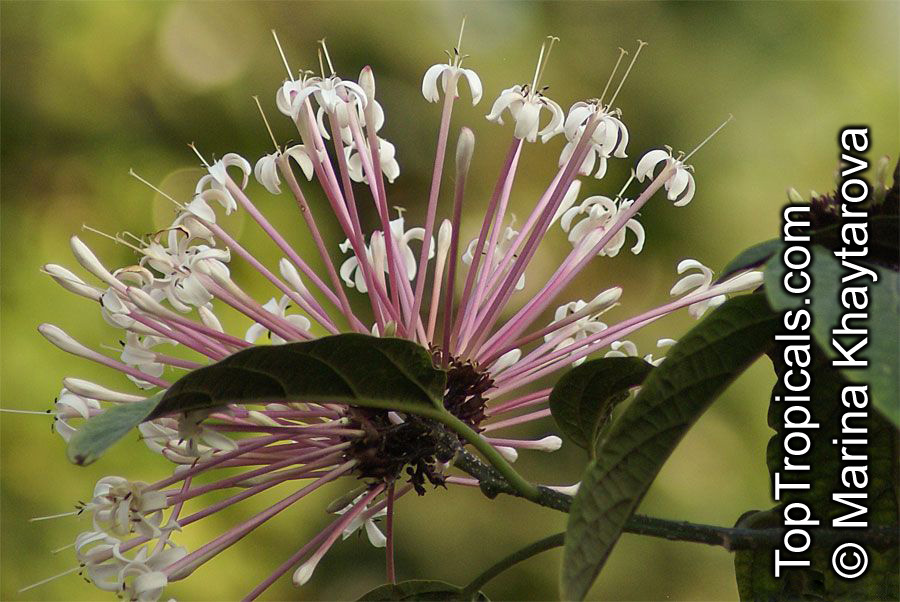Clerodendrum - Plant Encyclopedia Results
Top Tropicals Plant Encyclopedia
| Number of plants found: 21 | Next | 
|
Go to page: | 1 | 2 | 3 |
Botanical name: Clerodendrum bungei
Common names: Cashmere (Cashmir) bouquet, Glory Bower, Clerodendron
Family: Lamiaceae (Formerly:Verbenaceae)
Origin: China
Hardiness: 15°F










Dark green leaves often tinged purple are up to 8 inches long. The fragrant purple-red flowers are in terminal panicles up to six inches across. The plant is tolerant to sun and semi-shade. It is an ideal candidate for the container grown Patio Plant. Clerodendrum bungei Pink Diamond is very fragrant and will attract butterflies to the large flower trusses.
Enjoy clusters of sweetly scented, pink flowers that attract butterflies and other pollinators. They open in terminal panicles up to six inches across. Dark green leaves often tinged purple are up to 8 inches long. This plant can be grown as a compact shrub or allowed to spread. This plant is incredibly vigorous and fast-growing, spreading quickly through root suckers. If you don t want it to take over your yard in just one season, make sure to plant it in a contained corner or a container. Hardy and Resilient: Cashmere Bouquet is hardy to USDA Zones 8-10 and can tolerate light freezes, rejuvenating each spring.
It thrives in full sun to part shade and is drought-tolerant once established. Keep the soil moist during the growing season. Regular pruning helps maintain its shape and encourages more blooms.
Recommended Fertilizer: SUNSHINE Pikake - Fragrant Flower Booster
Botanical name: Clerodendrum calamitosum
Common name: White Butterfly Bush
Family: Lamiaceae (Formerly:Verbenaceae)
Origin: Java









This clerodendrum is a small to medium size shrub with beautiful butterfly-shaped flowers, similar to Clerodendrum ugandense (Blue Butterfly Bush) and Clerodendrum mastacanthum (Pink Butterfly Bush) . They are slightly fragrant during evening hours. Blooms from late winter to fall in warm areas.
Botanical names: Clerodendrum heterophyllum, Clerodendrum aculeatum
Common names: Tree of little stars, Escambron, Tamourette
Family: Lamiaceae (Formerly:Verbenaceae)










Clerodendrum heterophyllum (Tree of little stars) grows in full sun or semi-shade and prefers soil that is a bit acidic.
It is a large shrub, 5 - 10 ft tall, is tolerant to most soil types and can survive in USDA Zone 9-11. It produces white, off-white flowers that are slightly fragrant. It has a rather thorny or spiny character that adds to its beauty. Its nickname, Tree of little starsâ, is quite befitting since this plant looks like a thousand stars when in bloom.
Growth is easy with little care, as long as regular watering is maintained. In cold regions, it can be grown in pots and placed in sheltered areas. This shrub is attractive to both butterflies and hummingbirds. It also has ethnomedical applications for treating a few ailments.
To maintain the aesthetic beauty of this shrub, light pruning is recommended every now and then. When pruning, it is important not to prune too much off and always maintain a uniform shape. The plant should be fertilized throughout the growing season, around once a month.
Overall, Clerodendrum heterophyllum is a great choice for a low-maintenance garden shrub that is sure to attract the attention of both butterflies and hummingbirds.
Botanical names: Clerodendrum inerme, Volkameria inermis
Common names: Wild Jasmine, Sorcerers Bush, Seaside clerodendrum, Clerodendron
Family: Lamiaceae (Formerly:Verbenaceae)
Origin: India, Malaysia










Clerodendrum inerme is a hardy shrub that can thrive in a variety of environments. In milder winters, they can be planted in the garden with no protection. However, for areas with harsher winters, it is recommended to plant the shrub in a pot and bring it indoors when temperatures drop below freezing.
When caring for clerodendrums, it is important to water the plant regularly, but only when the soil is dry. In spring and summer, fertilize the plant with a general purpose fertilizer and apply mulch to conserve moisture. This shrub is native to Tropical Asia. It is also an evergreen mangrove plant that can thrive near the ocean at the high tide mark, making it a potential weed in the coastal environment.
Clerodendrum inerme is a sun-loving plant that reaches a height of 10-15 ft with closely arranged, almost round, shiny, deep green leaves. The plant is always in flower, with white and fragrant flowers that have spreading five corolla lobes and long purple stamens. The stems of this plant are smooth and do not have thorns, hence the specific name inerme, which means thornless.
This plant is versatile and can be grown as a topiary or bonsai. It is also salt-, heat-, and wind-tolerant, making it well-suited for growth along the beach where it can tolerate the salt spray of the ocean and the harsh rays of the sun. It can be grown as a hedge, but a large number of well-developed plants are needed. Trimming the plant keeps the hedge in shape, but also robs the plant of its flowers as they are produced at the ends of branches.
Botanical names: Clerodendrum laevifolium, Clerodendrum wallichii, Clerodendrum nutans
Common names: Bridal veil, Nodding Clerodendron
Family: Lamiaceae (Formerly:Verbenaceae)
Origin: India, Nepal








This graceful shrub grows up to 7 ft and has pointed narrow leaves 4 to 9 inches long. The white fragrant flowers are held in loose panicles, which are more or less pendulous. Cascades of flowers appear around Thanksgiving. Keep it out of the wind, and avoid putting it where it will get late afternoon sun. Blooming in fall-spring. The genus Clerodendrum consists of over 450 species of trees or shrubs, sometimes climbing, native to the tropics, but mostly to the Eastern Hemisphere. The name is derived from the Greek kleros, chance, and dendron, a tree, and is supposed to be in reference to the variable medicinal qualities of certain plants belonging to this genus.
Recommended Fertilizer: SUNSHINE Megaflor - Bloom Nutrition Booster
Botanical names: Clerodendrum mastacanthum, Rotheca mastacantha, Rotheca mastacanthus, Rotheca macrodonta
Common name: Pink Butterfly Bush
Family: Lamiaceae (Formerly:Verbenaceae)
Origin: Africa







A new plant in cultivation originated from South Africa. It is very similar to more common species Clerodendrum ugandense (Blue Butterfly Bush) other than color and smaller size of the flowers which are in tighter panicles.
It grows into a vigorous large size bush with multiple stems. Unlike most clerodendrums, it is very difficult to propagate and cuttings don't root very easily. Small plants grow very slowly but even at 1 ft tall they start flowering. Once etablished, the bush grows fast, producing many branches.
Cultivation is pretty simple and the plant needs only average maintenance - regular water and well drained soil. It needs full sun for flowering. Pink Butterfly Bush is more cold sensitive than Blue Butterfly Bush (C. ugandense). However even after a cold snap and leaf damage, plants regrow well from the main stems.
Originally we have obtained this plant in 2014 from a rare plant collector, and have been propagating it since. It came to us under name of Rotheca mastacantha. The name Rotheca is often used for plants in Clerodendrum genus.
Recommended Fertilizer: SUNSHINE Megaflor - Bloom Nutrition Booster
Botanical name: Clerodendrum minahassae
Common names: Fountain Clerodendrum, Clerodendron, Tube Flower
Family: Lamiaceae (Formerly:Verbenaceae)






Beautiful free branching shrub with clusters of white flowers, resembling fountain. Fast growing. Very showy small fruit is deep blue (egg-plant) color, appears in the middle of red-petaled bract and creates unusual decorative effect. Unlike most of clerodendrums, this one is hard to propagate and is very rare in culture.
Recommended Fertilizer: SUNSHINE Megaflor - Bloom Nutrition Booster
Recommended Fertilizer: SUNSHINE Megaflor - Bloom Nutrition Booster
Ordering seeds info
RECOMMENDED SUPPLIES:
Seed Germination Mix #3, professional grade
SUNSHINE-Epi - Seeds and cuttings booster
SUNSHINE Bombino - Young Plant Booster
Botanical name: Clerodendrum paniculatum
Common names: Pagoda Flower, Orange Tower Flower, Clerodendron
Family: Lamiaceae (Formerly:Verbenaceae)
Origin: India, Sri Lanka, Malaysia









Clerodendrum paniculatum (Pagoda Flower) is an interesting and eye-catching large shrub native to India, Sri Lanka, and Malaysia. It grows best in full sun to semi-shade and needs regular water to look its best. The showy blooms are what make it so special, they are white, off-white, red, crimson, and vinous as well as yellow and orange in color. The flowers are funnel-shaped with long tubes and sit in pyramid-shaped clusters. The impressive display of blooms last from summer through autumn, and in frost free climates it will sporadically bloom throughout the year.
This fast growing plant grows to 5-10 feet tall, spreading 2-3 feet across, with multiple stems and large evergreen leaves. Each leaf is 12 inches across and has a heart-shaped base. The Pagoda flower also has the added bonus of being attractive to butterflies and hummingbirds.
The Pagoda flower is hardy in USDA Zones 8-11 and can survive temperatures as low as 30°F for a short time. When growing in colder regions, it is best to keep the plant in a pot and move it indoors during colder months. Pagoda flower does its best when planted in a rich, slightly moisture retentive soil. With proper care, it can become a beautiful feature in any garden space.
Recommended Fertilizer: SUNSHINE Megaflor - Bloom Nutrition Booster
This item can not be shipped. Pick up only. We can provide local delivery around Ft. Myers or Sebring, Florida. Contact us for an estimate. Non-pickup orders are subject to restocking fees.
Recommended Fertilizer: SUNSHINE Megaflor - Bloom Nutrition Booster
Botanical names: Clerodendrum philippinum, Clerodendrum fragrans pleniflorum, Clerodendrum chinense, Volkameria fragrans
Common names: Chinese Glory Bower, Cashmere bouquet, Scent Malli, False Pikake, Glory Tree, Clerodendron
Family: Lamiaceae (Formerly:Verbenaceae)
Origin: China, Japan










Native to China and Japan, Clerodendrum philippinum (Chinese Glory Bower) is an attractive large shrub that can reach heights of 5-10 ft tall. It thrives in sunny and semi-shaded spots, with regular waterings to support its growth. The shrub's flowers are a sight to behold as they are intricately pink, white, or off-white in color, and have a sweet fragrance that will attract both hummingbirds and butterflies.
In terms of growing conditions, this plant prefers to be grown in USDA Zone 9-11. If a colder climate is present, it should be grown in a pot to provide it adequate protection. It is quite cold hardy and can withstand temperatures in the 30s F for a short period of time.
When planting Clerodendrum philippinum, care must be taken as it spreads rapidly across the ground as it sends out underground shoots so as to propagate itself. With such a charming appearance and strong appeal, it is essential to keep the plant under proper control by regularly trimming and pruning it. During cold winter seasons, it must be protected with a thick layer of mulch. Additionally, fertilizing with a balanced liquid fertilizer once a month during the growing season is also recommended for better growth.
With appropriate care and maintenance, it is easy to create an inviting and colorful landscape with Clerodendrum philippinum. It is an ideal shrub for gardeners who are looking to add a striking yet low-maintenance flowering plant to their garden.
Recommended Fertilizer: SUNSHINE Pikake - Fragrant Flower Booster
Botanical name: Clerodendrum quadriloculare
Common names: Winter Starburst, Fireworks, Clerodendron
Family: Lamiaceae (Formerly:Verbenaceae)
Origin: Philippines










Clerodendrum quadriloculare (Winter Starburst) is a native to the Philippines and is prized for its magnificent beauty. It grows to a height of between five to ten feet when in the form of a large shrub and up to twenty feet as a small tree. Winter Starburst is a perfect choice for those looking for a plant to create excitement and interest in their garden. It can be grown in full sun, shade, or semi-shade and require moderate water.
The beauty of Winter Starburst is truly mesmerizing. In late winter and early spring, it produces a flurry of pink to white, off-white colored flowers that burst into bloom. The explosion of blooms is truly stunning, with each flower head being 8-12 inches in diameter and made up of dozens of smaller 3-4 inch long flowers. The foliage is ornamental in shape, with a green top and strong purple underside.
Though Winter Starburst is usually grown outdoors in USDA Zones 8-10, it can also be grown in colder climates as a container or pot plant. If keeping this plant indoors, it's important to be aware of its needs and to provide it with the right conditions. The pot should be deep enough to allow for adequate root growth and should provide good drainage. The soil should remain consistently moist, so make sure not to let it get too dry. Sunlight for an indoor plant should be brightly filtered and the temperature should be kept between 60-70°F. Applying a slow-release fertilizer once a month will also help to encourage bloom and growth.
Recommended Fertilizer: SUNSHINE Megaflor - Bloom Nutrition Booster
| Next |  |
Use link to repeat this search:
https://toptropicals.com/cgi-bin/garden_catalog/cat.cgi?find=Clerodendrum&search_op=and&keyword_op=and&language=e&number=10
&no_change_lang=1&user=tt&sale=1&first=0
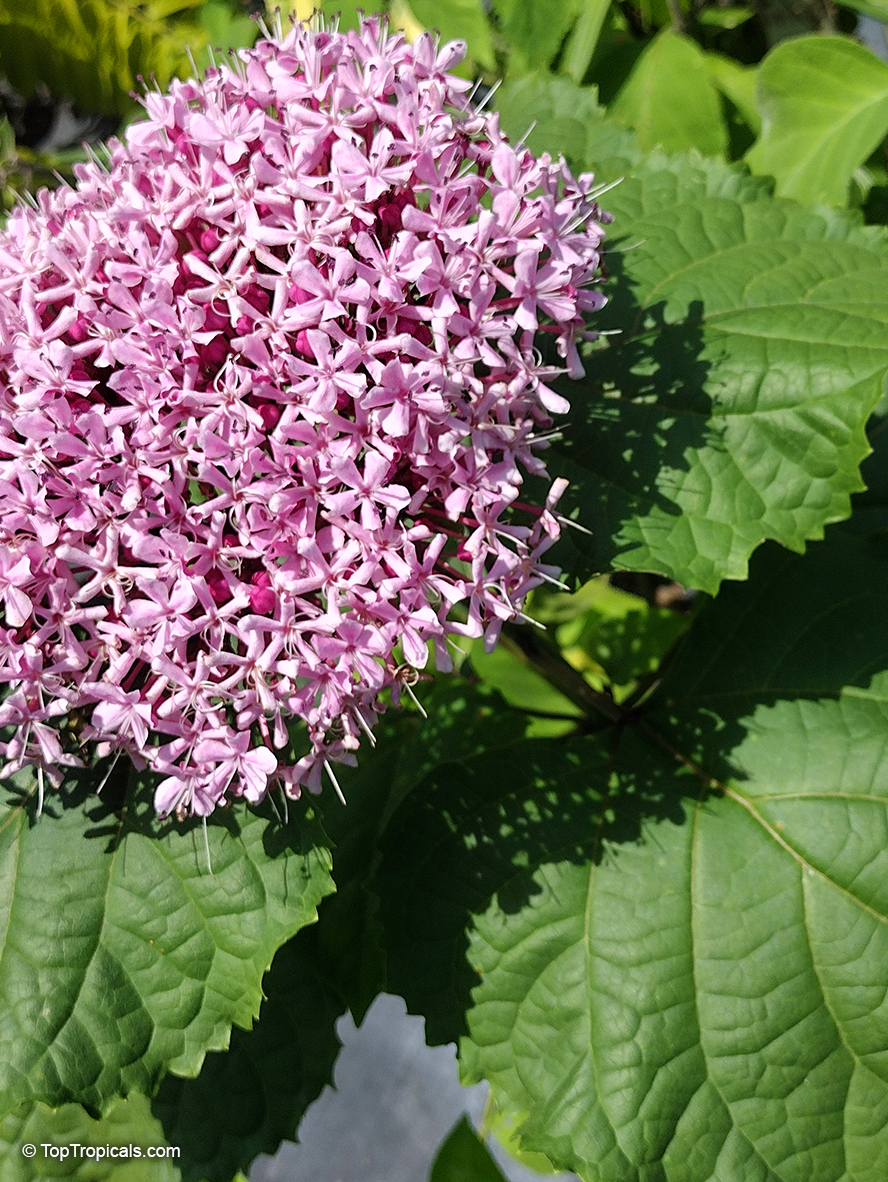
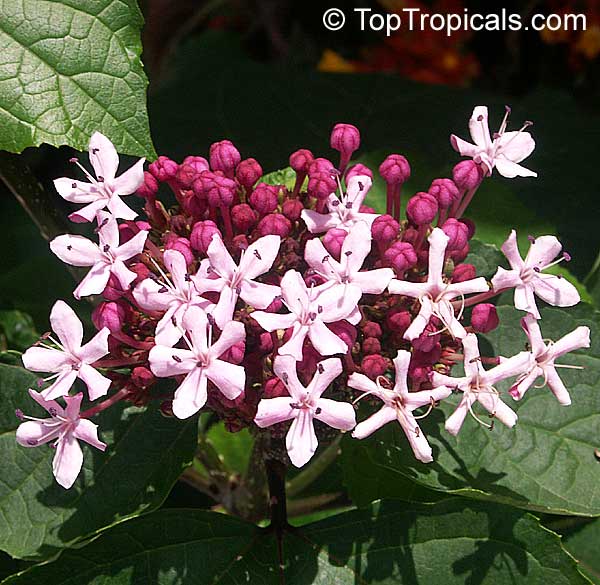
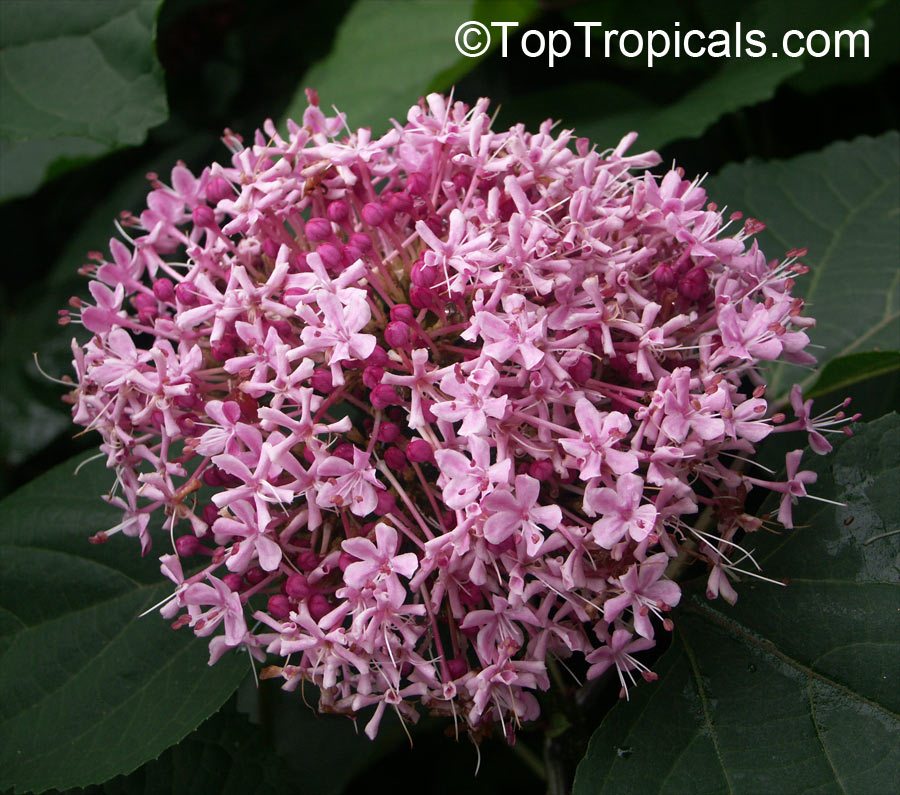
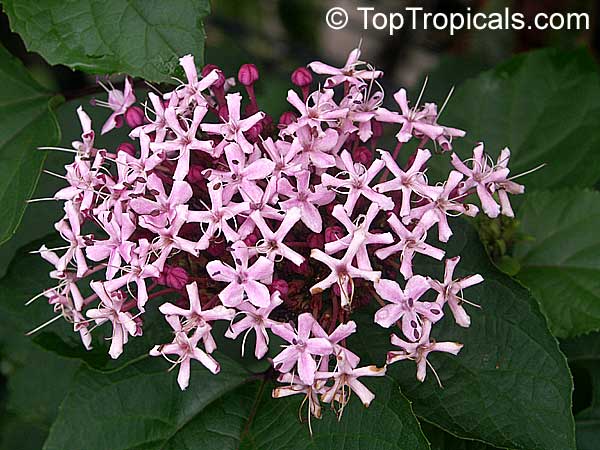
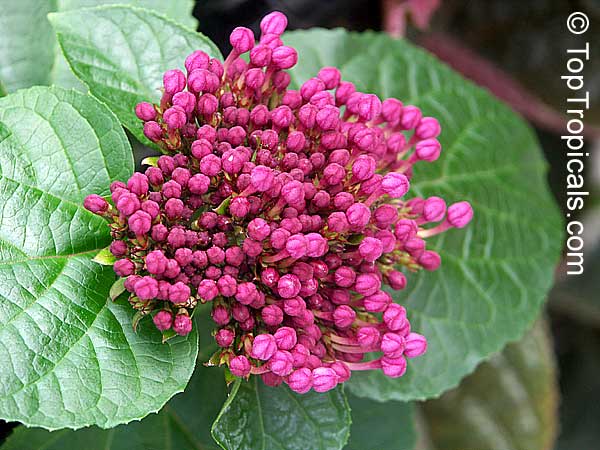
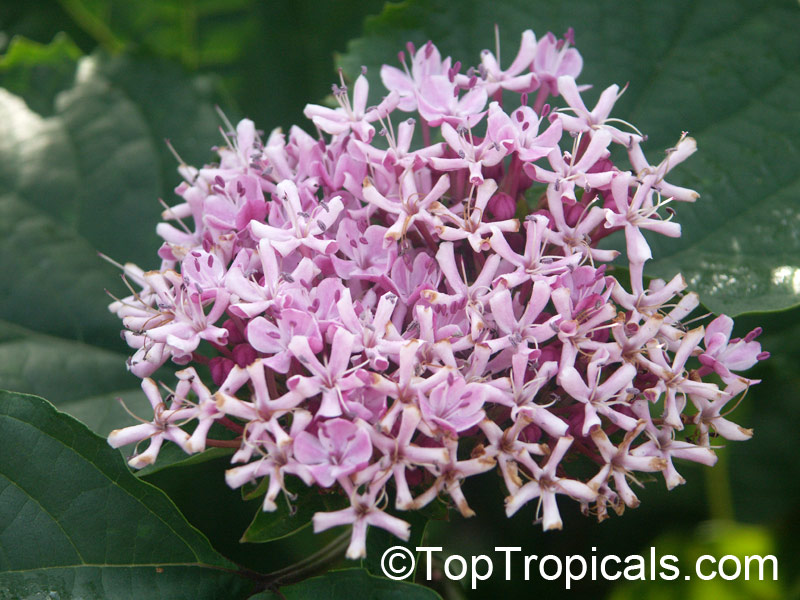
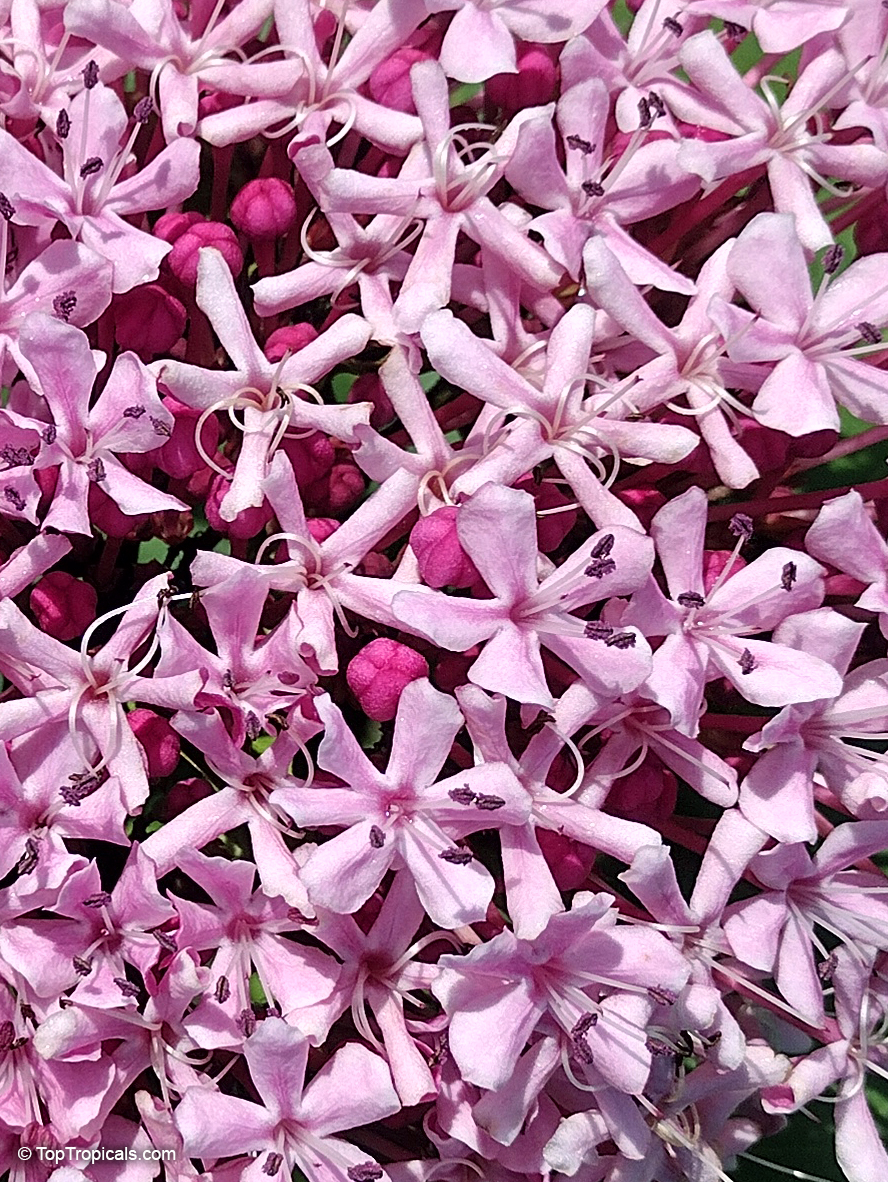
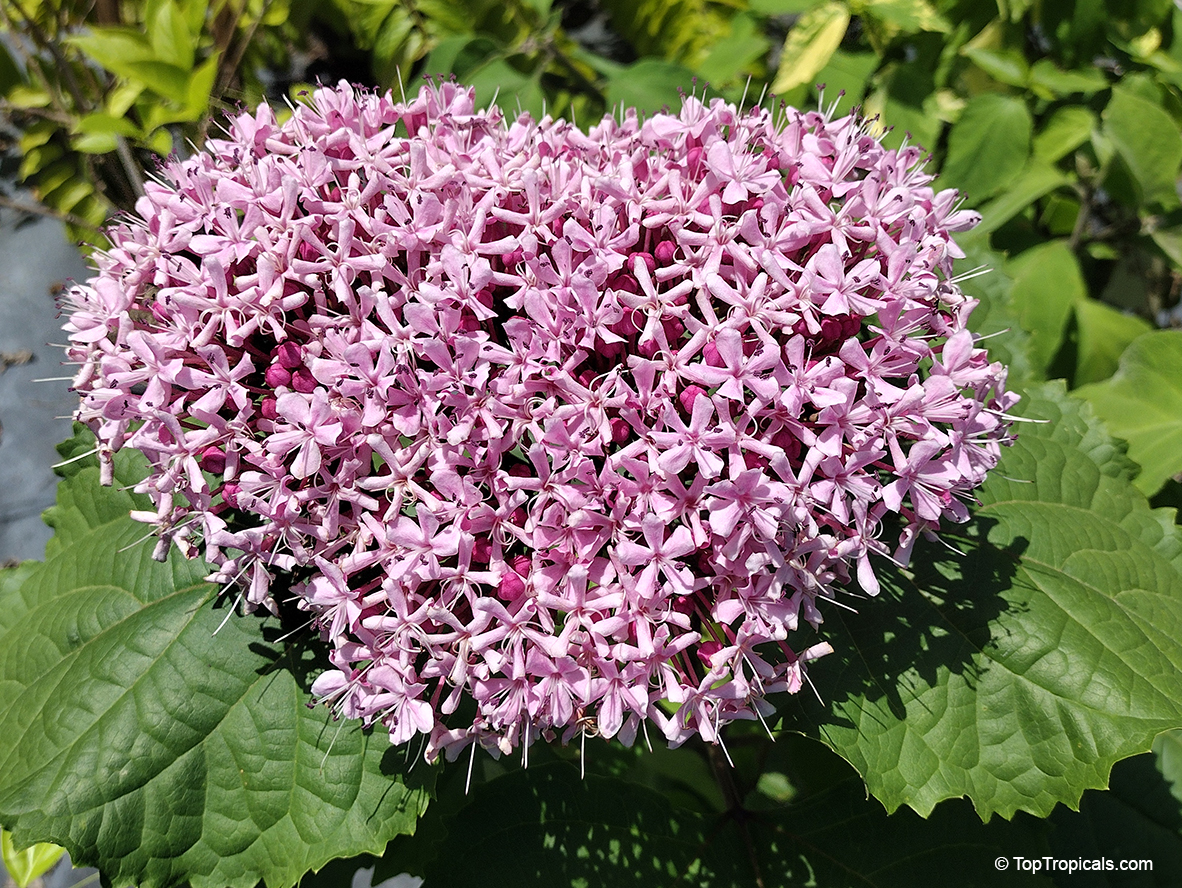
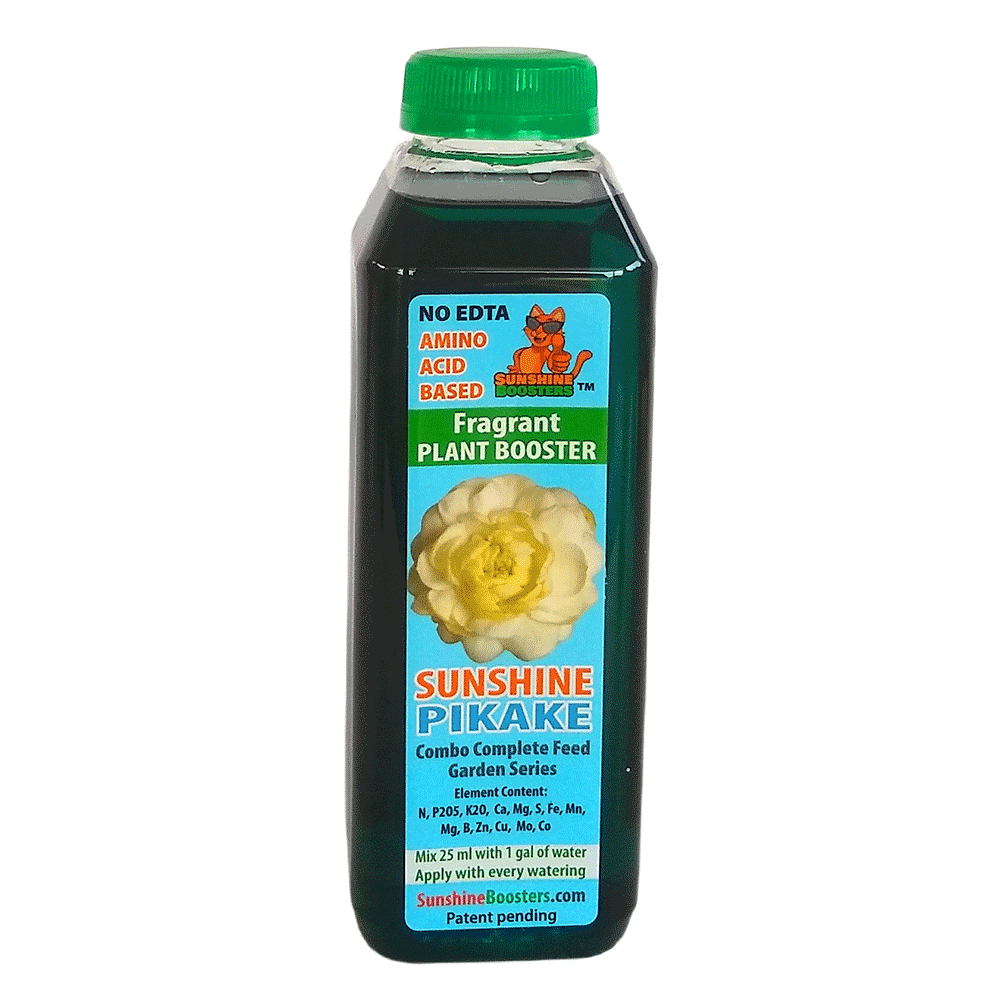 SUNSHINE Pikake (NPK 2-2-4) - eco-friendly concentrated nutrition booster for fragrant flowers. Improves quantity and quality of flowers. Encourages profuse blooming. Increases flower fragrance intensity. Can be used with every watering. For best results, use in combination with
SUNSHINE Pikake (NPK 2-2-4) - eco-friendly concentrated nutrition booster for fragrant flowers. Improves quantity and quality of flowers. Encourages profuse blooming. Increases flower fragrance intensity. Can be used with every watering. For best results, use in combination with 